

CONSERVATION AND THE ENVIRONMENT IN NAMIBIA





824,268 km²
21 March 1990 INDEPENDENCE:
CURRENT PRESIDENT: Nangolo Mbumba
Multiparty parliament
Democratic constitution Division of power between executive, legislature and judiciary
Secular state
Christian freedom of religion
SURFACE AREA: Windhoek CAPITAL: 90%
MAIN PRIVATE SECTORS: Mining, Manufacturing, Fishing and Agriculture 46% BIGGEST EMPLOYER: Agriculture
FASTEST-GROWING SECTOR: Information Communication Industry
Diamonds, uranium, copper, lead, zinc, magnesium, cadmium, arsenic, pyrites, silver, gold, lithium minerals, dimension stones (granite, marble, blue sodalite) and many semiprecious stones
CURRENCY:
The
is
and on par
Foreign currency, international Visa, MasterCard, American Express and Diners Club credit cards are accepted.
TAX AND CUSTOMS
ROADS:
NATURE RESERVES: of surface area
HIGHEST MOUNTAIN: Brandberg
OTHER PROMINENT MOUNTAINS: vegetation zones
Spitzkoppe, Moltkeblick, Gamsberg
PERENNIAL RIVERS: Orange, Kunene, Okavango, Zambezi and Kwando/Linyanti/Chobe
EPHEMERAL RIVERS: Numerous, including Fish, Kuiseb, Swakop and Ugab
20% 14 400 680
species of trees
ENDEMIC plant species 120+
species of lichen
LIVING FOSSIL PLANT: Welwitschia mirabilis
BIG GAME: Elephant, lion, rhino, buffalo, cheetah, leopard, giraffe
20 antelope species
250 mammal species (14 endemic)
256 699
50 reptile species
ENDEMIC BIRDS including Herero Chat, Rockrunner, Damara Tern, Monteiro’s Hornbill and Dune Lark frog species 15%
All goods and services are priced to include value-added tax of 15%. Visitors may reclaim VAT.
ENQUIRIES: Namibia Revenue Agency (NamRA) Tel (+264) 61 209 2259 in Windhoek
Public transport is NOT available to all tourist destinations in Namibia.
There are bus services from Windhoek to Swakopmund as well as Cape Town/Johannesburg/Vic Falls.
Namibia’s main railway line runs from the South African border, connecting Windhoek to Swakopmund in the west and Tsumeb in the north.
There is an extensive network of international and regional flights from Windhoek and domestic charters to all destinations.
HARBOURS: Walvis Bay, Lüderitz
MAIN AIRPORTS: Hosea Kutako International Airport, Eros Airport RAIL NETWORK:
6.2 telephone lines per 100 inhabitants
MOBILE COMMUNICATION SYSTEM:
Direct-dialling facilities to 221 countries
0.4182 medical doctor per 1,000 people privately run hospitals in Windhoek with intensive-care units
4
Medical practitioners (world standard) 24-hour medical emergency services
3.1 million DENSITY: 3.8 per km²
461 000 inhabitants in Windhoek (15% of total)
EDUCATIONAL INSTITUTIONS: over 1,900 schools, various vocational and tertiary institutions bird species
Most tap water is purified and safe to drink. Visitors should exercise caution in rural areas. GMT + 2 hours
220 volts AC, 50hz, with outlets for round three-pin type plugs
FOREIGN
More than 50 countries have Namibian consular or embassy representation in Windhoek.

PUBLISHING EDITORS
Elzanne McCulloch elzanne@venture.com.na
Gail Thomson gailsfelines@gmail.com
PRODUCTION & LAYOUT
Liza Lottering liza@venture.com.na
CUSTOMER SERVICE
Bonn Nortjé bonn@venture.com.na
PRINTERS
John Meinert Printing, Windhoek
The editorial content of Conservation and the Environment in Namibia is contributed by the Namibia Chamber of Environment, freelance journalists, employees of the Namibian Ministry of Environment, Forestry and Tourism (MEFT) and NGOs. It does not necessarily reflect the opinions or policies held by MEFT or the publisher. No part of the magazine may be reproduced without written permission from the publisher.



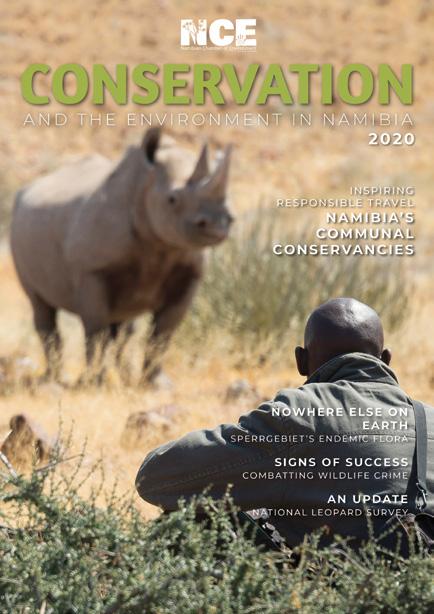






That’s our mantra at Venture Media. Sharing stories, information and inspiration to an audience that understand and value why certain things matter. Why conservation, tourism, people & communities, businesses and ethics matter.
How these elements interrelate and how we can bring about change, contribute to the world and support each other. Whether for an entire nation, an industry, a community, or even just an individual.
We find, explore, discover, teach, showcase and share stories that matter.
www.venture.com.na or email us at info@venture.com.na for a curated proposal.
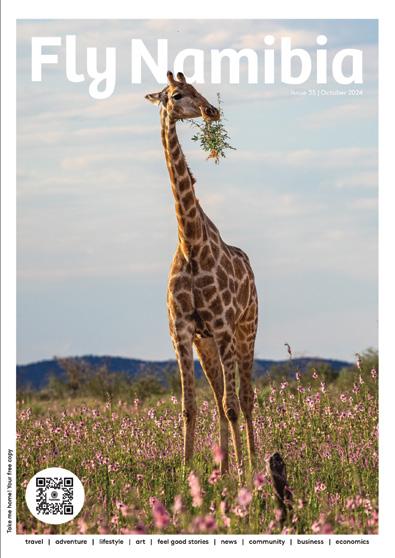




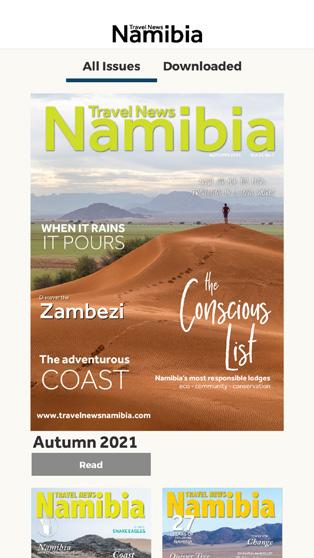

In 2021, we're focussing on telling and sharing STORIES THAT MATTER acros riou tal p urney and share your s wi ders ertain things matter

tion communities matter
w t elat ng about change, ute ppor er for an entire nation mun dividual


As we usher in another edition of Conservation and the Environment in Namibia, I am once again reminded of the unwavering dedication that permeates our nation’s conservation efforts. This magazine, with its array of stories, not only showcases our achievements but also highlights the challenges we face in safeguarding our natural heritage. Namibia, a country blessed with a rich and diverse ecosystem, continues to set an example of how conservation can be intertwined with sustainable development.
In this issue, we explore and celebrate innovation, such as the Nyae Nyae Pangolin Project, which is working tirelessly to protect one of the most trafficked species in the world. The importance of such initiatives cannot be overstated, as they provide a blueprint for tackling the global wildlife trafficking crisis. From community rangers to advanced tracking technologies, Namibia is at the forefront of conservation strategies that prioritise both people and wildlife.
Additionally, the feature on the Greater Etosha Carnivore Programme emphasises our commitment to preserving the delicate balance of predator and prey in one of Africa’s most iconic landscapes. These efforts are not without their hurdles, as climate change, humanwildlife conflict, and habitat encroachment continue to pose significant threats. Yet, despite these challenges, Namibia’s conservationists remain resilient, driven by the knowledge that the success of these programs extends far beyond our borders.
Each time I read a story about Namibia’s bush encroachment management programmes, I am left in awe of the creative ways we can turn problems into opportunities. The article in this issue offers another innovative approach and exemplifies how we can harness the power of nature to restore our landscapes and boost our economy through sustainable practices.
As we reflect on these stories, it becomes clear that conservation is not just about protecting species – it’s about creating a future where people and nature thrive together. Namibia’s conservation model, rooted in community-based natural resource management and sustainable use, is a testament to the power of collaboration. It’s a model that reminds us that the greatest solutions often come from within, fueled by the passion and commitment of our people.
To our readers and contributors, thank you for your continued support in amplifying these stories that matter. Together, we are ensuring that Namibia’s conservation legacy continues to shine brightly.
Yours in conservation,

Elzanne McCulloch

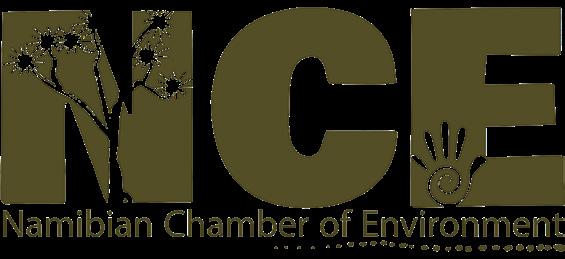
The Namibian Chamber of Environment (NCE) is a membership-based and -driven umbrella organisation established as a voluntary association under Namibian Common Law to support and promote the interests of the environmental NGO sector and its work. The Members constitute the Council – the highest decision-making organ of the NCE. The Council elects Members to the Executive Committee at an AGM to oversee and give strategic direction to the work of the NCE Secretariat. The Secretariat (staff) of the NCE comprise a CEO and Office Manager. Only the Office Manager is employed full-time. The NCE currently has 65 Full Members – Namibian registered NGOs whose main business, or a significant portion of whose business, comprises involvement in and promotion of environmental matters in Namibia; and 13 Associate Members – individuals running environmental programmes and non-Namibian NGOs likewise involved in local to national environmental matters in Namibia. A list of Members follows. For more information on each Member, their contact details and website link, please go to the NCE website at www.n-c-e.org/members.

THE NCE HAS FOUR ASPIRATIONAL OBJECTIVES AND FIVE OPERATIONAL OBJECTIVES AS FOLLOWS:
Aspirational Objectives
• Conserve the natural environment
• Protect indigenous biodiversity and endangered species
• Promote best environmental practices
• Support efforts to prevent and reduce environmental degradation and pollution
Operational Objectives
• Represent the environmental interests of Members
• Act as a consultative forum for Members
• Engage with policy- and lawmakers to improve environmental policy and its implementation
• Build environmental skills in young Namibians
• Support and advise Members on environmental matters and facilitate access to environmental information
The NCE espouses the following key values:
• To uphold the fundamental rights and freedoms entrenched in Namibia’s Constitution and laws, including the principles of sustainable use, protection of biodiversity and inter-generational equity;
• To promote compliance with, uphold and share environmental best practice, recognising that the Earth’s resources are finite, and that human health and wellbeing are inextricably linked to environmental health;
• To recognise that environmental best practice is best promoted by implementing the following seven principles: sustainability, polluter pays, precautionary, equity, effectiveness and efficiency, human rights and participation;
• To develop skills, expertise and passion in young Namibians on environmental issues;
• To ensure political and ideological neutrality, be evidence-based and counter fake information; and
• To promote inclusiveness and to fiercely and fearlessly reject any form of discrimination.
TO EFFECTIVELY IMPLEMENT THESE OBJECTIVES AND VALUES, THE NCE HAS DEVELOPED EIGHT STRATEGIC PROGRAMME AREAS:
1. Support to Members
The NCE provides office facilities, boardroom, internet and safe parking for its out-of-town Members when in Windhoek; in partnership with Westair, a Cessna 182 for conservation purposes such as aerial surveys, radio-tracking and anti-poaching work; three 4x4 Toyota Hilux double-cab vehicles for use by Members for their conservation work; registration and research permit facilitation; and any other support requested by Members.
2. National facilitation
The NCE organises symposia and workshops on topical and priority issues; supports the development of strategic Best Practice Guides at sector level, the first on mining, the second (in preparation) on hunting; reviews policy and legislation on and/or impacting Namibia’s environment; facilitates collaboration on conservation assessments and action plans, the latest being Namibia’s Carnivore Red Data Book (http:// the-eis.com/elibrary/search/27193); and representing the sector and Members on national bodies.
3. Environmental information
The NCE hosts and supports the development of Namibia’s Environmental Information Service (EIS at www.the-eis.com) in partnership with Paratus Telecom, a one-stop-shop for all environmental information on Namibia. The EIS comprises an e-library with over 28,000 reports, publications, maps, data sets, theses, etc., which are searchable and down-loadable. Included are all Environmental Impact Assessment

(EIA) reports since 2020 (over 4,500), almost 800 wildlife survey reports and counts some going back to 1926, and wildlife crime reports (over 4,500). It provides an Atlasing platform for citizen science data collection that currently covers mammals, reptiles, amphibians, butterflies, plants (both indigenous and invasive alien) and archaeology, and records are conveniently entered via a free cell phone App.
The NCE has also established a free, open access scientific e-journal – Namibian Journal of Environment – now in its seventh year (www. nje.org.na). The NCE and Venture Media’s environmental website “Conservation Namibia” (www.conservationnamibia.com) tells Namibia’s conservation stories via blogs, factsheets, video and articles from this magazine. The NCE informs the public on topical environmental issues on its website (www.n-c-e.org), Facebook page, X (Twitter) feed and LinkedIN profile. The Namibian Environment and Wildlife Society (NEWS) with support from the NCE recently launched a new tool to help stakeholders and the public better engage with EIAs – the EIA Tracker (https://eia-tracker.org.na/), a transparent, user-friendly system that presents and maintains information on all development projects that require EIAs, with a current database of 1,437 proposed and existing projects.
4. Environmental advocacy
The NCE addresses national threats to Namibia’s environment and natural resources by first attempting to work constructively with the relevant government or other entity but, if necessary, through public exposure. The NCE has addressed the issue of Chinese incentivised poaching and illegal trade in specially protected wildlife, the overfishing of pilchards in Namibian waters, illegal and unsustainable timber harvesting and export, and the need to reduce and eliminate single-use plastic from Namibia’s environment. It recently published a position paper on the proposed hydrogen developments for the Tsau ||Khaeb (Sperrgebiet) National Park, explaining that this product is correctly termed red hydrogen due to the major potential impacts on biodiversity (https://n-c-e.org/wp-content/uploads/Green-hydrogen-Tsau-KhaebNational-Park-NCE-Position-Paper.pdf).
It has also initiated a highly successful pangolin reward scheme in partnership with MEFT, some NCE Members and communities. The scheme rewards people for providing information on pangolin trafficking leading to arrests – more than 300 criminal cases opened and over 500 people arrested and charged.
5. Environmental policy research
When we talk about the “environment” we mean the interrelationship of ecological, social and economic aspects – essentially sustainable development. This is appropriate for a country with an economy reliant mainly on natural resource-based primary production where ecological and socio-economic issues are two sides of the same coin. However, this conceptual approach is rarely understood by people from western industrialised countries who think of environment as being just the green environment. To get around this problem, the NCE has established a socio-economic / livelihoods component that works seamlessly with the environmental component and focusses mainly on the urban environment. Over 50% of Namibians now live in towns and the city of Windhoek, with a projected rise to 70% by 2030. The priority areas of focus are access to affordable urban land for housing, appropriate sanitation, solid waste management, energy and research on the economics of poverty.
6. Young Namibian training and mentorship
Over the past seven academic years (2018-2024) the NCE in partnership with Woodtiger Fund has provided 226 post-graduate bursaries in the broad environmental field (including subjects such as biodiversity conservation, natural resources management, wildlife and tourism management, sustainable agriculture, water, forestry and fisheries
management, climate change mitigation and adaptation, renewable energy, data and spatial science, risk and change management, leadership, through to environmental economics, environmental law, environmental engineering) and 52 internships, mainly for NCE bursaryholders, that involves close mentoring by experienced environmental professionals. The aim is to build the capacity and confidence of young Namibians to become the environmental leaders of tomorrow. In 2024, NCE supported the establishment of the Namibian Youth Chamber of Environment, which seeks to inspire and equip young (18-35 years) Namibians with the confidence and skills to advocate for the environment during their studies, within their communities and in their professional settings. Current membership stands at 112 individuals and two youth organisations.
7. Fund raising
Core funding for the NCE is currently provided by B2Gold. This means that all additional funding received is invested directly into
A. Speiser Environmental Consultants cc African Conservation Services cc Africat Foundation
Ashby Associates cc
Biodiversity Research Centre, NUST (BRC-NUST)
Botanical Society of Namibia
Brown Hyena Research Project Trust Fund
Bwabwata Living Museum
Cheetah Conservation Fund (CCF)
Canyon Nature Trust
Conservancy Association of Namibia (CANAM)
Desert Lion Conservation Trust
Development Workshop Namibia (DW-N)
Earthlife Namibia
Eco Awards Namibia
Eco-logic Environmental Management Consultancy cc EduVentures
Elephant Human Relations Aid (EHRA)
Environmental Assessment Professionals Association of Namibia (EAPAN)
Environmental Compliance Consulting (ECC) EnviroScience
Felines Communication and Conservation Consultants cc Giraffe Conservation Foundation (GCF)
Gobabeb Research and Training Centre
Greenspace
Integrated Rural Development and Nature Conservation (IRDNC)
JARO Consultancy
Kwando Carnivore Project
LM Environmental Consultants
Museums Association of Namibia
N/a’an ku sê Foundation
Namib Desert Environmental Education Trust (NaDEET)
Namibia Biomass Industry Group (N-BiG)
Namibia Bird Club
Namibian Beekeeping Association
Namibia Nature Foundation (NNF)
Namibia Professional Hunting Association (NAPHA)
Namibia Scientific Society
Namibia Archaeological Trust
Namibian Association of CBNRM Support Organisations (NACSO)
environmental projects and programmes – there are no overhead costs. The NCE focuses on corporate support and avoids targeting funding sources that may compete with its Members. The corporate sector assists with fund raising by approaching their clients, partners and networks. Our main sponsors are shown on the back cover.
8. Grants making
Funds raised by the NCE are used strategically to support priority environmental projects and programmes in Namibia. Emphasis is placed on legacy initiatives that have tangible outcomes. These are often based on national policy and bring together government and NGO partners, communities and the private sector, and frequently lead to investments by larger bilateral or multi-lateral funding organisations. An on-line grant application process allows NCE Members to apply for funding. To date 212 grants have been awarded, to the value of just under N$ 30 million, with 90% going to NCE Members. Some of these projects are showcased in this magazine.
Namibian Environment and Wildlife Society (NEWS)
Namibian Hydrogeological Association
NamibRand Nature Reserve
Nyae Nyae Development Foundation of Namibia (NNDFN)
Ocean Conservation Namibia
Omba Arts Trust
Ongava Game Reserve / Research Centre
Orange River-Karoo Conservation Area (ORKCA)
Otjikoto Trust
Pangolin Conservation and Research Foundation
ProNamib Nature Reserve
Progress Namibia TAS cc
Rare and Endangered Species Trust (REST)
Research and Information Services of Namibia (RAISON)
Rooikat Trust
Save The Rhino Trust (SRT)
Scientific Society Swakopmund
Seeis Conservancy
SLR Environmental Consulting
Southern African Institute of Environmental Assessment (SAIEA)
SunCycles Namibia
Sustainable Solutions Trust
Tourism Supporting Conservation Trust (TOSCO)
Twin Hills Trust
Venture Media
ASSOCIATE MEMBERS
Bell, Maria A
Black-footed Cat Research Project Namibia
Bockmühl, Frank
Desert Elephant Conservation
Irish, Dr John
Kolberg, Herta
Leibniz Institute for Zoo and Wildlife Research
Lukubwe, Dr Michael S
Namibia Animal Rehabilitation, Research and Education Centre (NARREC)
Seabirds and Marine Ecosystems Programme
Sea Search Research and Conservation (Namibia Dolphin Project)
Strohbach, Dr Ben
Wild Bird Rescue

As we write this, some 23,000 people from nearly every country on earth are meeting in Cali, Columbia to discuss the conservation of biological diversity. Biodiversity, as it is better known, encompasses all life forms on this planet we call home and which we have a responsibility to conserve. It is therefore particularly fitting to introduce the most biodiverse edition of Conservation and the Environment in Namibia that we have produced to date.
Of all the plants and animals found naturally in Namibia (known as indigenous) the ones that are found only here and nowhere else – endemic species – represent the country’s special contribution to global biodiversity. Turn to p.26 and p.32 to find a tantalising sample of these species and the ‘near-endemics’, which Namibia shares with South Africa or Angola.
Worryingly, some of Namibia’s most interesting endemic and near-endemic plants are threatened by plant poachers (p.38) that mainly collect these species to sell to people who want them in their gardens, perhaps without realising that their hobby threatens these plants in the wild. On p.58, Helge Denker zooms out to consider Namibia’s fight against wildlife crime more broadly, which remains a critical national challenge.
Another national challenge for biodiversity is the prevalence of fencing that criss-crosses freehold land. While Peter Cunningham looks at the impacts that relatively low livestock fences have on springbok (p.54), fencing that is high enough to keep jumping antelope from crossing is an even greater threat – especially if electrified. The ability of wildlife to move in response to changing climatic conditions in arid and semi-arid ecosystems is their most important behavioural survival mechanism. The freehold conservancy concept, which was initially supported by government, provides a potential solution to this problem by encouraging landowners to drop some of their game-proof fences (see p.18).
Namibia’s communal conservancies continue to enjoy national and international support for their role in supporting sustainable rural livelihoods by managing their biodiversity. Find out more about a new four-year project to support multiple conservancies that create a ‘bridge’ between Etosha and Skeleton Coast National Parks on p.12. Conservancies in this hyper-arid north-western part of the country also play a key role in connecting lion populations across this landscape (see p.44). Meanwhile, 12 conservancies and a community association on the north-eastern side of the country have benefitted from the multi-pronged, collaborative Sustainable Wildlife Management Programme (p.68).
The state of our biodiversity is not only the concern of a few trained conservation scientists – every Namibian citizen should be concerned about how the environment is managed and be acquainted with related government policies and processes. Most appropriately for an election year, you will discover that democracy and the environment can indeed go hand-in-hand on p.64. The system for Environmental Impact Assessments is supposed to allow the public to exercise their democratic rights to comment on new development projects, but as you will find on p.22, this system is broken.
The connection between human well-being and biodiversity conservation is most clearly evident in the matter of health. The rabies virus is deadly to humans and animals, posing a particular threat to domestic and wild cats and dogs. Rabies vaccination programmes, such as that described on p.50, are critical for tackling this disease and protecting humans and animals.
Finally, we invite you to reflect on the passage of time with the beautiful stamps on pp.74-75 that depict Namibia’s natural beauty. With the rise of email and instant messaging, using and collecting stamps is becoming a thing of the past. Before you get too melancholic, turn to the final page of this year’s edition to read about the future. We are excited to support the Namibian Youth Chamber of Environment, a dynamic group of students, young professionals and job seekers who are eager to take up the baton of biodiversity conservation to secure their future.
Yours in Conservation,
Chris Brown and Gail Thomson
By



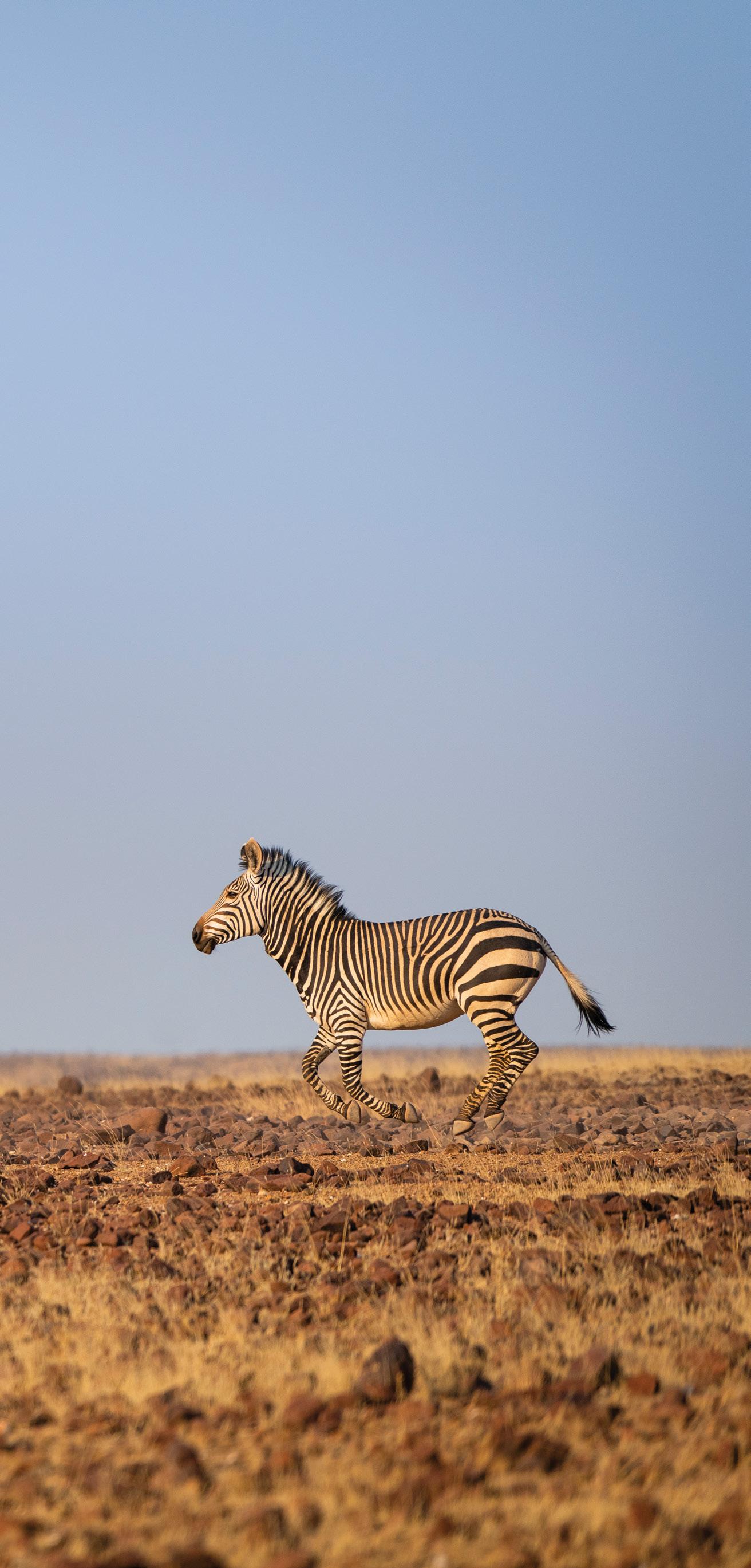
The 55,299 square kilometres of land between the Etosha and Skeleton Coast national parks are renowned for unique biodiversity and an exceptionally high species variety. This part of the country is highly vulnerable to climate change, however. It is also home to people who have lived alongside wildlife for untold centuries. They were among the pioneers in community conservation and established some of the first communal conservancies in Namibia.
Fourteen of these communal conservancies form a ‘bridge’ between the two national parks by creating space for wildlife and thus generating socioeconomic benefits for the people living on this land. The newer concept of People’s Parks allows conservancies to create formal protected areas on their lands by joining areas that are zoned for wildlife while retaining their rights to that land and the benefits it generates. Although these conservancies are well-established (some are nearly 30 years old), they continue to face challenges that require external support and partnerships to overcome.
The Legacy Landscapes Fund (LLF), which aims to provide long-term support for nature, climate and people, has come at an ideal time for the conservancies. This global fund was established in response to a critical realisation among policymakers: traditional short-term project approaches of 3-5 years have proven inadequate in addressing the urgent needs of global conservation. Recognising that the challenge of biodiversity loss is too vast and complex for any single sector to tackle alone, LLF was created to forge a powerful partnership between public and private sector actors with a unified and sustainable framework for long-term conservation efforts.
LLF was established in late 2020 by the German Ministry for Economic Cooperation and Development as an independent charitable foundation under German law, designed to guarantee long-term conservation funding for nature, climate and people. Four years later, LLF provides long-term funding for the protection of areas in 15 countries across 4 continents, covering more than 473,000 square kilometres. This includes the Skeleton Coast Etosha Conservation Bridge in Namibia.
John Kasaona, CEO of Integrated Rural Development and Nature Conservation (IRDNC), an LLF implementing partner, says, “The Legacy Landscapes Fund provides vital support to elevate the existing conservation efforts to new heights. The long-term goal is to enhance conservation efforts and support the upliftment of rural communities. The changing climate requires rural residents to participate in climate-resilient activities. Additionally, landscape-level connectivity will be crucial for the future, as individual conservancy areas may not have a significant impact on species abundance. This presents a new opportunity for nature-based development, which will ultimately benefit the local people.”
Dr Juliane Zeidler, Country Director of World Wildlife Fund (WWF) Namibia, adds, “Respect for indigenous people and local communities is at the core of WWF’s inclusive conservation approach and it is embedded in the fabric of LLF. Environmental and social safeguards are applied throughout consultation, development and implementation processes, and there is a secure mechanism for sharing grievances with the confidence that they will be handled with honesty and respect.” Namibia’s WWF office is the first in the WWF network to become a partner in LLF.
The vision for the Skeleton Coast Etosha Conservation Bridge is ambitious: To ensure a connected, resilient, economically viable conservation landscape for people and nature that restores and maintains landscape connectivity and generates conservation and improved socio-economic development.
This statement reflects the will of the local people. "For me, I was born here, grew up here, I know the living standard of the people. LLF inspires me because I know it will bring changes to the people of these conservancies. The child of my child’s child will be better off
than we used to be,” says Siegfried Muzuma, the Chairperson of the Ehrivopuka Conservancy.
A great deal of demanding work will be needed to bring this wish for the future to fruition. Partners in government, WWF Namibia and IRDNC, other national non-government organisations (NGOs) and rural communities are working together to achieve results in three defined thematic areas: good governance and management, improved livelihoods, resilience, health and education, and to secure healthy habitats and connectivity.
At a recent meeting with the LLF technical team, Bennett Kahuure, Director of Parks for the Ministry of Environment, Forestry and Tourism (MEFT), emphasised, “Livelihoods are especially important to us, as are human rights. The government supports the LLF, which will help us continue to upscale and improve the delivery of our work.”
Conservation challenges in this landscape include climate change and aridification, alien invasive plants, pressure on small populations of rare species from wildlife crime, human-wildlife conflict, abandoned small mines and the risk of encroachment from unsustainable development including mining and tourism operations. There has also been a sharp decline in wildlife numbers, due at least in part to the prolonged drought.
WWF and IRDNC are approaching these challenges methodically with projects designed for long-term impact. Pauline Lindeque, Wildlife and Landscapes Programme Director for WWF Namibia, explains, “The LLF grant provides one million USD per year. The plan which WWF developed with IRDNC and MEFT is designed to focus on specific activities in targeted areas, to achieve the set objectives in those areas and then allocate resources to address new challenges





or pursue additional opportunities, ultimately promoting progressive self-sufficiency”.
For example, remnants of old mining operations will be cleared from Skeleton Coast National Park and discrete barriers will be established to protect lichen fields in Dorob National Park. Another example is providing support for the emerging Ombonde and Hoanib People’s Parks, making it possible for the communities to charge entry fees, hire game guards and build tourism infrastructure that will increase their long-term income.
One of the programme’s research priorities is to understand the dynamics of wildlife populations in hyper-arid north-western Namibia for improved post-drought recovery, while maximising livelihood benefits. A collaborative project involving WWF, the Namibia University of Science and Technology (NUST), MEFT and St. Andrews University – supported by the UK government’s programme Reversing Environmental Degradation in Africa and Asia (REDAA) – is designed to answer questions relating to the current drought and low wildlife numbers.
During the early years of community conservation in this region, wildlife populations recovered dramatically, allowing communities to begin building a thriving wildlife-based economy. However, prolonged drought has caused wildlife (and livestock) numbers to crash over the last decade. People have lost their food supply, and while the embryonic tourism side of the wildlife economy survived despite the devastating impact of COVID-19, it has been seriously weakened. For full socioeconomic recovery, wildlife populations need to recover.
Over the next four years, researchers and stakeholders will work together to:
• Collate data collected by communities and researchers to identify wildlife corridors and dispersal zones and identify obstacles to those.
• Develop a strategy for the restoration of habitats and wildlife within the landscape (including possible reintroduction of key
species once land-use and governance structures are in place and the drought has broken).
• Explore Payment for Ecosystem Services (PES) models (wildlife, biodiversity and carbon credits) as mechanisms to secure the protection of key habitats.
• Identify and facilitate joint venture biodiversity economy partnerships for socio-economic development.
By understanding the social, environmental and spatial dynamics that have led to wildlife and habitat decline, actions can be taken to reverse the trends and enhance climate resilience, thus improving livelihoods and conservation outcomes.
“In my opinion, LLF's support arrived at a critical moment when the future of Community-Based Natural Resource Management (CBNRM) was uncertain. We are grateful for LLF's generous commitment, and we are confident that it will help us change the conservation landscape going forward, ultimately improving the lives of the local community members”, John Kasaona says.
It will take time to achieve these goals, which is why the longterm focus of the Legacy Landscapes Fund is so well suited to the conservation and economic needs of this landscape. Funding for the Skeleton Coast Etosha Conservation Bridge will be in place for 50 or more years, allowing us to plan with care, act with a common purpose and achieve a better future for all.
Acknowledgment: We are grateful to the Rob Walton Foundation for providing the matching funding to LLF, to make this conservation effort possible.


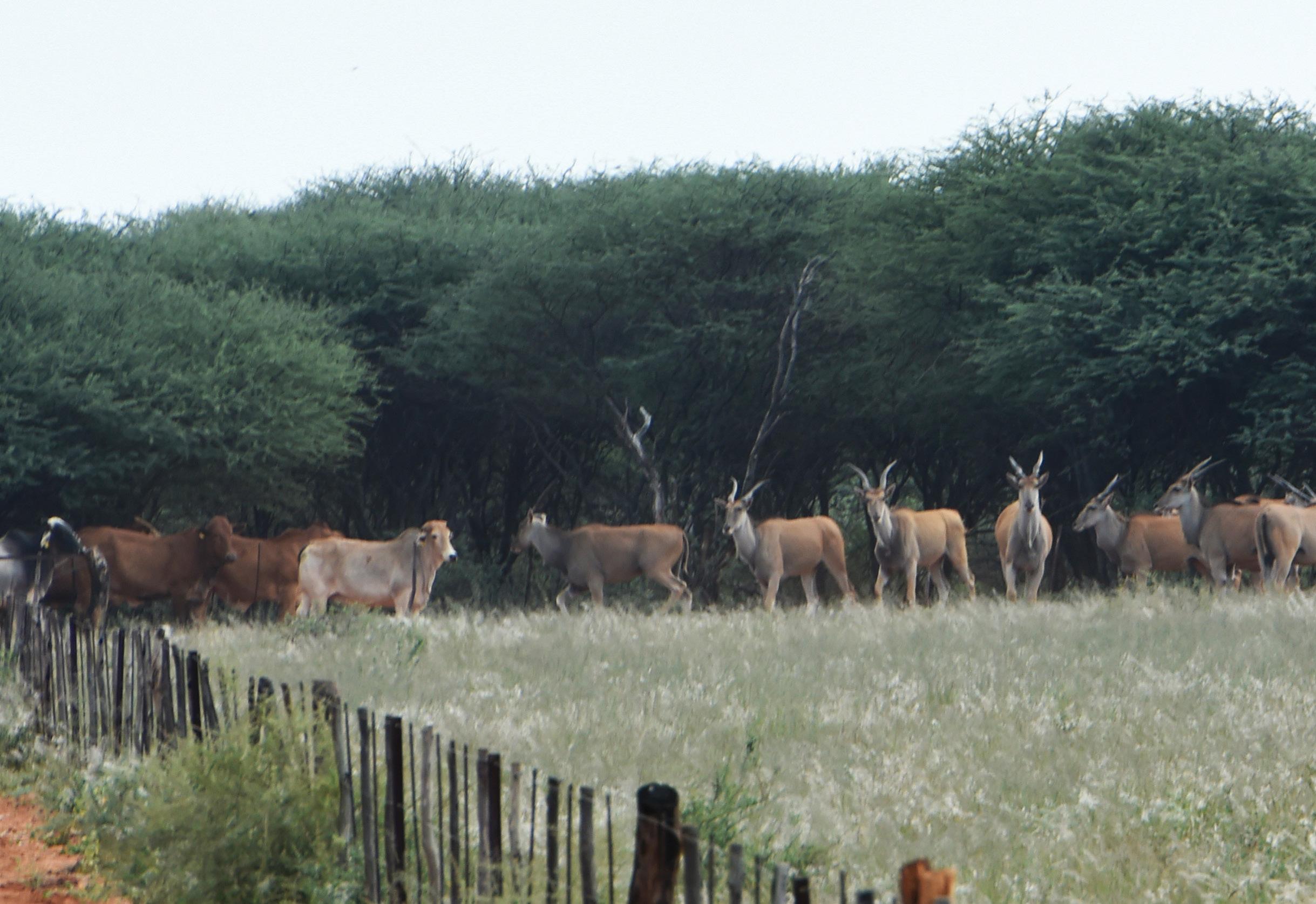
A neglected part of Namibia’s conservation story
By CANAM executive committee with Jan Hennings, Jürgen Rumpf, Thomas Peltzer, Gudrun Heger and Tim Hofmann
Namibia’s freehold farmlands host 80% of the country’s wildlife. This is the result of forwardthinking policies implemented during the 1960s and 70s that allowed for private ownership over wild animals. Freehold farmers would nonetheless be able to contribute much more to national conservation efforts and global targets if their conservancies were fully supported and incentivised by the government.

While many people are aware of the history and role of communal conservancies in Namibia, fewer know about the conservancy movement on freehold farms that started with the establishment of Ngarangombe Conservancy in 1991. Prior to this, freehold farmers started conserving wildlife on their farms in response to the Nature Conservation Ordinances of 1967 and 1975 that granted landowners the right to own and use the wildlife on their land for economic purposes.
As game numbers increased because game was now valued for trophy hunting, live sales, meat and photographic tourism, increasing numbers of landowners constructed game-proof fences to keep wildlife on their land. This cut off the migration routes of large herds of plains game, which then required more intensive game ranching to maintain their population sizes in an ecologically sustainable manner.
Understanding the long-term ecological issues that the fragmentation of land would have for wildlife, some freehold farmers considered joining their farms together and managing their wildlife cooperatively. This notion was strongly supported by farsighted government officials in the early 1990s, who visited farmers associations throughout the country and enabled the establishment of the first conservancies.
Five years before legislation was passed to allow conservancies on communal lands, these first freehold conservancies were trailblazers. They defined a conservancy as “A legally protected area of a group of bona fide land-occupiers practising co-operative management based on a sustainable utilisation strategy, promoting conservation of natural resources and wildlife while striving to
reinstate the original biodiversity with the basic goal of sharing resources amongst all members”. This definition extended to people living on communal lands, which were yet to receive the legal right to establish their own conservancies.
Whether on freehold or communal land, conservancies are voluntary associations that are led by people living within these communities who wish to conserve and use their wildlife sustainably. Conservancies represent a mosaic of Namibia's diverse landscapes, from the arid deserts to lush river valleys, each with their unique challenges and opportunities.
By 1996, the number of freehold conservancies had grown substantially, creating a need for greater coordination and a unified voice to address cross-cutting challenges and cooperation with what was then the Ministry of Environment and Tourism (MET). The Conservancies Association of Namibia (CANAM) was established to meet this need. Supported by MET, CANAM aimed to represent and coordinate all conservancies across Namibia, whether in communal areas or on freehold farmland.
CANAM's objectives are multifaceted. It represents conservancies, liaises with authorities, encourages landowner participation, coordinates research, protects the environment and raises awareness both locally and internationally. Beyond these goals, CANAM embodies a spirit of cooperation and a shared commitment to conservation. During its peak, up to 25 conservancies on freehold farmland were united under CANAM.
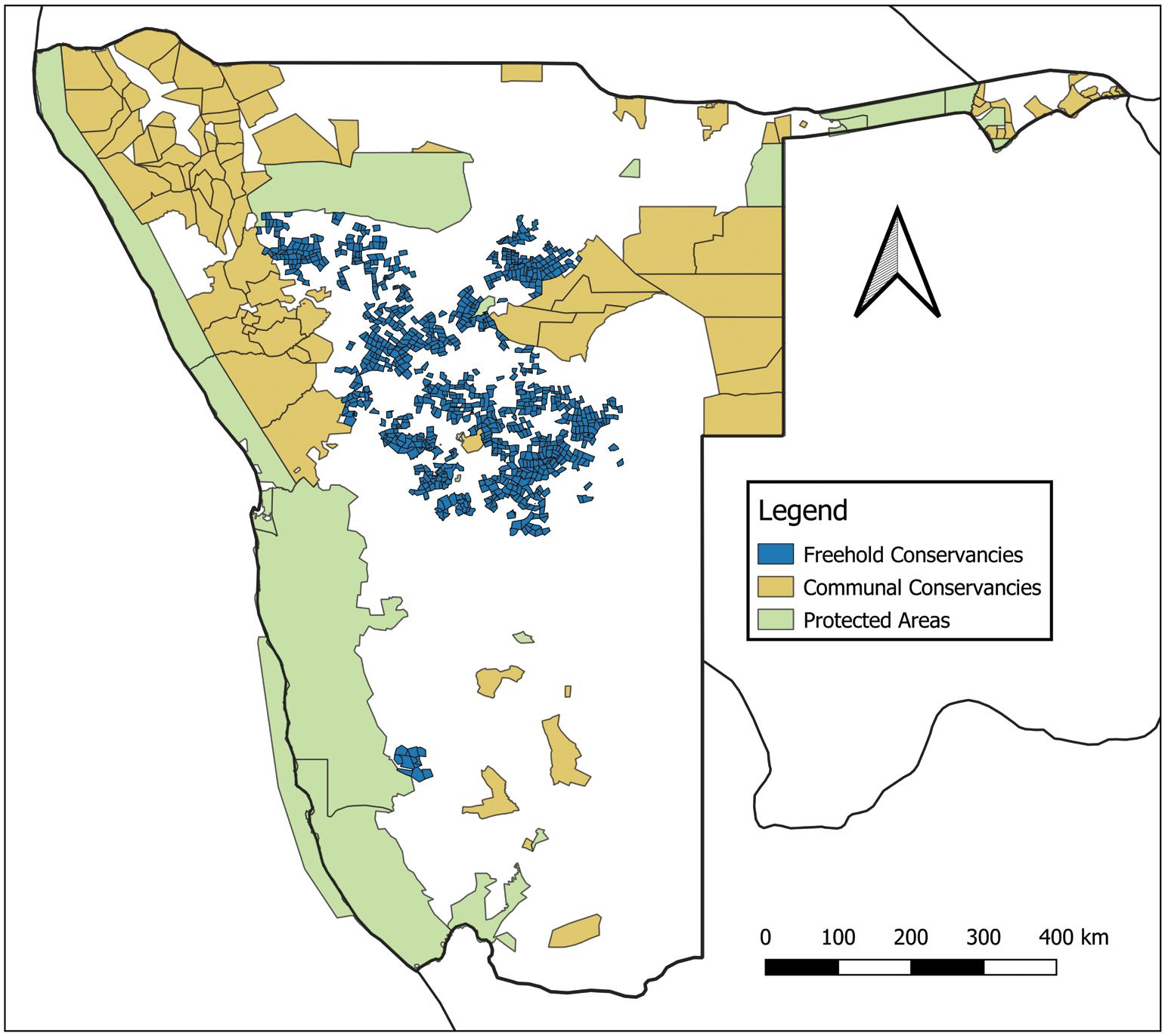
The number of freehold conservancies (blue) in 2004.

The number of freehold conservancies in 2024, including dormant ones (pale blue).
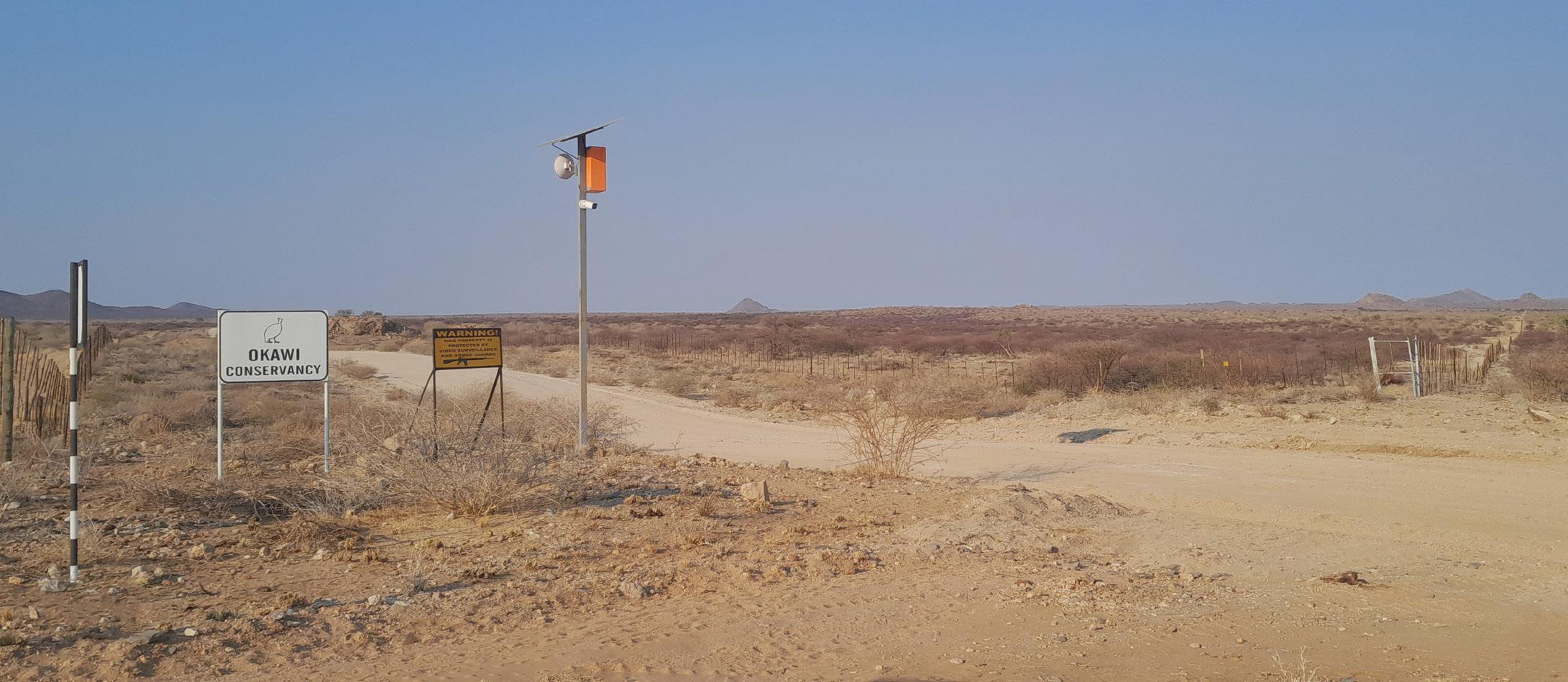
Unfortunately, because of the different legal requirements for establishing communal conservancies, they were supported and developed separately from freehold conservancies during that time. This led to limited cooperation across land use types and restricted CANAM to representing freehold conservancies only. This divide has led to declining support for freehold conservancies from government and non-governmental organisations (NGOs) over the past few decades, leading to a decline in CANAM membership and the eventual shrinkage or dissolution of many conservancies.
Freehold farmlands conserve most of the wildlife in Namibia, provide thousands of jobs and contribute to a vibrant wildlife economy. Occupying most of the central parts of the country due to historical land distribution, freehold lands could provide important links between conservancies and national parks on communal and state land. The prevalence of game fencing is a key factor limiting connectivity, which would be addressed through properly supported freehold conservancies.
Under the current Ministry of Environment, Forestry and Tourism (MEFT), freehold conservancies receive no support, in contrast to the early years. Conservancies used to enjoy greater autonomy in terms of wildlife management than individual freehold farmers, thus incentivising landowners to create conservancies. These benefits have been withdrawn, reducing the incentive for freehold farmers to participate in landscape-level conservation. The resulting decline in the number and size of freehold conservancies is detrimental both economically and ecologically, especially as Namibia faces the dual challenges of climate change and international pressure regarding the sustainable use of wildlife.
Looking beyond Namibia, freehold conservancies contribute to global conservation targets, particularly Target 3 of the Global Biodiversity Framework that aims to protect 30% of the planet's land and oceans by 2030 (known as the 30 by 30 target). Freehold conservancies already comprise vast tracts of land that support biodiversity and wildlife conservation and therefore meet the international definition of Other Effective Area-Based Conservation Measures (OECMs). They also protect
vegetation types which are not adequately protected by national parks. To make significant gains for global conservation, the Namibian government only needs to formally recognise freehold conservancies as OECMs that contribute to the global 30 by 30 target and incentivise their formation through minor policy changes. This would restore game migrations in Namibia, assist predator conservation efforts and allow for greater collaboration across land use types.
CANAM is ideally positioned to revitalise the freehold conservancy membership and create a win-win partnership between the public and the private sector. We are willing to work with MEFT to identify key policy changes that would incentivise farmers to once more establish (or revive) their conservancies and work closely with the government to achieve the joint goals of nature conservation and sustainable rural development.
CANAM continues to advocate for freehold conservancies to be rightly recognised as contributors to national and global conservation goals. The vision for the future is clear: a robust network of conservancies that support biodiversity, sustain wildlife and provide economic benefits. The story of CANAM and Namibia's freehold conservancies is one of resilience, cooperation and hope.

By John Pallett and Ndelimona IipingeNamibian Environment and Wildlife Society

In an ideal world the Environmental Impact Assessment (EIA) process would ensure that any development project in Namibia is socially just and environmentally sustainable. In reality, the whole process appears to be a boxchecking exercise that serves a wealthy and well-connected few at the expense of the majority of Namibians and our environment.
How do we know that EIAs are not working in Namibia? Our assessment is based on evidence from tracking all EIAs in Namibia since May 2023 on the EIA Tracker. The EIA Tracker logs all EIAs that are registered with the Office of the Environmental Commissioner (OEC) in the Department of Environmental Affairs (DEA) and places all the relevant information on the web for easy access – forever. If you want to check out the environmental details behind a new or existing project since May 2023, or what conditions were set in the Environmental Management Plan (EMP), the EIA Tracker can help you. Details on older projects between 2019 and May 2023 are available from Namibia’s Environmental Information Service (EIS).
Without the Tracker you can only get this information from the DEA for a short period when the EIA is active. Thereafter the DEA deliberately makes it difficult for anyone trying to find out more about an EIA. This is a significant concern, because the EMP sets out how the project should be run and what it has undertaken to do to mitigate social and environmental impacts. This information is hidden from the public. As the OEC seldom inspects projects, there is no accountability for EMPs being implemented.
Offers practical guidance in order to make the development socially just and environmentally sustainable.
Welcomes comments and concerns from Interested and Affected Parties (IAPs), which improves the outcome of an EIA.
The Environmental Assessment Practitioner (EAP) is competent and responsible, and open to information that will improve the social and environmental outcomes of the development.
The government department overseeing EIAs is efficient, and intent on achieving the best outcome from the EIA process.
BID Background Information Document
DEA Department of Environmental Affairs in the Ministry of Environment, Forestry and Tourism
EIA Environmental Impact Assessment
EAP Environmental Assessment Practitioner
ECC Environmental Clearance Certificate
EIS Environmental Information Service
EMP Environmental Management Plan
EPL Exclusive Prospecting Licence (for geological exploration)
IAP Interested and Affected Party
OEC Office of the Environmental Commissioner
A box-ticking exercise to get an Environmental Clearance Certificate (ECC).
Often hidden from public scrutiny, while public inputs are downplayed or ignored.
No qualification is required for EAPs, and young entrepreneurs see EIAs as an easy business opportunity. EAPs are eager to please the developer and willing to bend rules and cut corners to do so.
The government department overseeing EIAs is slow, opaque and unresponsive to suggestions.


The EIA Tracker provides information on every project that is applying for Environmental Clearance, based on the Background Information Document (BID) provided by the relevant Practitioner. Based on this information each project is classified as high, medium or low risk. Although any member of the public has the legal right to access any BID, our attempts to do so have been an eye-opening exercise! In many cases, EAPs unlawfully refuse to provide the BID. These same Practitioners are often associated with placing EIA adverts (another legal requirement) in obscure places, such as the tiny print of the classified ads section of a newspaper. These are deliberate measures by some EAPs to keep the EIA out of the public’s sight. The EIA Tracker has reported them to the Environmental Commissioner – with no response.
The projects we assess as high risk are those which carry significant environmental and social issues, such as large mines and dams. They require a thorough EIA, usually with specialist studies on water, biodiversity, social issues, archaeological impacts and so on. Medium-risk projects carry slightly lower risks for the environment and people, such as possible pollution and risks to water resources that are manageable with the appropriate mitigations. These more common projects include geological exploration (since every Exclusive Prospecting License, EPL, requires an ECC before it can commence activities), small mines and powerlines. Low risk projects carry generally insignificant impacts for people and the environment. Examples include rezoning in


The percentage of projects requiring EIAs in Namibia that fall into high, medium and low risk categories, based on data collected in the EIA Tracker from May 2023 to July 2024.
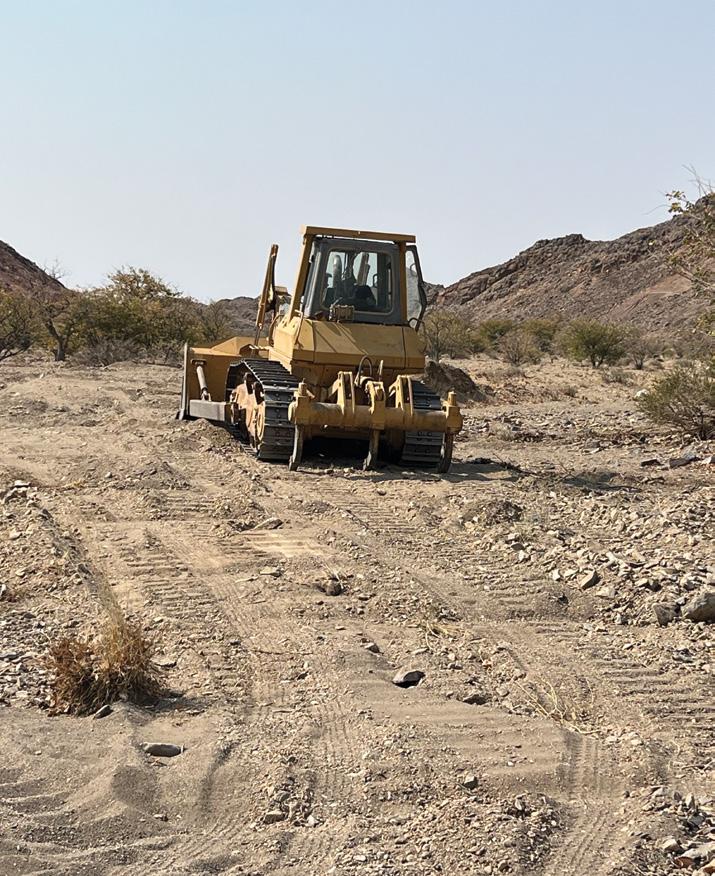

urban areas, fuel stations, small earth dams, most lodges and solar farms that are outside sensitive areas.
Of the 1,189 EIAs registered with the DEA in the 15-month period up to July 2024, 52% were low-risk projects. These relatively trivial EIAs occupy a large proportion of the DEA’s effort and time, each taking about three months from submission of the EIA to issuance of the ECC. In our opinion, this is wasted effort. They could more efficiently be handled through a simplified checklist, speeding up the process and freeing up time for more important matters, where more thorough due diligence on significant EIAs is needed.
An example of an EIA that deserved greater scrutiny and which should not have been given the go-ahead, was an EPL in a prime tourism area near Khorixas. The BID drew attention to the presence of rhinos in the area, which prompted Save the Rhino Trust and local lodge owners to raise concerns against the project. The EAP fraudulently stated that the risks to biodiversity were low. The ECC was issued despite this clear irregularity and major negative impacts, and the geological exploration project has gone ahead. This and many other similar examples reinforce the view held by many that the EIA process cannot be trusted, and that it is at best just an administrative procedure to tick the ECC box, or at worst, an area of growing concern about corruption.

An Environmental Management Plan should stipulate that oil spills be prevented. Pollution such as this is rampant, since there is little enforcement of EMPs by the regulating authority, MEFT.
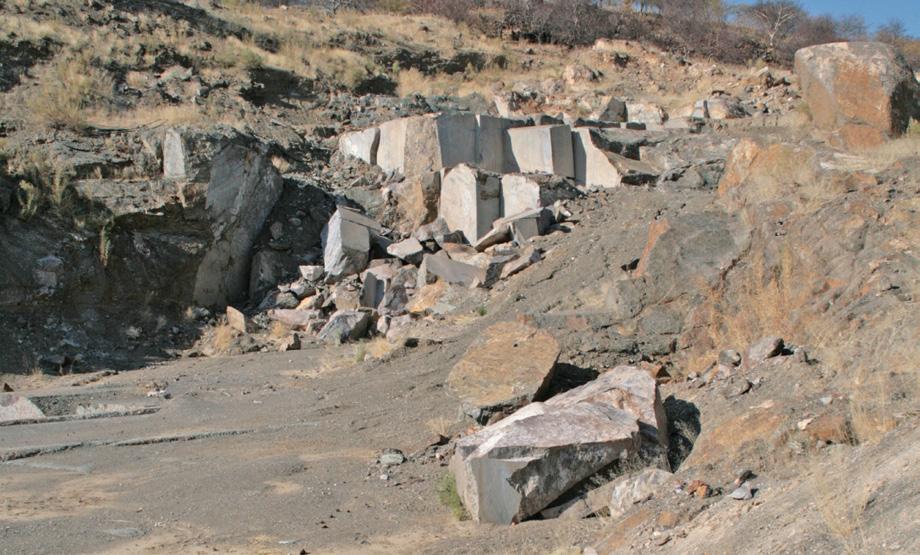
Landscape scars can be avoided through thorough rehabilitation after mining. The EIA process addresses rehabilitation, but in many cases it is ignored, and there is no enforcement of the mine’s responsibilities.

The EIA Tracker team met with the Environmental Commissioner and his senior staff to discuss these problems and made several recommendations, including the need to establish in law a professional body for EAPs, like those for earth sciences, medical and engineering professions. Such an organisation – the Environmental Assessment Practitioners Association of Namibia (EAPAN) –has been in existence for a decade as a voluntary association, but it gets little recognition and no support from the DEA. EAPAN ensures that its members have the required qualifications and experience, and abide by a strong code of professional conduct. Proponents of projects looking for professional EAP services would be advised to approach members of EAPAN.
At this stage, only half (48) of Namibia’s 93 EAPs are registered with EAPAN, and only one third (337 out of 1,189) of the EIAs registered in the past 15 months were conducted by EAPAN-registered EAPs. The Environmental Commissioner has promised to give priority to a professional body for EAPs, but so far, nothing. This relatively simple step would ensure that only members of EAPAN would be allowed to prepare EIAs, thus eliminating unscrupulous and unqualified individuals from the pool of potential practitioners that developers can employ.
The EIA Tracker is one step towards improving transparency of the EIA process by allowing affected parties to contribute information on high-impact projects and gain access to documents that are not provided by the DEA. A democratic and transparent EIA process is in the interest of improving overall environmental management. When the public is fully engaged with development projects, those projects are more likely to have sustainable and socially acceptable outcomes. This is the ultimate objective of the Environmental Management Act.
The Tracker has shown us that many aspects of the EIA process are currently failing in Namibia. Our message to the OEC, based on the solid facts revealed by the EIA Tracker, shouts out: “Clean up your act!” We call on the Environmental Commissioner to implement the Environmental Management Act in a professional manner as part of his duty to work on behalf of all Namibians.


Geological explorarion may involve drilling, earth-moving and a construction camp. These activities can have significant repurcussions on local people, tourism operations and wildlife in the area.
The EIA Tracker is a project run by NEWS with funding from the NCE. Sincere thanks to NCE for the ongoing financial support and suggestions.

To find EIAs from May 2023, visit the EIA Tracker at www.eia-tracker.org.na

To find EIAs between 2019 and 2023, visit the EIS at the-eis.com/elibrary/ search-result-custom?topic=130960
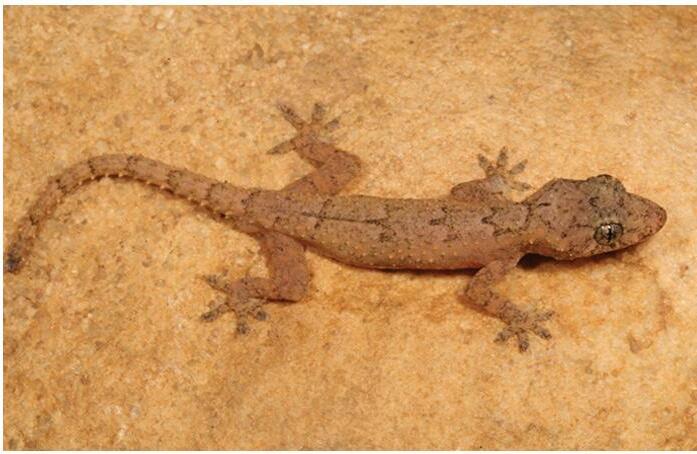
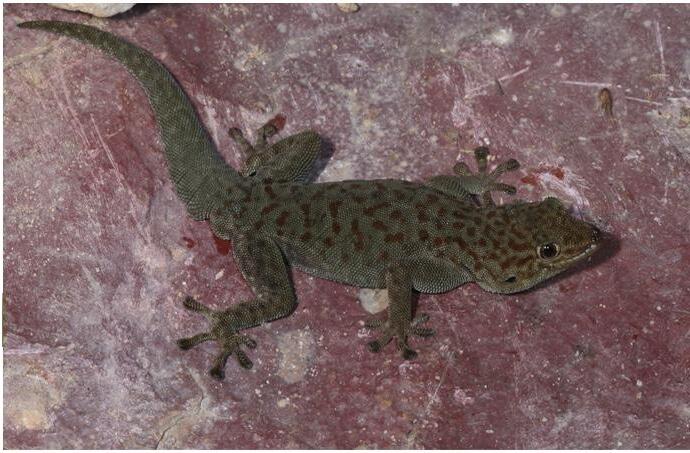

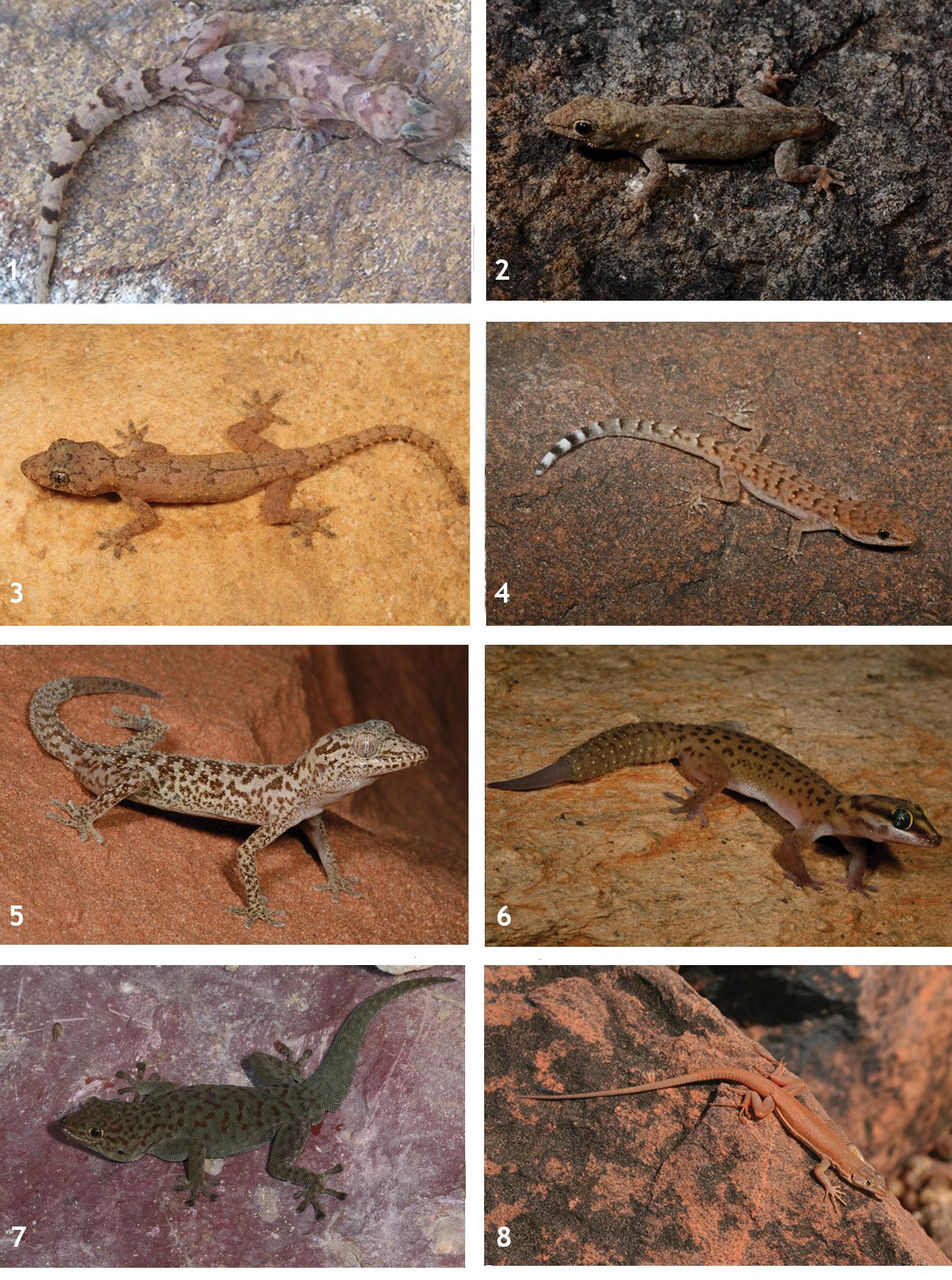
By John Mendelsohn
Africa has many special features. Among them is the exceptionally high plateau stretching across the southern half of the continent and rising 1,000 metres and more above the surrounding Atlantic and Indian Oceans (see map below). A large part of this plateau forms the great Kalahari Basin, renowned for being the biggest continuous area of sand on planet Earth.
Another special feature is the Great Escarpment, which encircles this plateau. In the west the Great Escarpment stretches south from Gabon through Angola, Namibia, into South Africa and then east and north all the way to Ethiopia. In many areas the Great Escarpment and its peaks rise to 2,000 metres or more. Most rivers either flow rapidly down to the surrounding coast or lazily into the broad plain encompassed by the Great Escarpment.
Biologists have long focussed their attention on species found only on these highlands. Studies in the Ethiopian highlands, Tanzanian Eastern Arc Mountains, Zimbabwe Eastern Highlands, South African Drakensberg and Cape Fold Mountains have made these areas famous for their endemics, the term for organisms found only in certain restricted areas. However, relatively little information was available about endemism on the highlands of Angola and Namibia.
The Namibian Journal of Environment (https://nje.org.na) recently published a review written by 64 people from around the world, most of them specialists in their fields of study on particular groups, for example euphorbias, petalidiums (petal-bushes), reptiles and butterflies. The review consists of 26 articles and runs to 338 pages. Individual articles or the whole book can be downloaded for free (see QR code and link at the bottom of this article).
Broadly, the review seeks to answer five key questions: 1) What characterises the highlands’ structure, climate, biota and land uses? 2) How diverse are the taxonomic groups represented in the highlands? 3) How many endemics have been catalogued there? 4) Where are centres of diversity and endemism located within the highlands? 5) How are highland species and subspecies related to similar plants and animals found elsewhere in Africa?
The monograph focuses on the highlands and escarpments that stretch some 2,700 km from Cabinda and the Congo River southwards to the Orange River on Namibia’s border with South Africa. Two plateaus 1,700 metres and more above sea level cover large areas: the Angolan Planalto and Namibia’s Khomas Hochland. Both occupy central areas in their respective countries. Numerous inselbergs (isolated mountains) rise above the landscape, and many scarps form sharp margins between lower, western and higher, eastern areas. The highest peaks rise to about 2.5 kilometres above the sea, the best known in Namibia being the Brandberg (2,573 masl) and Moltkeblick (2,489 masl) on the Auas mountains.

The rim of highlands around the margins of Africa and its high internal plateau south of the Equator. The blue line demarcates the highlands of Namibia and Angola.
Average annual rainfall ranges from about 1,200 mm in the north of Angola and on the Angolan Planalto to less than 100 mm in the far south of Namibia. To the south, declining rainfall as well as increasing evapotranspiration make the southern areas much more arid than those to the north. As a result, verdant tropical forests characterise the northern parts of this western section of the Great Escarpment while its southern areas support sparse covers of small grasses, shrubs and succulents.
The monograph begins with chapters summarising its main findings (to which I will return), and the ecoregions, and physical and human geography of HEAN – our acronym for the Highlands and Escarpments of Angola and Namibia. Other early chapters present detailed maps


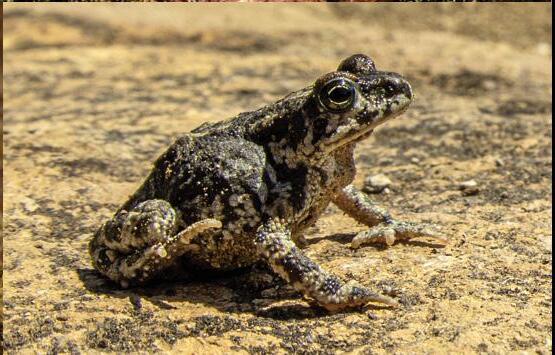
of the HEAN, the geology and landscape evolution of these highlands, and the challenges facing the conservation of Angolan highlands.
Then follow chapters on the HEAN’s endemic arachnids (spiders, scorpions and allies), birds, reptiles, flat geckos, ants, lacewings and antlions, termites, mammals, frogs, reptiles, fishes, Petalidium plants, Ceropegieae and euphorbia plants, and commiphoras.
Other chapters focus on endemism in certain areas: plants on and around Angola’s Mount Namba, plants and animals in northern Angola’s Serra do Pingano mountains, plants in Namibia, underground geoxyle plants on Angola’s central Planalto, and dragonflies and damselflies in Angola, and animals occurring mainly in caves.
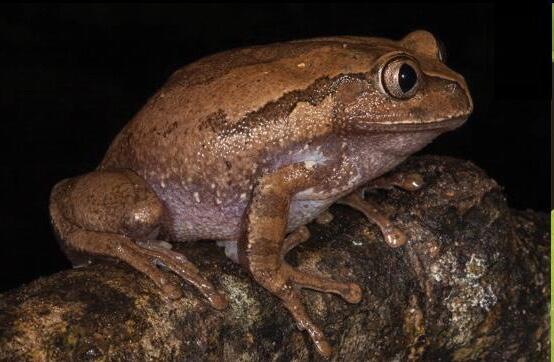


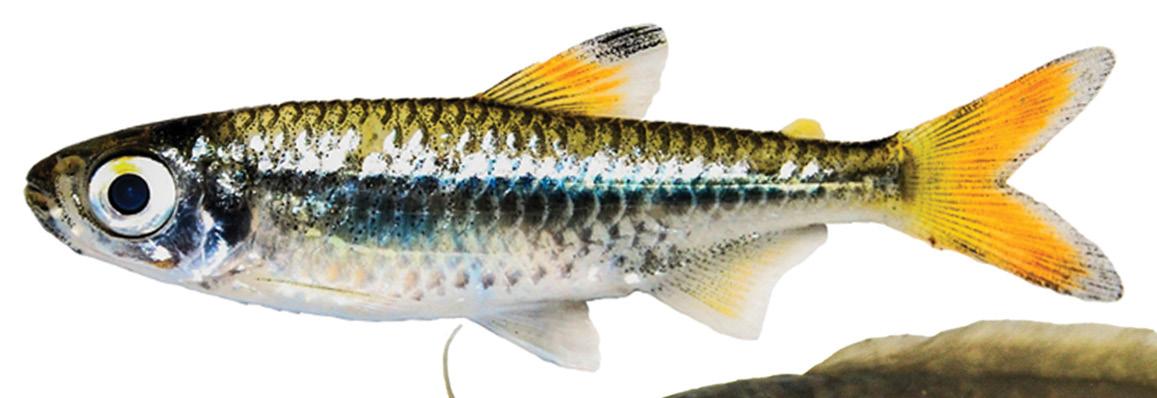






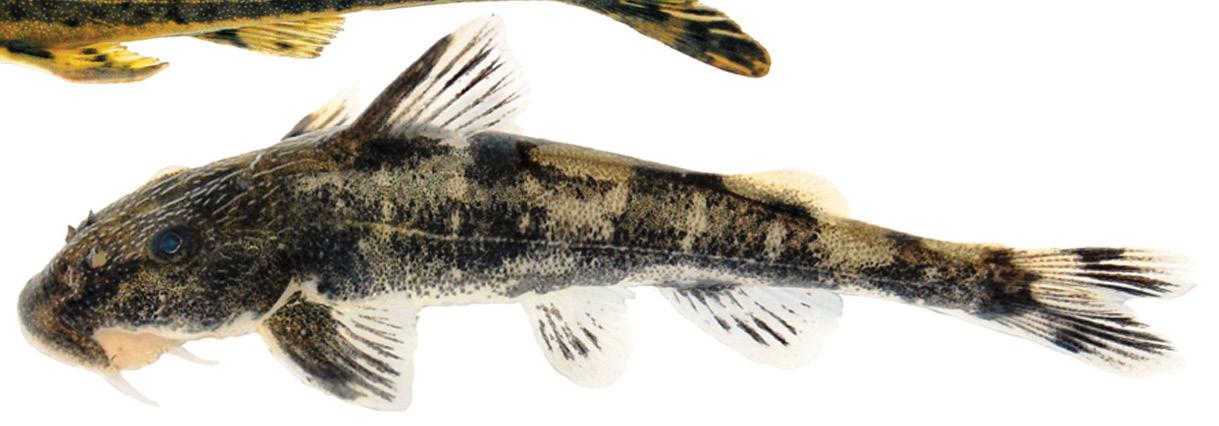


Namibian authors who contributed include Roy Miller, Wessel Swanepoel, Leevi Nanyeni, Frances Chase, Alice Jarvis, Pat Craven, Francois Becker and Herta Kolberg.
What was found
Lots of endemics! Among the taxa reviewed at least 570 known animals and plants are now known to be endemic to the HEAN. But the number would be quite different if other groups could have been added to the review. These include groups that have many species, such as beetles, flies, bugs, crustaceans, round (nematode) and segmented (annelid) worms, snails and allies, mosses and allies (bryophytes), algae and others.
In Namibia, of some 4,000 species of indigenous seed plants, over 100 are known only from the highlands. In their chapter, Pat Craven and Herta Kolberg found that Brandberg is home to over 480 indigenous seed plants, of which about 90 are Namibian endemics and nine are limited to the mountain itself. Kyle Dexter and his coauthors found that 22 of the 36 African species of Petalidium are endemics or near-endemics to the HEAN. Among the 570 endemics found in this area, some are particularly charismatic and well-known among naturalists, such as Angola Dwarf Galagos, Angola Cave Chats, and Swierstra’s Francolins.

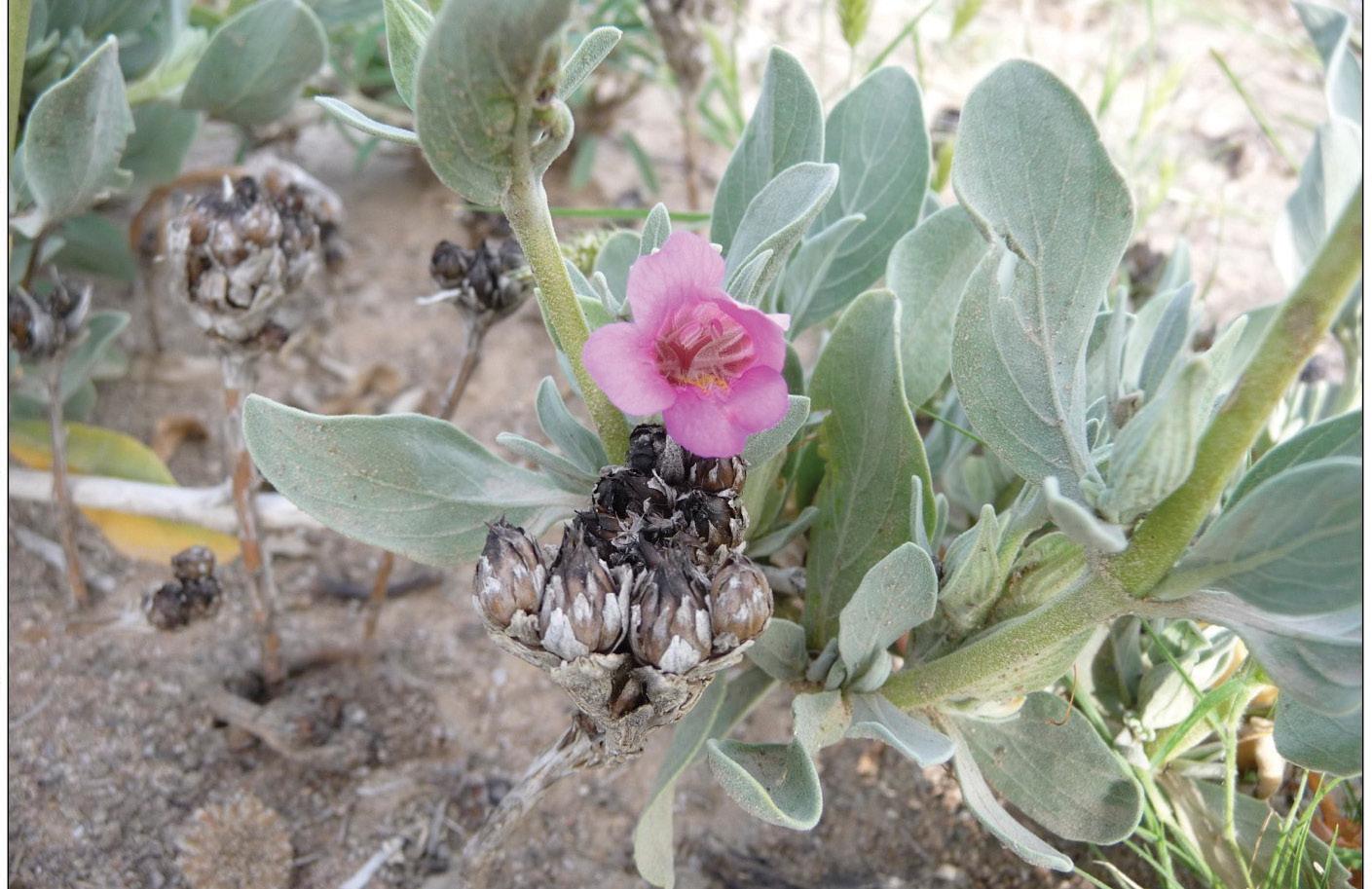


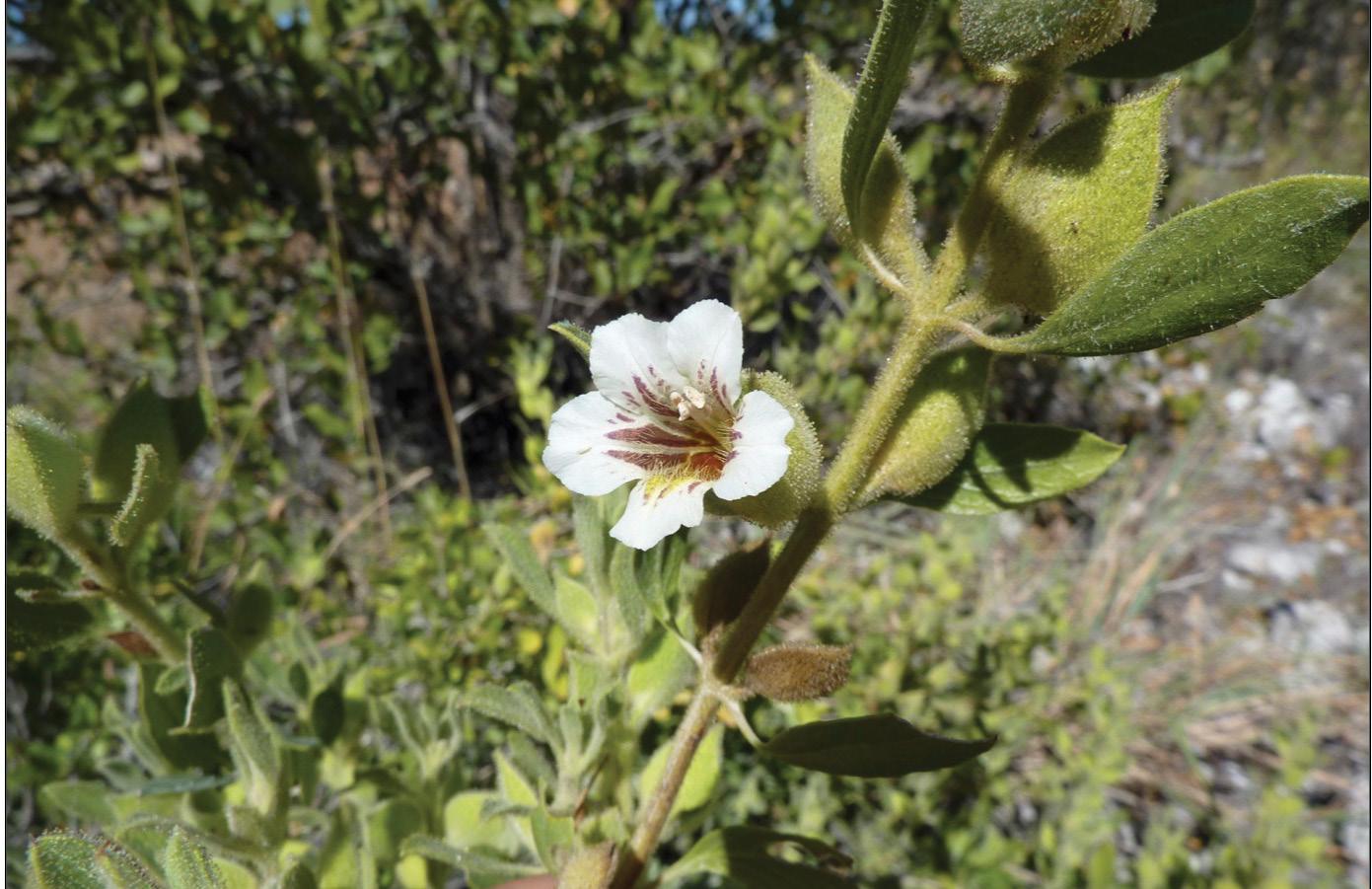



The authors of the articles in the review would agree on several priorities. Special emphasis should be placed on exploring neglected regions and habitats within the HEAN. We also need to take stock of endemism among other taxonomic groups not covered in this publication. Effective conservation measures are urgently required to protect the fragments of relict forests, grasslands and savannas that carry the products and evidence of many millions of years of evolution. These habitats are progressively decimated by frequent hot fires, charcoal production and the clearing of woodlands and forests for shifting agriculture. Pedro Vaz Pinto and his coauthors working in Angola stressed the urgency of conservation interventions in the country.
Perhaps the most striking conclusion is how little is known about most plants and animals that live only on our highlands, and for which Namibia and Angola are fully responsible. Much of this ignorance is due to a scarcity of records in museums, herbaria and digital databases, such as the Global Biodiversity Information Facility (GBIF www.gbif.org). But there is also a great shortage of students and scientists who study different groups of organisms.
The collection of specimens, fieldwork, and studies of biogeography, taxonomy and systematics are no longer fashionable. Indeed, much of the information on which humanity now relies was collected by hardy, brave explorers, missionaries and naturalists who trudged their way across Namibia, Angola and beyond 50, 100 and 150 years ago. Where is the new generation of naturalists to fill the gaps and document recent changes? How many species known to scientists in Angola and Namibia a century ago no longer exist? We can only dream about those we don’t know, and never will!




Twelve Petalidium species endemic to the highlands of Namibia: A) Petalidium cymbiforme (EMT), B) Petalidium rautanenii (EMT), C) Petalidium ohopohense (EMT), D) Petalidium subcrispum (EMT), E) Petalidium pilosi-bracteolatum (EMT), F) Petalidium sesfonteinense (KD), G) Petalidium crispum (EMT), H) Petalidium angustitubum (LN), I) Petalidium giessii (EMT), J) Petalidium rossmanianum (EMT), K) Petalidium lanatum (EMT), L) Petalidium kaokoense (EMT).
Great credit goes to the Ongava Research Centre and Namibian Chamber of Environment for material and financial support. Similar support from the institutional homes of the many authors is likewise acknowledged. More personally, I am indebted to Brian Huntley and Pedro Vaz Pinto for their help in editing the volume and to Alice Jarvis and Carole Roberts for their dogged determination to get the language, style, and layout done correctly!
Credits for the magnificent photos in this article are: AMB – AM Bauer, BB – B Branch, EMT – E Manzitto-Tripp, ES – E Swartz, FB – F Becker, JLR – J Lobón-Rovira, JM – J Marais, JP – J Penner, KD – K Dexter, LMP – LMP Ceríaco, LN – L Nanyeni, NLB – NL Baptista, PS – P Skelton, PVP – P Vaz Pinto, RB – R Bills, WC – W Conradie.
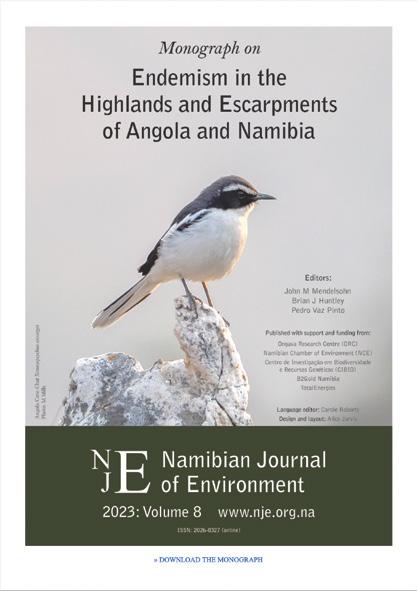
Download the full publication by scanning the QR code or visit: https://nje.org.na/public/ journals/1/TOC-volume8.pdf


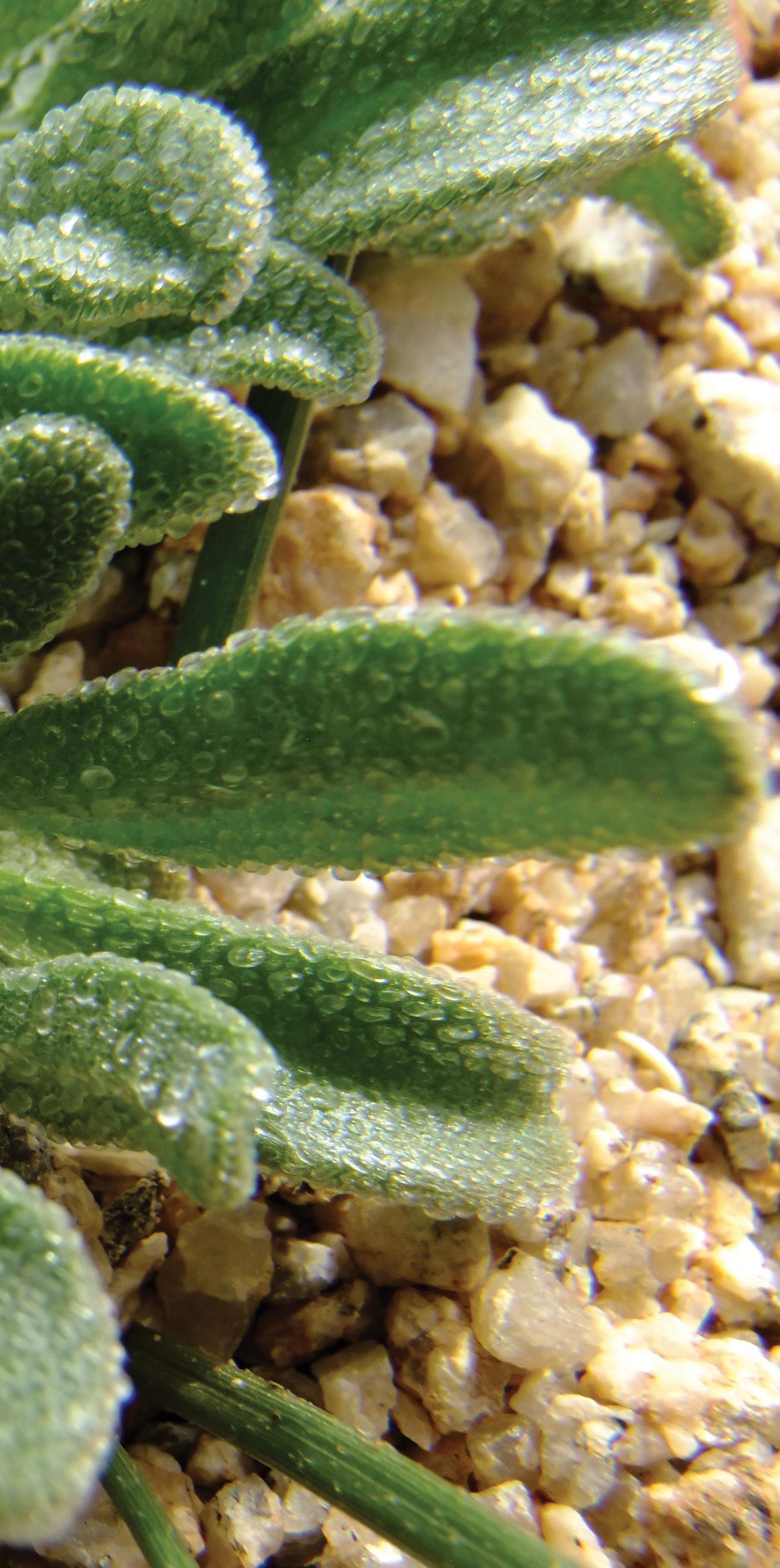
By Herta Kolberg and Sofia Amakali
Plants are the basis of almost all other life on earth, yet they are highly undervalued in Namibia due in part to the lack of knowledge about indigenous plants among ordinary citizens. Some of Namibia’s plants are rarer and more highly threatened than black rhino, yet few people could even name them. As plant poaching becomes increasingly prevalent, more Namibians need to know why plants are important and what they can do to conserve them.
To improve awareness and better manage our plant resources, we started collecting all existing knowledge on Namibian plants in one user-friendly database. Since we have close to 4,200 indigenous plants, we had to divide this task into more manageable sections and decided to start with endemic and near-endemic species. “Endemic” refers to plants that occur nowhere else on earth. Our near-endemics occur mainly in Namibia, with smaller parts of their ranges in other countries. As the only or primary national custodian of these plants, Namibia has a particular responsibility to conserve these species.
The challenges and rewards of building a plant database
Quite a substantial amount of information on Namibian plants is available, but it is scattered throughout the world in different sources and formats, including online databases, herbaria, scientific articles, internet sites, unpublished reports, postgraduate theses, field notes and photo collections. Most of this information is not accessible to laymen, mainly due to language barriers (much of it is in German), financial resources (getting access to published articles can be expensive) or complex terminology that only experts understand.


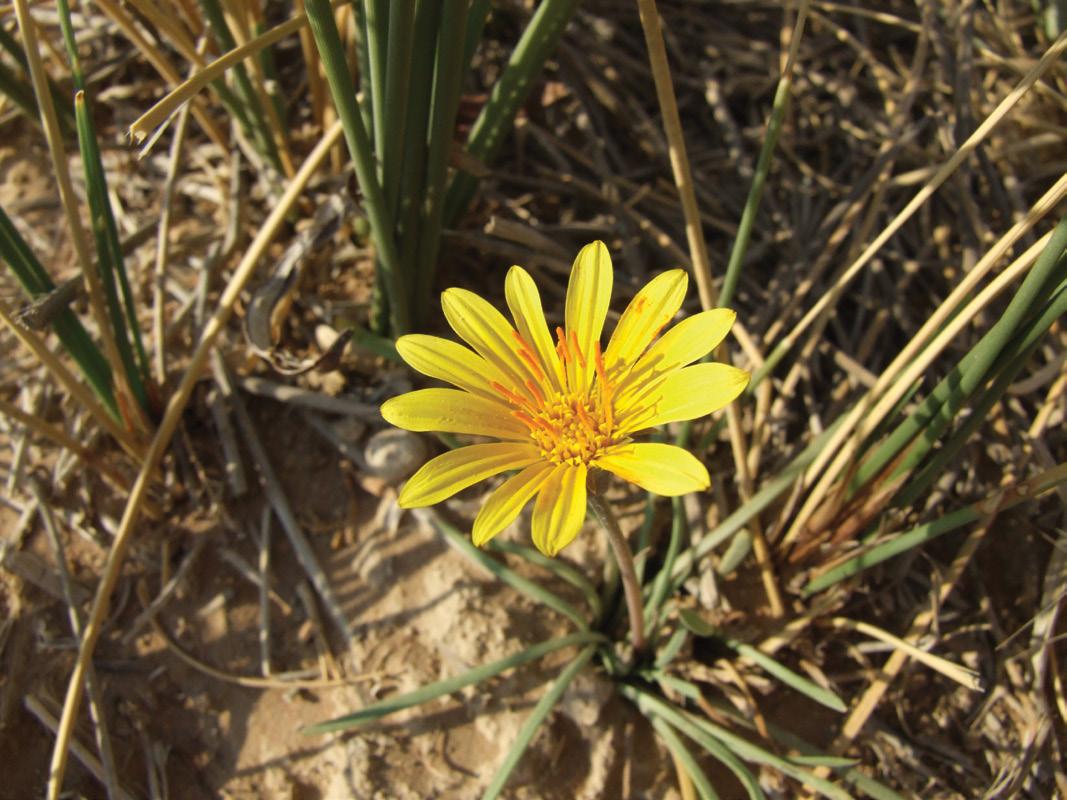
Besides these challenges, much of the information is inaccurate or simply wrong, especially on the internet. This is often due to websites being managed by laymen or even professional botanists who do not know Namibia and its flora or do not understand German. We want to correct these errors and present a definitive data set for Namibian plants.
To this end, I (Herta Kolberg) started a database of indigenous Namibian plants more than 40 years ago. This was later combined with my colleague Patricia Craven’s database, to which we added information as it became available. This soon became an overwhelming, full-time task.
In 2022, Patricia and I were funded by the Namibian Chamber of Environment to update the endemic plant information and enter it into the Environmental Information Service Namibia (EIS), which hosts atlases for many species groups and a library of information about Namibia. This was the first time plant information was included in the EIS. In May 2023, I obtained funding from the JRS Biodiversity Foundation to update the information for near-endemic plants over two-and-a-half years; enlisting the help of Sofia Amakali to enter the data. Our ultimate goal is to bring together all existing information, verify, summarise and analyse it and make it available freely online through the EIS. We aim to publish information that is scientifically correct, yet understandable and useful to the layman.
The Plant Information System on the EIS now lists all the indigenous plants recorded in Namibia. One of our significant challenges is deciding which scientific names to use, since these change quite frequently as scientists investigate how different plant species and genera (the category above species) are related to each other. In some cases, a plant may be renamed by one scientist and then changed back to its old name by the next scientist. The scientific community has numerous ongoing debates about which names are correct.
In recent times, many plant naming decisions are based on molecular (DNA) differences between plants or groups of plants. If the differences between plants at the molecular level are not related to what you can see and use to identify a plant (known as morphological differences), this is of no use to the field botanist or layman. Foreign researchers often do not use Namibian specimens in their work for
plants indigenous to the country, but also occur elsewhere. This leads us to question whether their results also apply to Namibia. For these reasons, we do not accept all name changes for Namibian plants and instead stick to the ones we know until there is better evidence and disputes are settled. This is not just our view – many botanists worldwide have called for greater stability of plant names.
Exploring and contributing to the plant database
When exploring the EIS Plant Information System you will find basic information, where available, for each plant species. This includes the plant group (Dicotyledon, Monocotyledon, Gymnosperm), plant family, lifeform (tree, shrub, grass, etc.), status (endemic, near-endemic), legal status (if it is protected in Namibia and by which law) and the region or regions in Namibia where it can be found. You will also find out how threatened the species is according to the International Union for the Conservation of Nature’s red list and whether or not trade in this species is regulated by the Convention on International Trade of Endangered Species (CITES).
Each endemic and near-endemic species entry (336 of 618 species targeted for the JRS-funded project completed thus far) includes a link to a species information sheet, which contains all the information we have as well as a distribution map and some photographs of the plant, when these are available. Eventually, we want to produce these sheets for all indigenous Namibian plants. We use information from specimens collected in Namibia to generate the plant descriptions. This makes the descriptions truly Namibian, because plants of the same species may look slightly different in other countries where they occur, mainly due to different growing environments. This guide should make it easier to identify plants in Namibia.
As we develop information sheets for each species, we discover the need for more information that could be supplied by Namibians who are acquainted with these species. First, many of the common names of each plant in different languages may be mis-spelt or absent. We included only published names, found on herbarium specimen labels or in reports and an index card system created by the late botanist Willy Giess. We retained the spelling used in the source, but realise that this may be outdated or wrong. For this reason, we appeal to speakers of the various languages to give feedback on any such


mistakes. Not many local names are recorded for the endemic and near-endemic plants – if anybody can provide additional names, we would be very grateful.
Secondly, we have little or no information on the traditional uses of many endemic and near-endemic plants. On the species sheets, we include only broad use categories (e.g., food, fodder, medicinal) and only information that is already in the public domain to protect the intellectual property of the holders of that knowledge. Recording traditional uses for plants is nonetheless an important task, and we invite any traditional knowledge holders to work with us to preserve this information.
Thirdly, we have few photographs of all the endemic and near-endemic plants, which limits the usefulness of this database for people to identify these species correctly. The JRS-funded project includes two field trips annually to obtain photographs and make other botanical discoveries. We completed one trip to southwestern Namibia and one to the northwest, during which we took photographs of 226 species, but we are still missing photos of just over 200 species. To fill this gap, we launched a competition to encourage the citizen science community to submit images to the Indigenous Plants Atlas of the
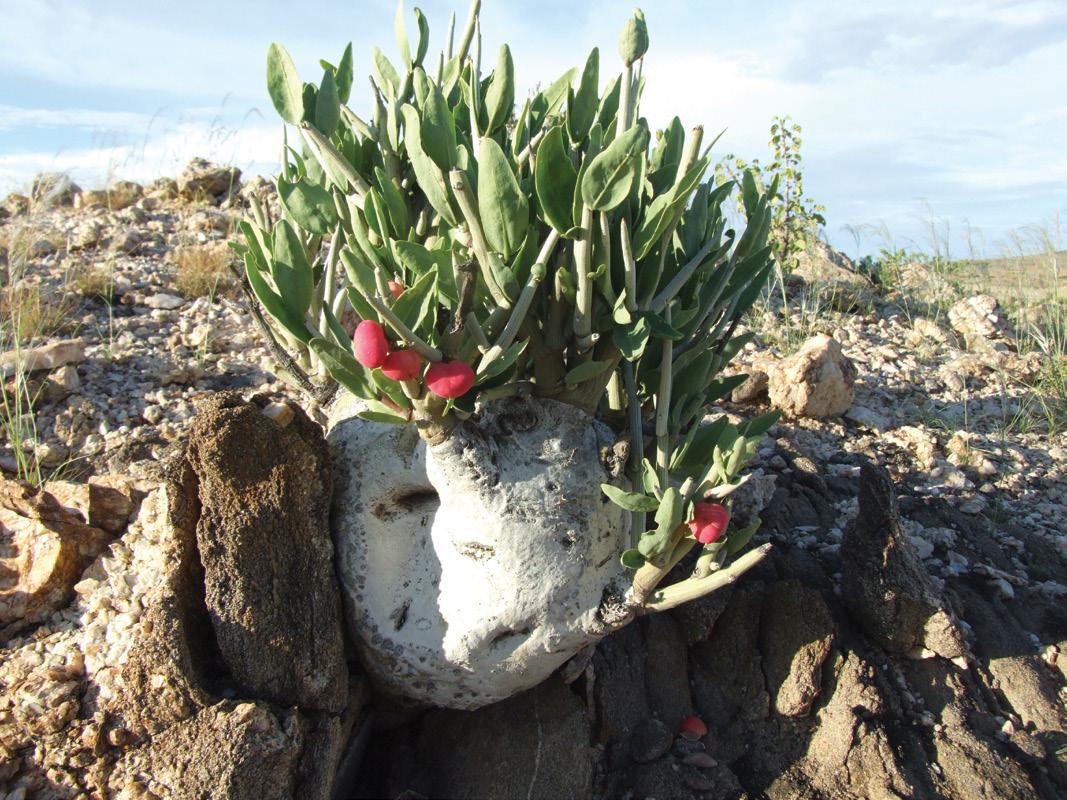
EIS. Cash prizes were offered to the top three contributors of nearendemic plant photos. Unfortunately, the drought seems to have put a damper on the number of records submitted by atlasers and we haven’t received as many photos as we had hoped.
Our two field trips resulted in several interesting discoveries that reveal how much more is yet to be discovered about Namibia’s plant diversity. In the northwest we found one species (Lamiaceae family) possibly new to science and two species (Hybanthus mossamedensis, Distimake aegyptius) known only from outside Namibia up to now. We also recorded one species (Cleretum papulosum), known only from South Africa until now, on the field trip to the southwest. Based on this success, we look forward to future trips to add to our knowledge of Namibian plant species.
During the current project, we trained 37 stakeholders, 13 junior staff or interns at the National Botanical Research Institute and a project intern. Mentoring new plant scientists and transferring the knowledge I have accumulated during my long career in Namibian botany are important parts of this endeavour. Since this work will continue long

into the future, we need many more dedicated young Namibian botanists to take up this challenge.
Once we have completed the current work with endemic and nearendemic species, we aim to produce an electronic record of all the plants in the country. Each record will include basic information about a plant: an identification key, description, distribution, old names (synonyms), voucher specimens and more. This should allow the user to identify plants. To publish a hard-copy Flora book with full colour photographs of each plant would not be feasible, firstly because by the time a book is published, the information is already out of date and secondly because of cost. We are therefore working towards a digital, online Flora for Namibia, which can be kept up to date with the latest discoveries and science.
We will complete the present phase of the programme, focusing on endemic and near-endemic plants, during the next 15 months. Towards the end of the project, we will demonstrate how the information on the EIS can be used for the different purposes of our stakeholders. Once this phase is completed, we need to identify further funding sources to move on to another group of plants. We were thinking of dividing the remaining species (over 2700) into categories linked to their growth form (e.g. trees, grasses, bulbs) or use type (e.g. forage, medicinal, cultural). If we maintain our current rate of progress, this work should keep us busy for the next 12 years!
• We have close to 4200* plants indigenous to Namibia.



• About 700* of these occur nowhere else on earth (endemic to Namibia).
• For about 715* plants, the largest part of their distribution range is in Namibia, with a smaller area extending into one of our neighbouring countries (near-endemic to Namibia).
• Namibia has a full responsibility to protect endemic species and a greater duty to conserve near-endemic plants.
* It is impossible to give exact numbers, because there is continuous research conducted worldwide
distribution ranges updated.

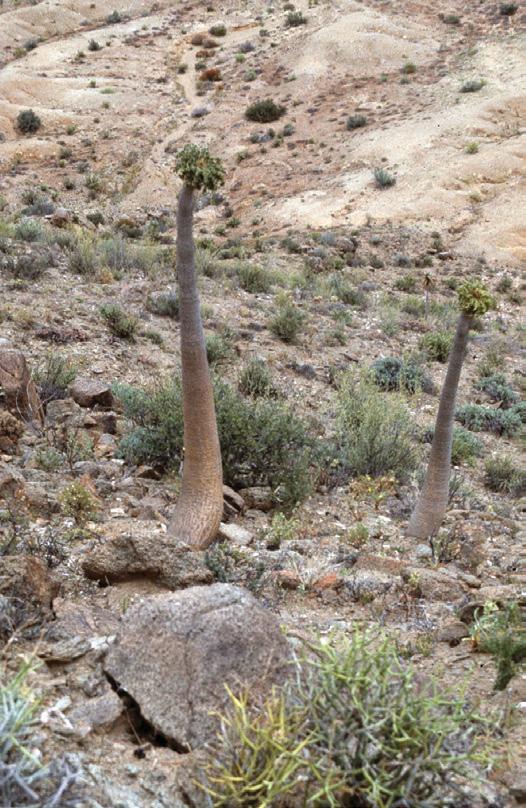
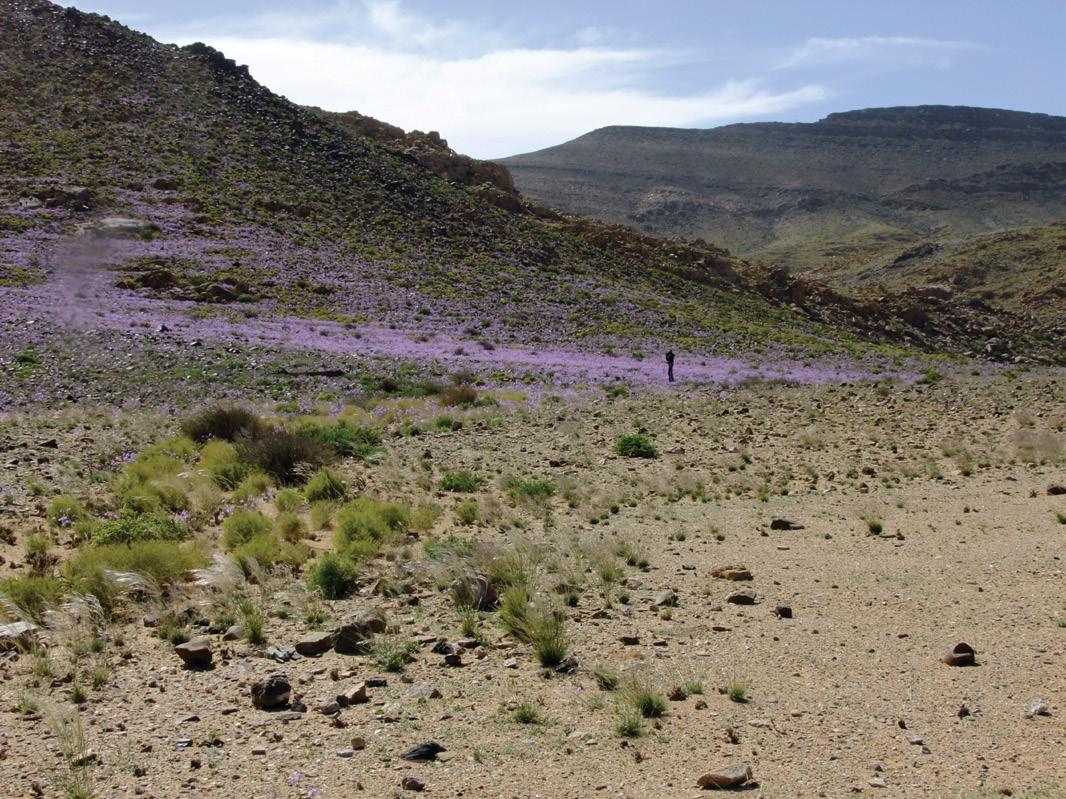
Work on the endemic and near-endemic plants programme requires many hours of searching for data and digitising this, but we also get to enjoy the highs and lows of fieldwork and visit some beautiful places.
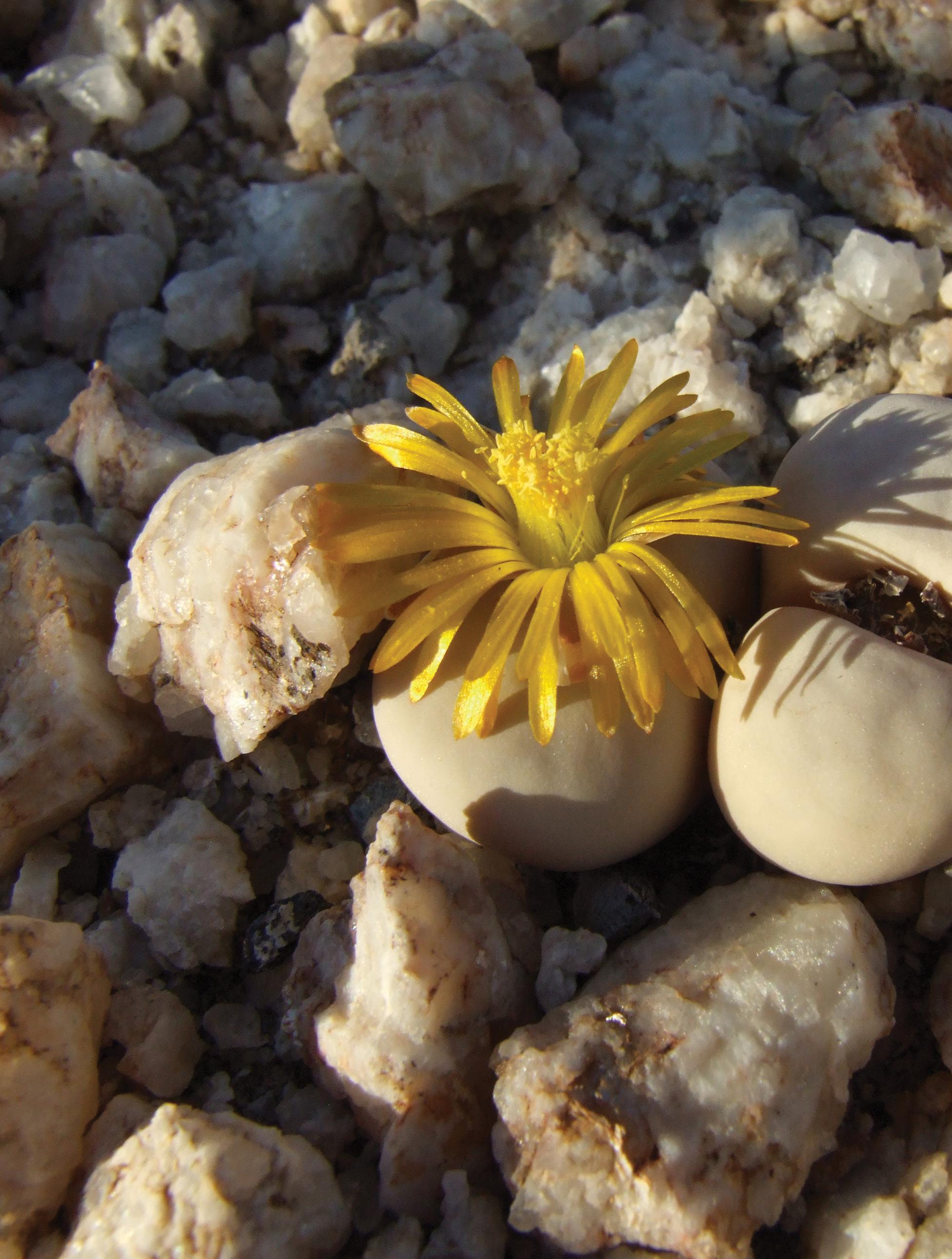

By Esmerialda Strauss, Leevi Nanyeni and Theunis Pietersen
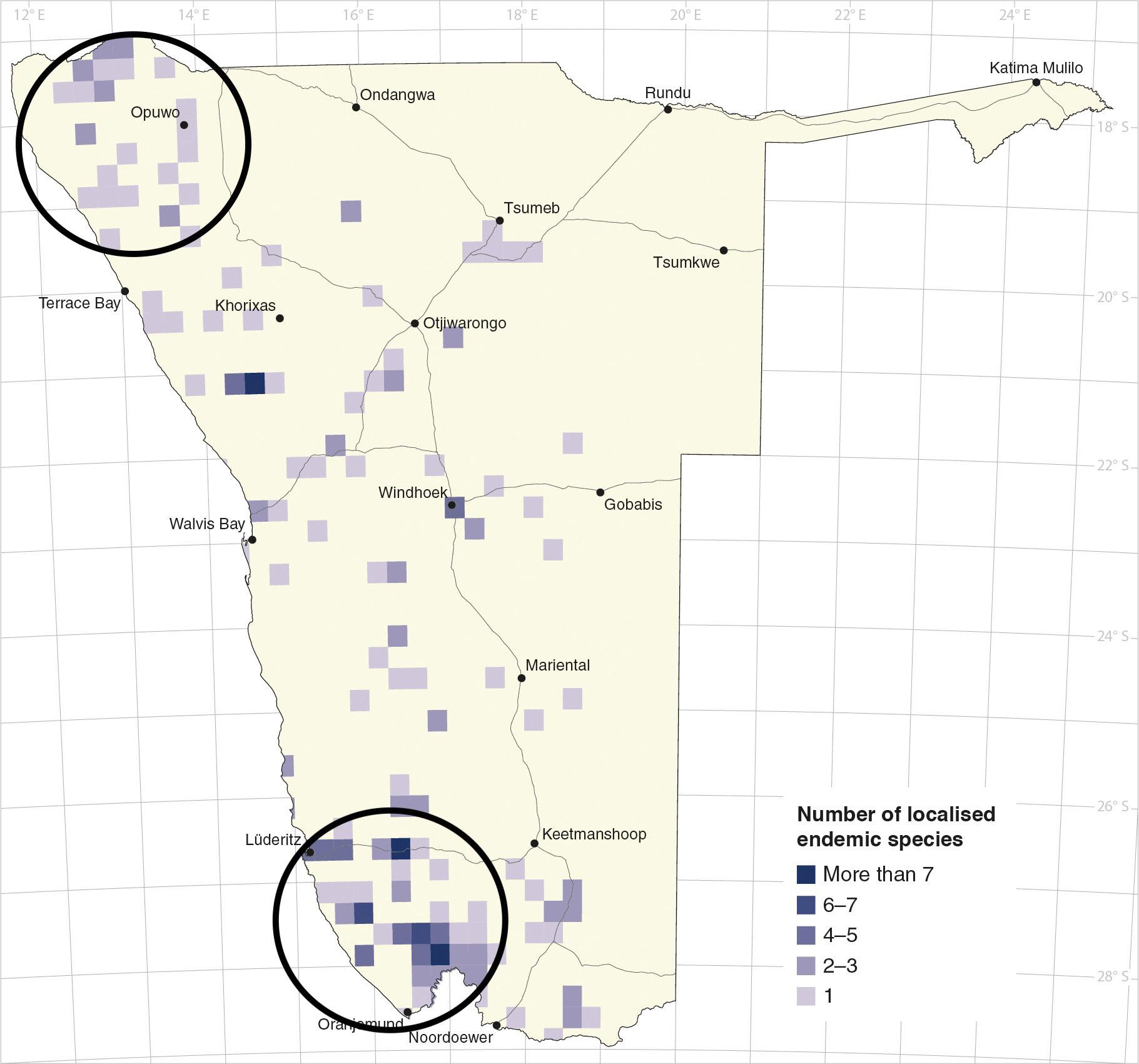
Namibia is renowned for its rich diversity of endemic succulent plants, which unfortunately, makes it a target for plant poaching. While Namibia welcomes the interest of plant lovers to see our plants in their natural habitat, increasing attention from illegal plant poaching syndicates is a troubling development.
Most of our unique succulents occur in the Kaokoveld Centre of Endemism in north-western Namibia, which continues into Angola, and the Gariep Centre of Endemism in south-western Namibia, which continues into South Africa. These remote areas are vulnerable to cross-border smuggling and difficult to patrol, while many of the plants growing here occur nowhere else (known as endemic species).
Plant poaching in Namibia used to be restricted to occasional, isolated incidents. Since 2021, we have recorded a sharp increase in plant poaching activities due to the increased trading in rare plants ascribed to global trends in online trade of succulents for ornamental purposes. In the initial stages of this spike, most border officials had never encountered plant smuggling and therefore could not identify species of conservation concern.
Investigators have established that international crime syndicates drive the Namibian plant trafficking operations, employing Namibian nationals to harvest endemic and protected plant species illegally using their local knowledge. The plants are then smuggled across Namibian borders
and sold to international plant collectors. From January 2021 to April 2024, 16 wildlife crime cases involving ten protected plant species were registered and 37 suspects were arrested. A staggering 4,128 individual plants were confiscated during these arrests, indicating the level of threat these activities pose to the survival of these species.
In response to increased plant poaching activities, the Ministry of Environment, Forestry and Tourism, the Namibian Police Force and the Namibian Revenue Agency established the Protected Plants Task Team (PPTT) in 2023. This initiative is similar to the Blue Rhino Task Team that focuses on animal poaching.
Among the priority tasks for the PPTT is to ensure that border officials are made aware of this problem and have clear Standard Operating Procedures to follow when intercepting plant traffickers. The PPTT team developed several posters, plant identification guides, and training curricula for border officials and law enforcement staff. This training and awareness programme was later extended to community members in communal conservancies in the northwest that host highly targeted species. A total of 242 community members from five conservancies were trained, who will help spread the word that these plants are threatened and that plant poaching is a crime.
Members of the PPTT undertook a Flora-Focused Trafficking visit to South Africa to engage with counterparts and share experiences and lessons learned on the illegal harvesting, trafficking, and trade







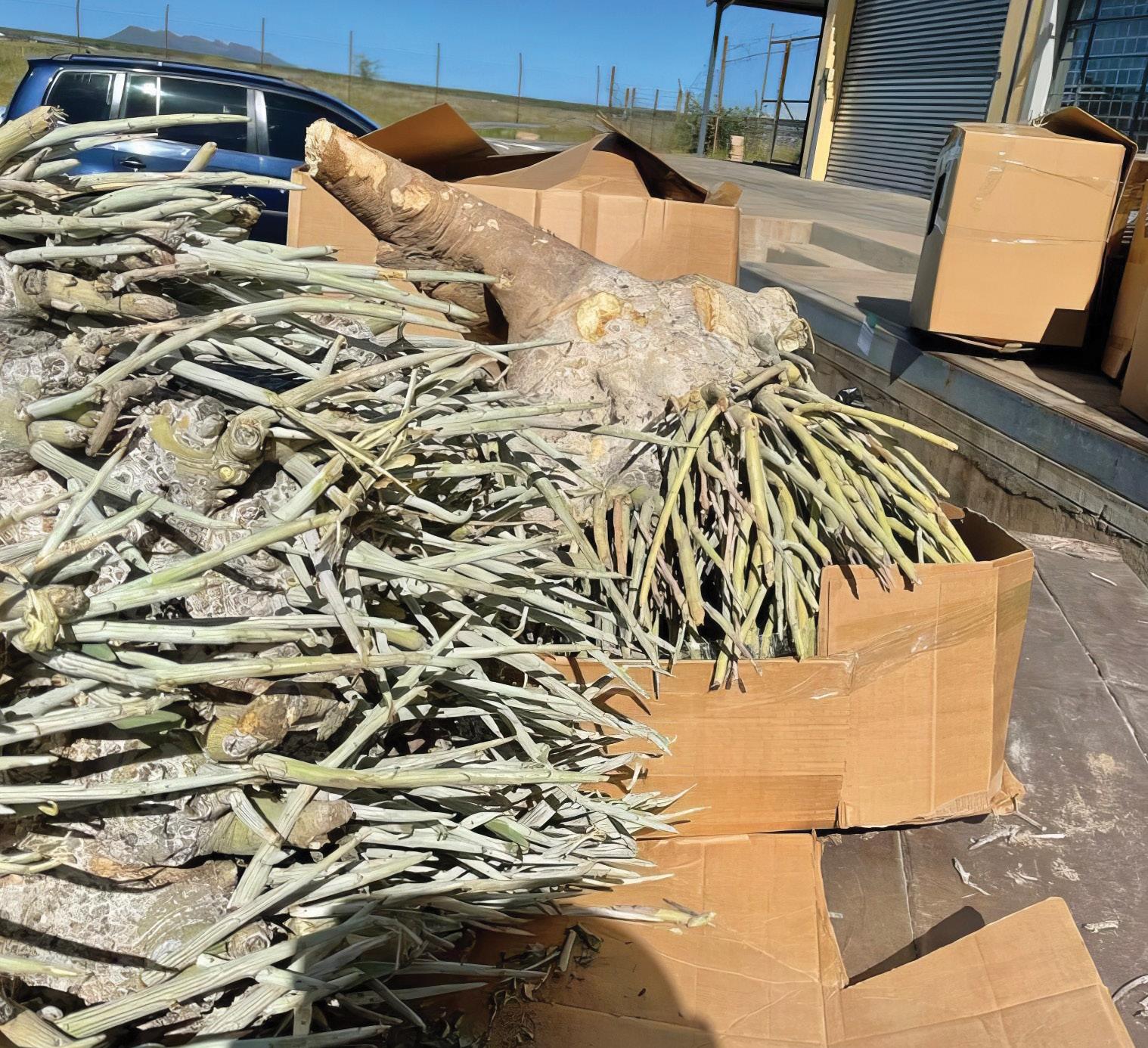
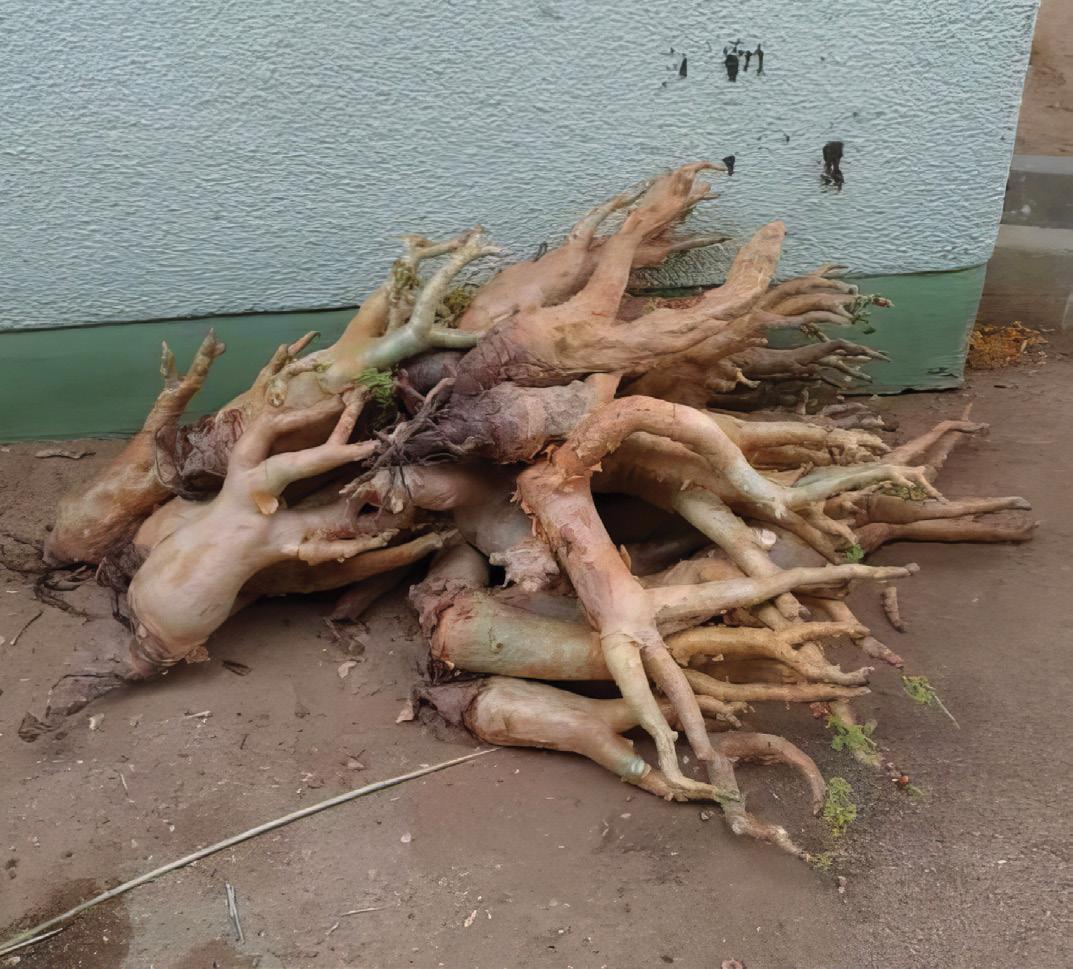





of succulent plants. Our South African colleagues included botanical experts, non-governmental organisations working on plant conservation, and relevant government officials.
Our collective efforts resulted in a significant breakthrough in November 2023 with the arrest of Diana Mashiku, a plant poaching kingpin from Tanzania, and her three Namibian accomplices. The suspects were arrested for possession of 46 Adenia pechuelii plants, known as Elephant’s Foot. This near-endemic species is highly sought-after by international plant collectors because of its peculiar shape that comes from growing in rocky areas. Unfortunately, plants from the wild are preferred as plants grown in the nursery tend to have a uniform shape. Based on the rate of illegal harvesting, Adenia pechuelii is threatened with extinction.
The kingpin, Ms. Mashiku, was charged with contraventions of the Prevention of Organised Crime Act 24 of 2004 (POCA), and the Forest Act 12 of 2001, as well as violations of the Immigration Act (conducting business without a permit). She entered a guilty plea and was sentenced to a fine of N$ 4000 (or twelve months imprisonment) for the Forest charges and another N$ 4000 (or imprisonment) for violations under the Immigration Act. The organised crime charges relating to illegal commercial activities carry heavier sentences – she was therefore fined a further N$ 20 000 (or five years imprisonment). The same charges against her Namibian co-accused persons are still pending. These additional charges and sentences might carry a stronger deterrent message, although the value of these plants on the international market continues to incentivise poaching.
This case revealed a new dimension of wildlife crime in Namibia and laid the foundation for collaboration between local law enforcement agencies and their counterparts in foreign jurisdictions. Namibian and Tanzanian
Authors
*Esmerialda Strauss, Deputy Director Forest & Botanical Research, Directorate of Forestry, Ministry of Environment, Forestry & Tourism, Private Bag 13306, Windhoek, Namibia
**Leevi Nanyeni, Senior Forester, National Botanical Garden of Namibia, National Botanical Research, Directorate of Forestry, Ministry of Environment, Forestry & Tourism, Private Bag 13306, Windhoek, Namibia
***Theunis Pietersen, Control Warden, Intelligence Investigation Unit (IIU), Directorate of Wildlife and National Parks, Ministry of Environment, Forestry & Tourism, Private Bag 13306, Windhoek, Namibia
officials working for their respective environment ministries were able to discuss this issue further during the African Wildlife Forensic Network workshop in November 2023. The criminal connections between the two countries are being further investigated to uncover trafficking routes and identify kingpins in the international syndicates.
What happens to the plants in these cases? Unlike poached animals, plants get a second chance at life, although replanting and caring for them is a costly exercise that may fail if the plants are too stressed. All consignments intercepted and confiscated are handed over to the National Botanical Research Institute (NBRI) in line with the Chain of Custody. NBRI staff provide the plants with initial care in nursery conditions, replanting healthy individuals within their natural habitat. Once the confiscated plants have been replanted in suitable habitats under the custodianship of landowners and communities, they are monitored at least once a year to determine the plants’ survival rate and health status.
Preventing the illegal harvesting, trafficking and trade of endemic and protected plant species is an important part of the overall fight against wildlife crime. The PPTT has made a promising start, illustrated by the increase in interception of illegal consignments and number of criminal cases registered. We continue to raise awareness among government officials and local communities about the threats that plant poaching poses to our environment, while our joint law enforcement efforts ensure that plant traffickers are arrested and prosecuted for their crimes.
The PPTT consists of members from the Ministry of Environment, Forestry and Tourism (MEFT) represented by the National Botanical Research Institute (NBRI) of the Directorate of Forestry and the Intelligence Investigation Unit (IIU) of the Directorate of Wildlife and National Parks (DWNP); the Protected Resources Division (PRD) of the Namibian Police; and the Namibia Revenue Agency (NamRa), the latter three entities also forms part of the multi-agency Blue Rhino Task Team, with technical support provided by the United States Forest Service International Program. The PPTT is supported by the RooiKat Trust; the Namibia Nature Foundation; the US Department of State, Bureau of International Narcotics and Law Enforcement Affairs (INL) and the US Fish and Wildlife Service.



in northwest Namibia

By


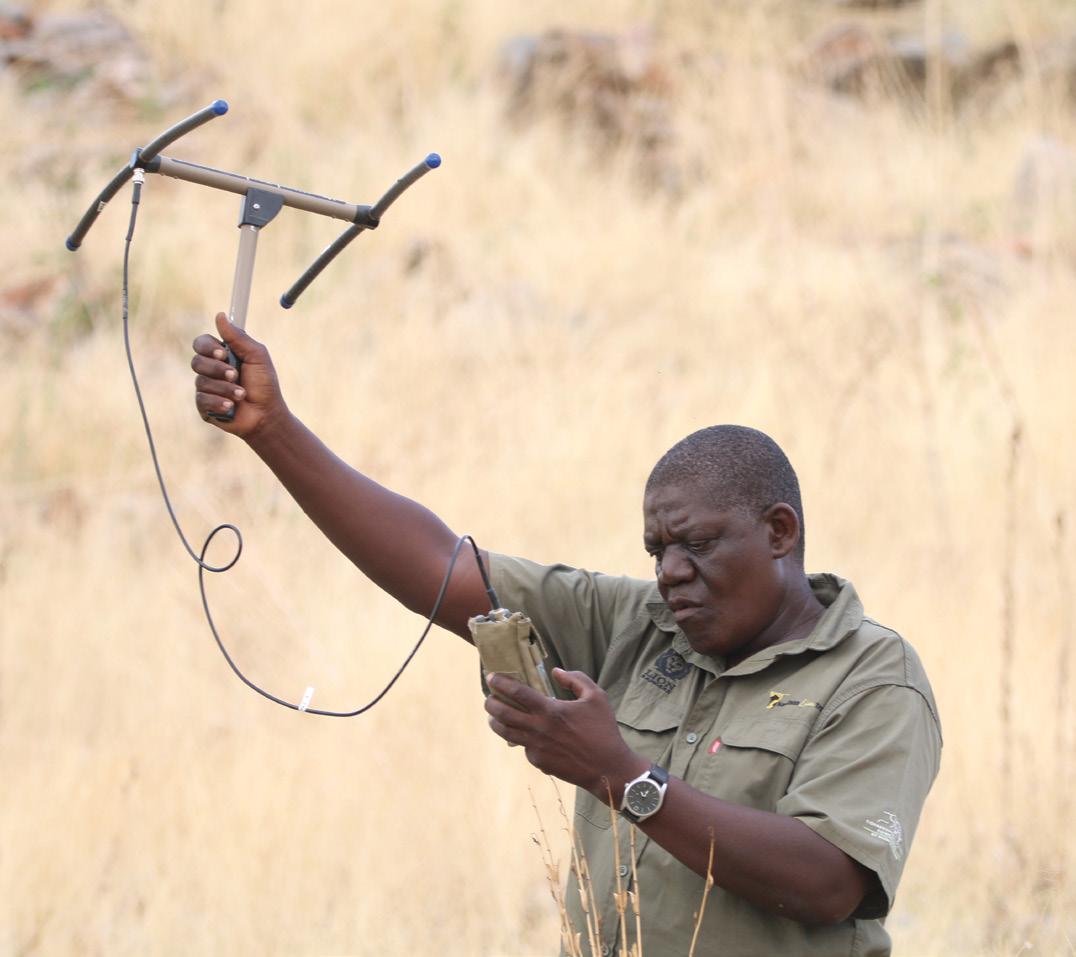



The long-term survival of lions living in Namibia’s arid northwest depends on their ability to connect with each other by moving through areas where people live and farm with livestock. If the connection between the Etosha and Skeleton Coast National Parks is cut off entirely, the desert-adapted lion population will ultimately die out.
A recent collaborative genetics study, conducted by lion researchers in Namibia including the Namibian Lion Trust, revealed that the area directly to the west and south of Etosha provides a critical genetic connection for lion populations in the northwest. While there are some barriers to movement, lions from Etosha mix with lions in these border areas. In turn, these lions may disperse further south and west to find other lions. In this way, the genetic integrity of lions living in the far western desert areas is maintained by those coming from populations near and in Etosha National Park.
The Namibian Lion Trust (NLT) works closely with the Ministry of Environment, Forestry and Tourism (MEFT) to conserve the key connecting population between protected areas. Our target area includes freehold land and communal land that falls mostly under four communal conservancies – Anabeb, Ehi-rovipuka, ǂKhoadi-ǁHôas and Omatendeka. Eleven communal conservancies between the western border of Etosha National Park and the Skeleton Coast, the Ugab and Kunene rivers, are within desert-adapted lion range.
Conservancies in Namibia were established by local communities who wished to benefit from the wildlife living in those areas. The financial and infrastructural benefits to the community, ideally generated by photographic and hunting tourism as well as major international donations, are often outweighed by the costs to individual households when livestock is lost to large carnivores – including lions. When added to losses suffered from drought and theft, lion predation can deal a devastating blow to local livelihoods.
In response to the threat of lion predation, some farmers illegally poison carcasses meant to kill lions (this often kills many other scavenging species such as vultures, and it is a danger to human passers-by who may remove pieces of a carcass for consumption), others shoot them. Conservancy committees may request specific lions to be declared as ProblemCausing Animals (PCA), to be killed or translocated with MEFT permission. Deaths related to farmerlion conflict are the biggest threat to the long-term conservation of lions living outside national parks in Namibia, and elsewhere in Africa.
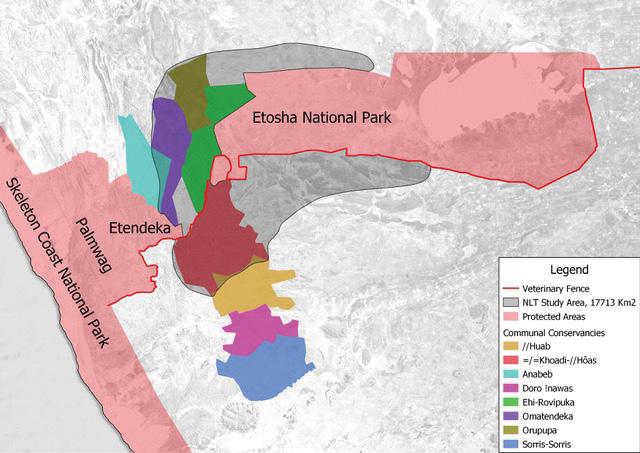
The lion population between Etosha and Skeleton Coast National Parks covers several commmunal conservancies. NLT’s study area includes four of these conservancies and surrounding areas outside Etosha.
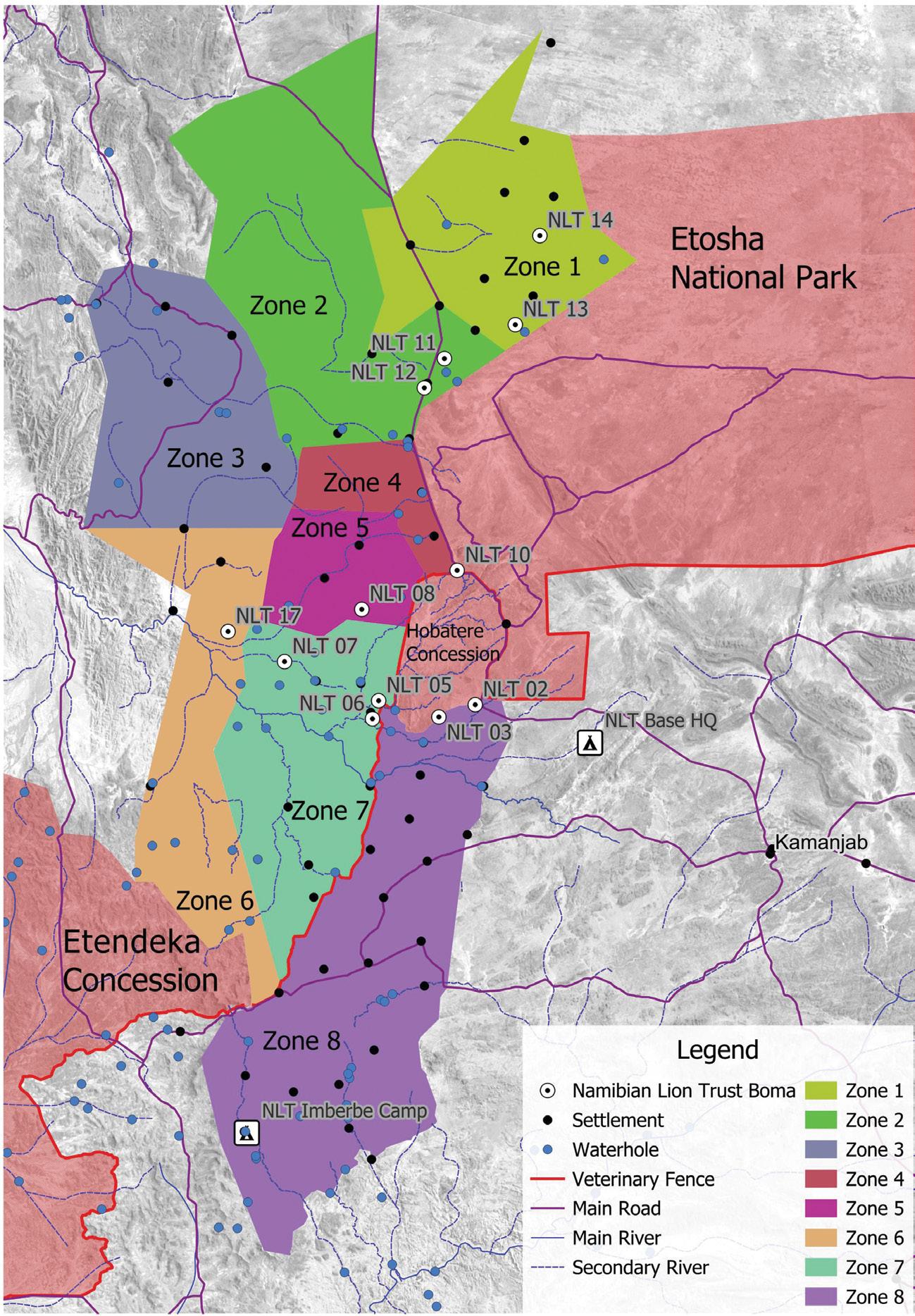
The 12 NLT
Rangers cover eight zones, which they patrol regularly to monitor lions and engage with communities.
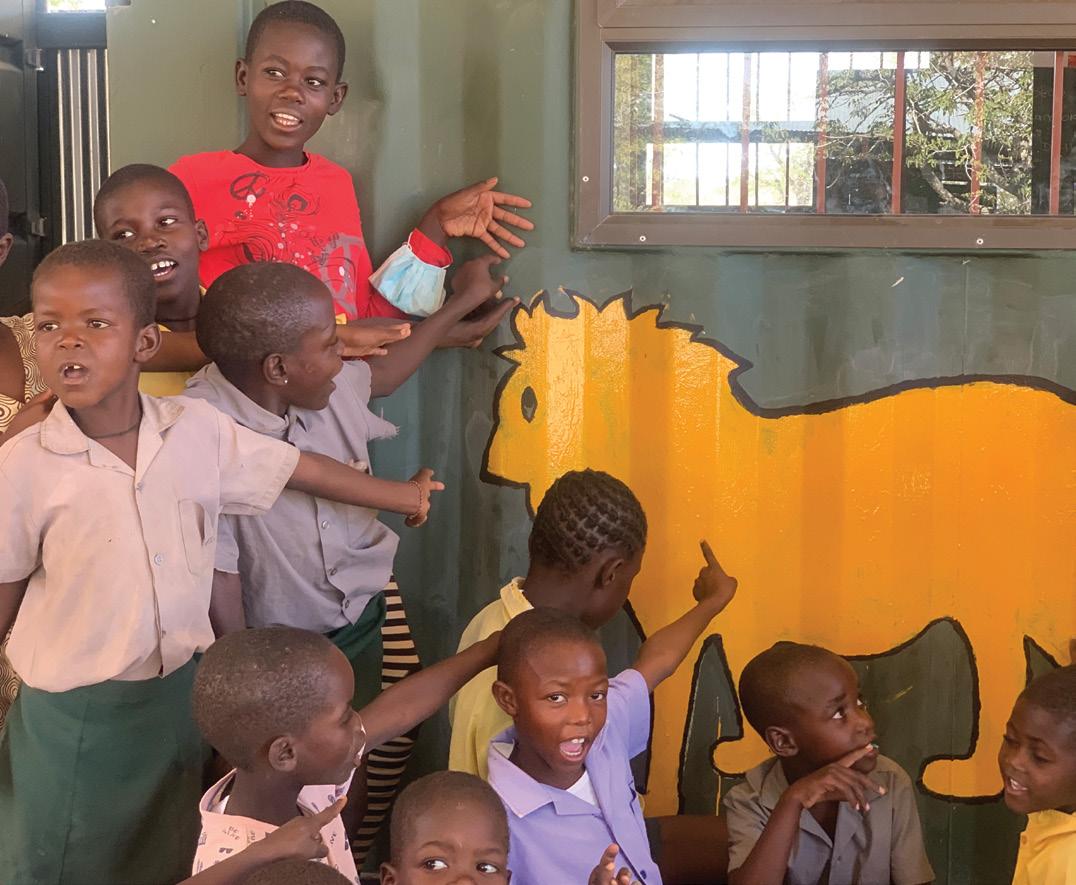


Conserving lions in these circumstances must therefore focus on reducing livestock losses and encouraging co-existence in a common landscape, by working alongside the farmers who share this habitat. Since 2010, the Namibian Lion Trust has built more than 30 communal, predator-proof livestock enclosures (kraals or bomas), most of them equipped with ”lion lights” that flash at night, to protect animals in areas identified as conflict hotspots. Farmers who use these bomas as a rule, especially when lions and spotted hyaenas are in the area, can virtually eliminate their losses to large carnivores. But it also requires herding cattle and small livestock daily, which costs time and money. Herdsmen need to be given payment and food, increasing the costs that most communal farmers cannot afford.
The situation is worsened during drought years, when the only grazing and browse left in this arid landscape is far from the safety of permanent kraals. We therefore supply shade cloth and wooden poles to participating farmers to construct temporary or mobile bomas in areas closer to the grazing lands. This material can be moved by donkey cart or vehicle and be assembled relatively quickly. Another advantage of such mobile structures is that livestock hooves chip away at the hard soil and fertilise it with their manure, rendering it more fertile for grass seed germination once the rains fall.
Since lions generally move vast distances during the cooler mornings and evenings and at night, cattle are not exposed to the same level of danger all the time (although spotted hyaena may still pose a threat in the absence of lion). The extra effort needed to fully protect domestic stock – cattle, goats, sheep, horses and donkeys – by herding during the day and protecting them at night, is therefore best spent when lions are in the immediate vicinity. This is where the Lion Rangers come to the rescue of farmers and lions.
While the Namibian Lion Trust has employed community members as Lion Guards for the past fourteen years, integrating our 12 Lion Guards into the Lion Ranger Programme (November 2020) has greatly improved skills all round, inspiring individuals to strive for greater achievements. Lion Rangers gather valuable data on lion movement and behaviour, locate uncollared individuals, record bushmeat-poaching incidents and identify conflict hotspots. By sharing information and offering support, the Lion Rangers motivate farmers to improve their livestock management, thereby encouraging co-existence. On their routine foot patrols they cover many kilometres of rugged mountainous terrain, often in temperatures of over 40 degrees Celsius.
When lion activity is detected close to homesteads and known conflict hotspots, the Lion Rangers form Rapid Response Units, accompanied by First Responders in dedicated 4x4 vehicles. Each vehicle is equipped with a GPS-Satellite communications modem (better known as a ‘Rover’) for efficient communications with the base of operations. When the Lion Rangers arrive on the scene, they alert local farmers and help them secure their livestock. They keep patrolling the immediate area throughout the night.
Besides this response system, Early Warning towers have been erected in critical conflict areas. They set off an alarm when collared lions approach, thus giving people some time to react.

The Response Units use a combination of real time, 2-hourly locations of GPS-collared lions, geo-fence alerts sent via SMS to the conflict managers and regular logistical updates provided by the Namibian Lion Trust office. These collaborative efforts involving all stakeholders in the region have dramatically improved lion conservation efforts in Namibia’s northwest.
As respected members of the communities they liaise with, the Lion Rangers provide a key communication link between people living with lions and the organisations seeking to conserve them – including the Namibian Lion Trust, conservancies and MEFT. These relationships are key to reducing human-lion conflict, as the farmers can discuss their challenges with people who know what it is like to live with lions.
Since our Lion Rangers are trained in the use of the SMART (Spatial Monitoring and Reporting Tool) to record their observations, our ability to collect and evaluate information on lion whereabouts, livestock management as well as lion and livestock mortalities has greatly improved. Lion Rangers in the field record each sighting and incident on their mobile phones, which upload data once a network connection is available. Over time, data compiled on lion movements and conflict incidents will indicate where we need to focus our efforts for maximum efficacy.
The SMART system also reveals each Lion Ranger’s patrol distance, monitoring overall performance which is linked to a monthly bonus. In recognition of outstanding achievement in the field during 2023, Rinoveni Tjauira, one of the Namibian Lion Trust’s most loyal Lion Guards, won the accolade for Top Performing Lion Ranger , competing against 49 of his colleagues. Over 11 months, Rinoveni covered a total of 4,887 km on foot and spent 1,297 active hours on 290 patrols in 2023 and 2024. These impressive statistics serve to illustrate his passion for the work and his desire to see his community find ways to co-exist with lions. The Namibian Lion Trust’s First Responder, Jackson Kavetu, won Top Performing Rapid Response Member for responding to 90% of the conflict notifications that he received. In 2024, Rinoveni covered 5796 km, clocking 1684 active hours on 326 patrols.

Despite our commitment to this extensive, internationally funded programme, we are acutely aware that the desert-adapted lion population is under major threat. Essentially, we must ask ourselves whether the continued survival of lions outside national parks and the concept of coexistence is at all possible.
Measuring the success of the large-scale effort by Lion Rangers and researchers over a period of 12 years required a reliable estimate of the Kunene lion population. The Namibian Lion Trust therefore participated in the lion population survey during 20222023 alongside other collaborators working in the region. The outcome was as anticipated after the prolonged drought (2012 to date) and the high rate of persecution: approximately 45-60% lower than previous estimates – an estimated total of 57-60 adult lions and 14 cubs under one year of age. The Kunene lion density of 0.11 lion per 100 km2, the lowest recorded for free-ranging lion populations in Africa, is highlighting the need for continued conservation efforts.
This is the journey that the Namibian Lion Trust has been on since 1997, with the highs and lows that are to be expected when walking the tightrope between people and lions. Prolonged drought conditions with insufficient drought-relief and a high post-COVID unemployment rate have pushed this relationship to the limits, as livestock farmers, lions and their prey compete more intensely for scarce resources.
Nonetheless we have cause for cautious optimism. The investment of human resources, technology and strategic coordination in the Lion Ranger Programme enables greater efficiency and quick responses to lion-related incidents, while farmers are learning to trust us and adopt our livestock-protection methods. Our hope extends to future generations. We work with schools, establishing Environmental Clubs to help young people understand the value of the lions for the local economy and the natural ecosystem. As a result of these combined efforts, we see attitudes towards lions improving over time, which is essential to paving the way to longterm coexistence.

By Ana Basto, Anahi Hidalgo, Laurie Marker, De’Andre Delie, Anne Schmidt-Küntzel
Rabies is a major global health threat, responsible for an estimated 70,000 human fatalities annually, with the highest toll in Asia and Africa. In Namibia, rabies presents significant challenges not only to public health but also to wildlife conservation. The virus is transmitted in saliva and carnivores are especially vulnerable to contracting it and passing it on to each other and humans through bites. Rabies is virtually 100% fatal for any human or animal that contracts it.
This deadly disease can only be fought through vaccination: animals that have been vaccinated are safe from contracting and transmitting rabies. Since wild animals cannot easily be vaccinated, the most effective strategy to protect wild carnivores and humans is to vaccinate domestic carnivores – cats and dogs. The Cheetah Conservation Fund (CCF) has therefore embarked on an ambitious initiative to combat this deadly virus through a comprehensive rabies vaccination programme aimed at domestic cats and dogs in remote rural areas.
Initiated in 2019, CCF's rabies vaccination programme was established in four communal conservancies in the Greater Waterberg Landscape – Ozonahi, Otjituuo, African Wild Dog and Okamatapati. The programme is generously supported by the Foundation for Human Rabies Education and Eradication (FHREE). The area was chosen for its indigenous wildlife, including the endangered cheetah and African wild dog. By vaccinating domestic dogs and cats, CCF aims to simultaneously reduce the risk of rabies transmission to wildlife and to humans – saving the lives of both.
Before the start of each vaccination trip, our team re-engages with the relevant conservancy chairperson to discuss which areas we intend to cover. The chairperson then informs the community through word of mouth, radio broadcasts and public gatherings. That way all community members know exactly when and where the vaccinations will take place, setting the stage for a smooth and efficient campaign (see text box on page 52).
During each vaccination trip our mobile veterinary team spends up to ten days in the field, camping on communal land in proximity to a homestead. This allows us to reach even the most isolated communities. In 2023, CCF reached 152 villages in these four conservancies and vaccinated over 3,000 animals during that year.
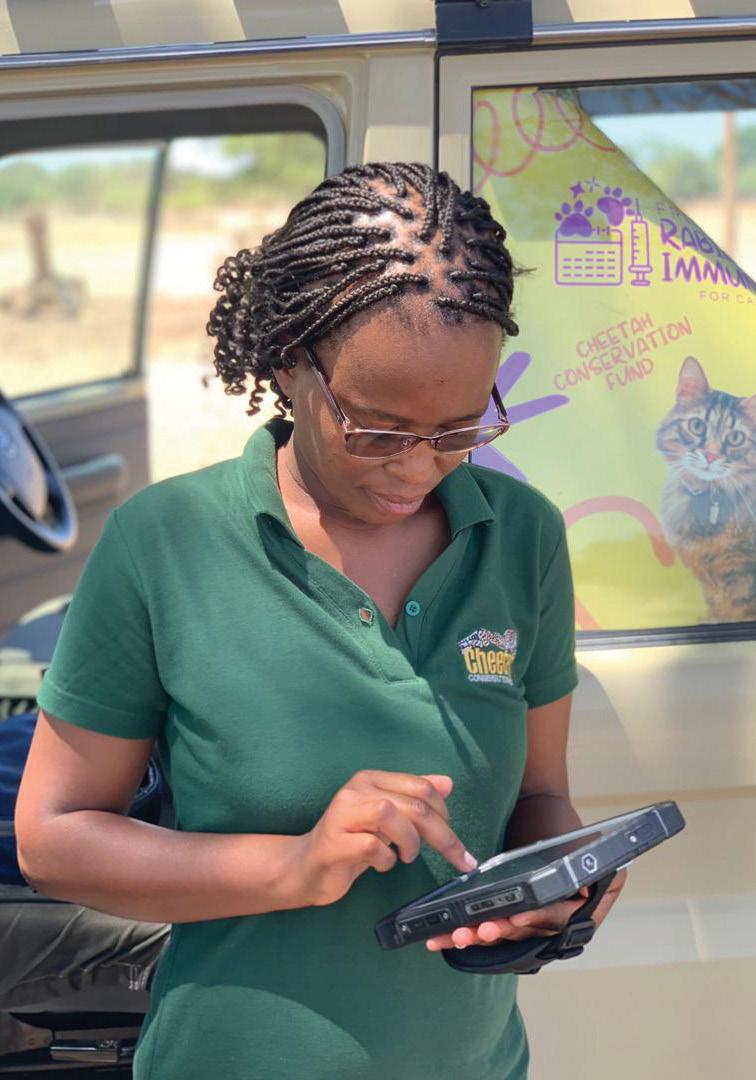
Set-up and vaccination
• Arrive at the respective village or homestead
• Set up the vaccination station
• Explain the vaccination process to the pet owners or caretakers
• Obtain informed consent
• Employ experienced techniques for physical restraint and vaccination to ensure safety for both animals and humans involved (not all dogs and cats are used to being touched)
• Fill out vaccination cards for each animal receiving the vaccine
Data collection and documentation
• Record all data in the GARC (Global Alliance for Rabies Control) app
• Compile a detailed report of the vaccination campaign
• Share vaccination data with government officials
Post-vaccination cleanup and review
• Clean and disinfect vehicles and equipment to minimise disease transmission risk
• Log disposable and medicine usage, place orders to restock if needed
• Store equipment neatly to maintain integrity
• File records
• Rest and start planning the next vaccination trip, which often begins less than a week after returning.
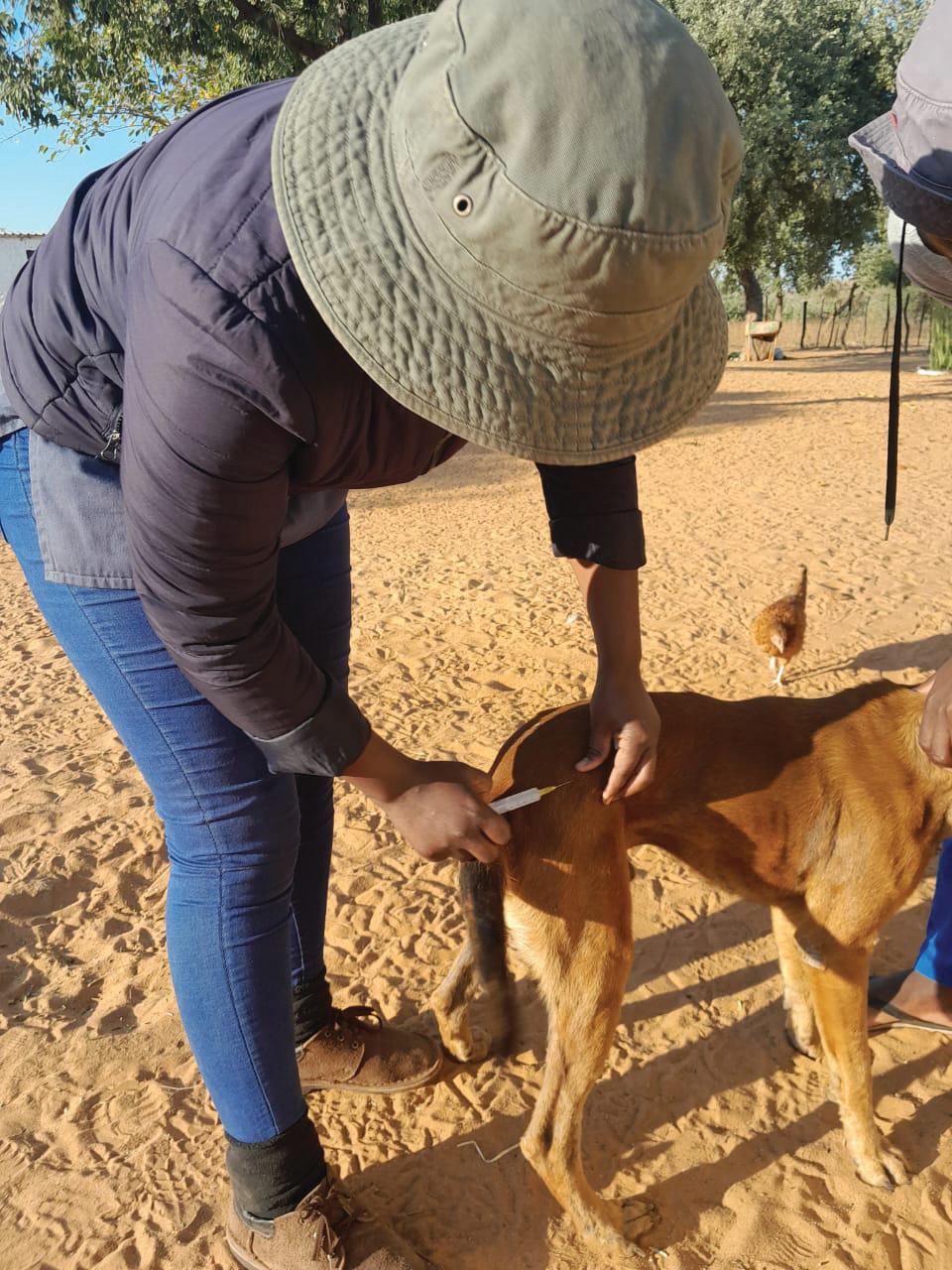
Recognising the scale of the rabies threat, CCF has cultivated partnerships with various stakeholders, including state veterinarians, local authorities and community leaders. Moreover, CCF is integrating its activities with national and global health strategies to align with the "Zero by 30" global strategic plan, which aims to eliminate human deaths from dog-mediated rabies by 2030. In 2024, we presented our work at the Namibian National Rabies Planning and Review Meeting and Workshop.
Since its inception, the programme has achieved significant milestones, including the vaccination of thousands of animals annually. Our efforts were briefly hindered by the COVID-19 pandemic but have since resumed with renewed vigour. In 2024, we were able to shift our focus toward more remote areas of the four conservancies, as the Okakarara State Veterinary Office began administering rabies vaccines to dogs and cats in densely populated areas close to their facilities. This shift means that CCF may vaccinate fewer cats and dogs than in previous years, but our team and the state veterinarian will jointly reach more communities and more animals in our target region.
Looking ahead, CCF plans to expand the scope of the vaccination efforts if we are able to secure more funding and resources for this programme. Our team is currently exploring the use of oral rabies vaccines for jackals and other wild carnivores that could potentially increase the reach and efficacy of the programme.
Vaccination programmes do not work without extensive community outreach efforts to raise awareness about rabies symptoms, transmission and prevention. CCF translates educational materials into local languages and distributes them during vaccination drives, complemented by education sessions that teach community members how to recognise and respond to potential rabies cases in animals.
CCF’s rabies vaccination initiative in Namibia exemplifies a proactive and holistic approach to disease control that integrates public health, animal welfare and nature conservation. With continued support and collaboration, this programme not only aims to curb the immediate threat of rabies but also to sustain long-term health and safety of Namibia’s communities and wildlife populations.
People around the world can help to extend our reach in rabies education. World Rabies Day on 28 September is recognised globally as a day to raise awareness about the prevention of rabies and to celebrate the efforts to stop the spread of the disease. You can participate by sharing information on rabies with your family and friends, or by finding out if you can help with vaccination campaigns where you live and by getting your own pets vaccinated.

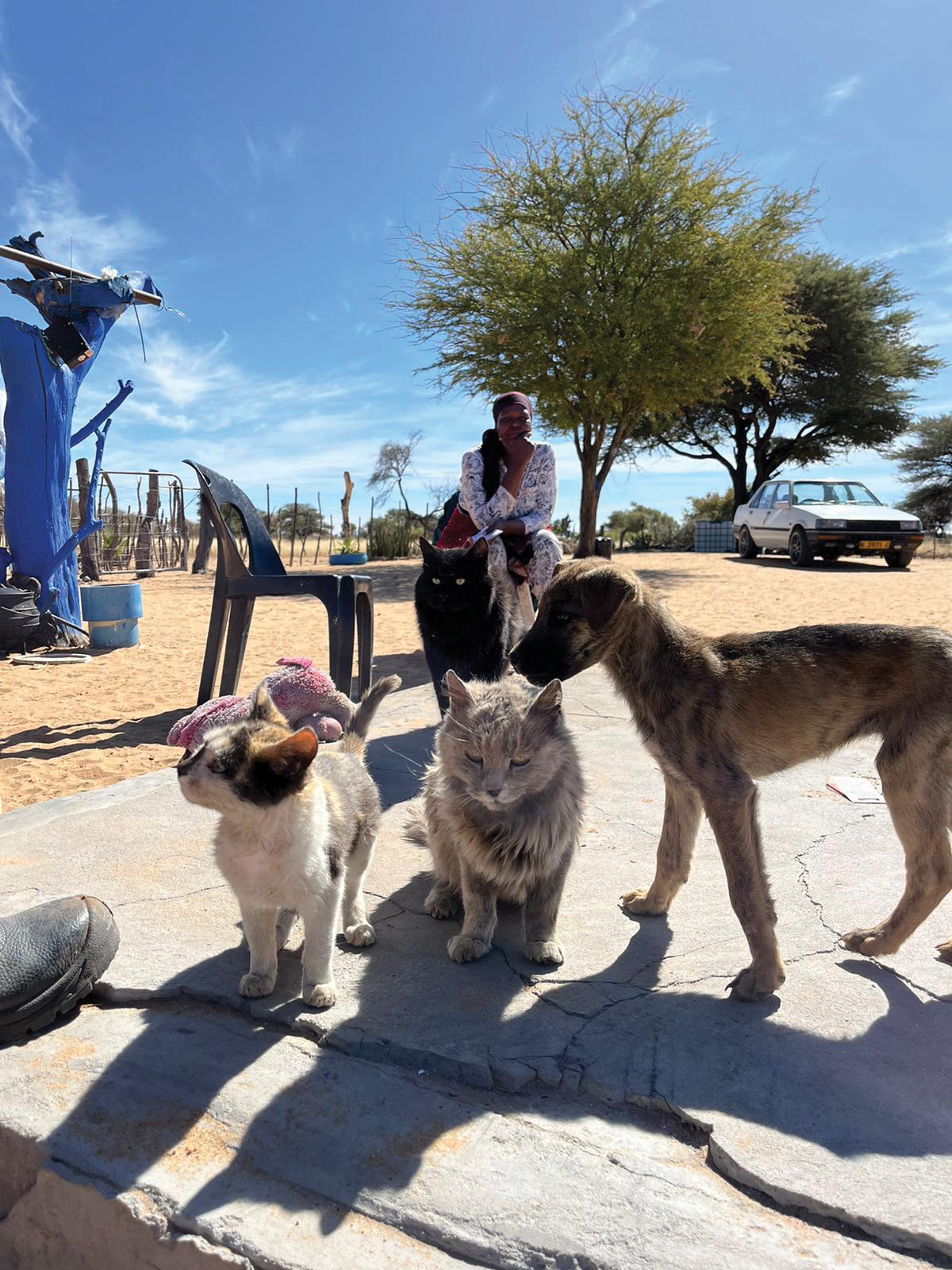

By Peter Cunningham
Namibia’s freehold farming areas are criss-crossed with fences. The shorter fences are designed to manage livestock movement, while higher ‘wildlife-proof’ fences prevent jumping antelope species like kudu from escaping. My ten-year study reveals that even short livestock fences can be deadly to springbok that try to jump over them in search of greener pastures.
Southern Namibia is predominantly a sheep-farming area, where farm boundary fences are used to keep predators out and sheep in, while internal fences are used to manage sheep grazing movements. Some farmers electrify strands of the boundary fence and use mesh fencing in addition to the normal strand wires in an effort to prevent jackals from entering the farm and preying on sheep. Electrification is known to kill a variety of small animals such as chameleons, monitor lizards, tortoises, pangolins and snakes.
Livestock fences and springbok
Even without the electrified strands, fences restrict the natural movement of springbok and gemsbok, which do not jump over low fences as easily as kudu and eland do. Although the farms in southern Namibia cover large areas (often more than 10,000 hectares), desertadapted antelope move over much larger areas in search of grazing. As they move through farmlands, they encounter fences that must either be avoided or jumped – the latter may result in death.
Having encountered dead springbok along fence lines in southern Namibia, I wanted to know how many springbok died, whether males or females were more likely to die on fences, and whether or not the rate of death was affected by rainfall and seasons. I therefore started recording springbok deaths along the boundary and internal fences of our farm south of Grünau in January 2015.
During the ten years since then, up until August 2024, I recorded the deaths of 20 male, 13 female and one young springbok. Besides springbok sex and date, I recorded the type of fence that caused the death – either the 1.4m high 6-stranded boundary fence, or 1m high 7-stranded internal fences.
Half of the male springbok deaths were caused by the high boundary fence, while 11 of the 13 female deaths were caused by the lower internal fences. This suggests that female springbok rarely attempt to jump the boundary fences, while the males attempt and fail on both the internal and external fences. I have watched springbok avoid jumping over pipelines as low as 70cm; it seems that all livestock fences are a challenging ‘high jump’ for springbok.
Seasons and annual rainfall affect death rates
The rainy season (December to March) proved more deadly for male springbok (three deaths per month) than the dry season (one death per month). Rainfall is extremely patchy in southern Namibia, as it mostly comes in the form of localised thunderstorms that drench one area while leaving adjacent areas virtually dry. Under natural conditions with no fences, springbok instinctively move towards patches that have had recent rainfall. While most female springbok seem to stop at 1.4m at farm boundary fences, males are apparently more likely to attempt the jump and subsequently get caught in the






top strands. It is also possible that male springbok attempt to jump fences to fight with other males in territorial battles.
A small spike in female deaths during the winter months – three in July and two in August – is somewhat harder to explain. I suspect that the scarcity of food at this time of the year is driving springbok to cover more ground to meet their dietary needs, which will bring them into contact with fences more often. Females may need to eat more than males due to the toll that pregnancy and lactation takes on their bodies, causing them to attempt jumping the 1m internal boundaries if necessary.
In the ten years covered by my survey, the highest annual death rate was seven springbok, recorded in 2019 and 2023. Those years were characterised by extremely low rainfall, with only 16 and 17 mm respectively (the average for the 10-year period was 60 mm per year). This suggests that springbok are especially desperate to find new grazing areas during such a time and are less likely to clear the fences in their weakened state. In good years, the springbok will be more likely to stay where they are and, even if they do attempt to jump the fences, will be more likely to clear the fence without being caught.
Besides the obvious effect of rainfall on springbok deaths, some deaths in fences may be related to predators, or humans and vehicles. Springbok may attempt to jump fences to escape real or perceived danger.
Consequences for springbok conservation and management
Is the springbok population in southern Namibia negatively affected by fence-related deaths? To answer this question, it is important to put the recorded deaths into context. Springbok numbers can increase by 40% in a year of good rainfall. I estimated that fences on our farm caused the death of about 10% of the springbok that occur here.
Fence-related deaths are therefore unlikely to cause a population decline in normal years, although years of bad rainfall lead to more fence deaths and lower reproduction rates. Farmers who aim to maintain stable springbok populations on their farms should factor in possible fence-related deaths when estimating hunting off-takes for their farms.
Following my observations of how springbok get caught in fences, I have some suggestions for slight changes in fence design to reduce the death rate. The top two steel wire strands frequently trap the springbok’s leg as it goes over the fence (see photo on page 56). For internal fences, I suggest setting the strands further apart – 300 mm rather than 200 mm – to reduce the chances of a springbok’s leg being caught between the top two strands. On higher boundary fences, the top three wires are typically 100 mm apart. Decreasing this gap even further, to 50 mm, may make it less likely for the leg to get between the strands in the first place.
A simpler option that will help in some cases is for farmers to leave camp gates open when no domestic livestock are present, so that springbok can move between camps without having to jump internal fences.
The records I collected over the past ten years helped me to determine the scale of the problem, while my observations of how the springbok were caught have led to some thoughts about how to improve fence design. I encourage other farmers to do the same. Record every dead springbok, including the sex and date, that you encounter while inspecting your fences, along with a photo that shows how it was caught (if possible). If you change your fence design, keep monitoring to see if it made a difference. Finally, use your records to determine the impact of fences on your overall springbok population and adjust your hunting off-takes accordingly.
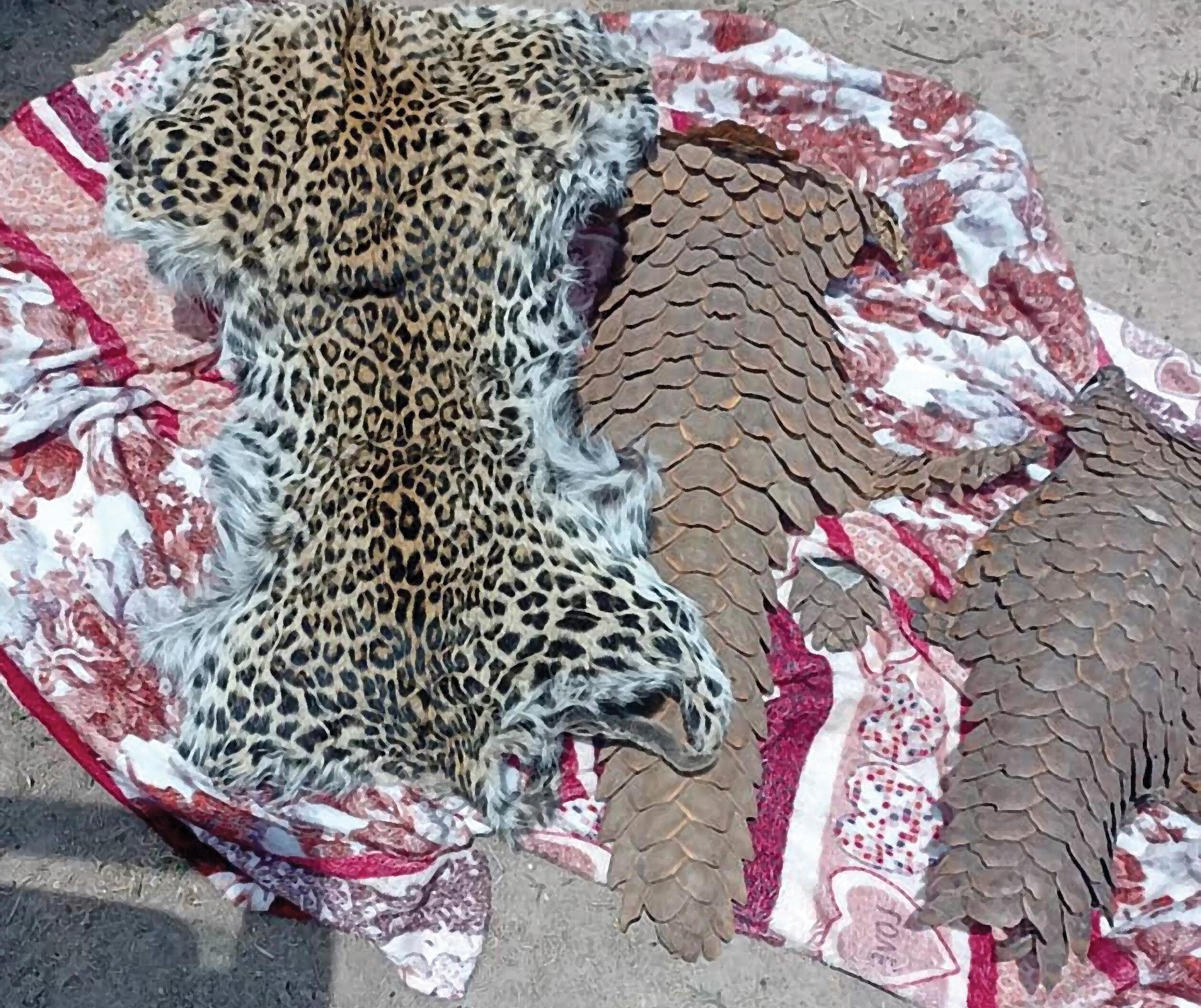
By Helge Denker
Independent Namibia has an excellent conservation track record, based on a sound legislative framework and pragmatic sustainable-use approaches. This has enabled healthy populations of most of the historically occurring wildlife in areas of suitable habitat. Namibia’s elephant population is at its highest in more than a century. The country is home to the largest population of black rhinos in the world, and the second-largest population of white rhinos. Wildlife is one of Namibia’s most valuable natural resources.
It is thus unsurprising that, in line with regional and global trends, wildlife crime has become one of the most prevalent criminal activities in Namibia. Between the start of 2015 and the end of 2023, a total of 2,567 cases related to wildlife were registered, and 5,502 suspects were arrested. The statistics are in part the result of a sudden, massive increase in wildlife crime, and in part due to increased law-enforcement. But there are other circumstances at play. These include public awareness and attitudes, increasing needs and changing lifestyle aspirations, availability of resources and evolving illicit markets.
What the statistics do not adequately portray, and what public condemnation of wildlife crime tends to ignore, is that the more than five thousand arrested suspects are people with emotions, families, social circumstances and financial needs. Some are proven repeat offenders, hardened ‘career criminals’. Others are opportunists, trying to get away with ‘a fast one’. Some are ignorant of wildlife laws. Many are acting in desperation, attempting to escape poverty and hunger.
Understanding what drives people to wildlife crime is an important step towards finding lasting solutions that do not rely solely on antipoaching patrols, fines and jail sentences. A more holistic approach that is more solution-oriented rather than problem-oriented will reduce Namibia’s human and economic costs of wildlife crime while including more rural Namibians in the wildlife economy.
Drivers of wildlife crime: Resource inequalities and other factors
Vast disparities exist between the rich and the poor in Namibia, which are regularly exacerbated by drought. A recent report projected that an estimated 1.4 million people in Namibia would face high levels of acute food insecurity by July to September
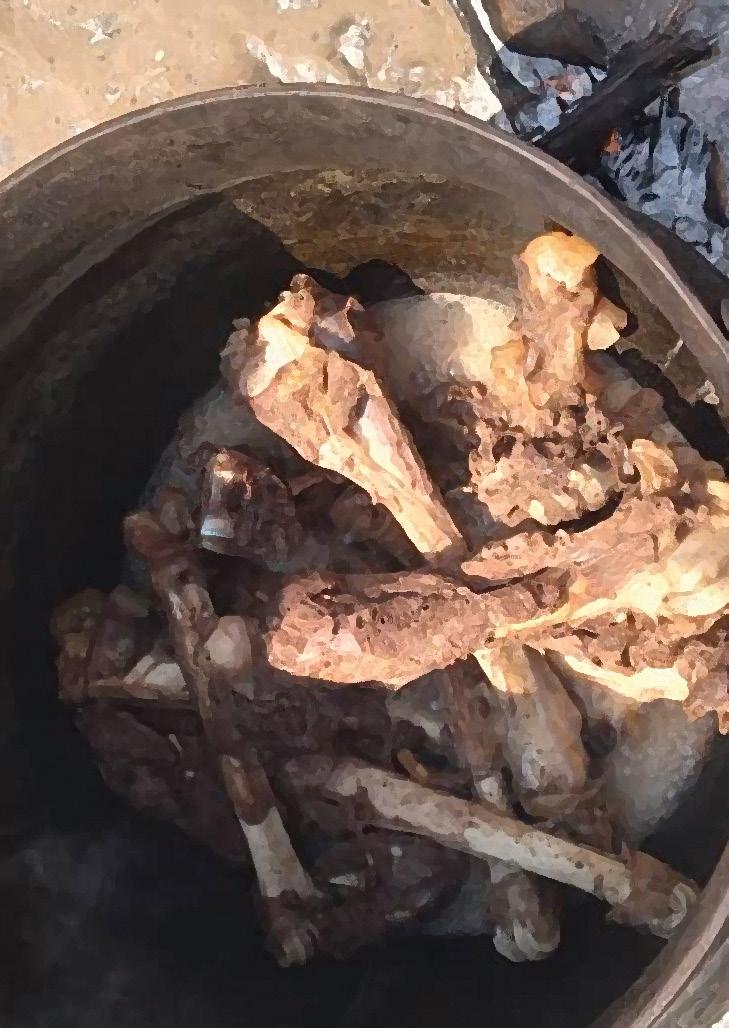
2024. Massive disparities exist regarding people’s access to natural resources, particularly wildlife.
Private landowners can reap substantial benefits from wildlife through tourism, hunting, meat harvesting or live game sales. Some staff on commercial farms benefit substantially from wildlife, many do not.
The opportunities of those who live on communal land are much more limited. Communal conservancies enable access to wildlife, but only for the community. Individuals may see returns through employment, occasional meat distribution, cash pay-outs or community development projects. These are important benefits which have done much to empower communities and facilitate a balanced coexistence with wildlife. But they stand in sharp contrast to the profits that private-sector operators generate, even on communal land. Communal resources are also increasingly appropriated and fenced off by non-residents, further increasing rural poverty.
Human–wildlife conflict is yet another factor complicating wildlife conservation. Healthy wildlife populations inevitably cause some conflicts, particularly in areas where wildlife coexists with farming. Wildlife legislation allows for the protection of human life and property against wildlife (based on stringent reporting requirements), but preventative or retaliatory killing of wild animals can be problematic. While freehold farmers have the necessary resources to effectively deal with problematic wildlife, communal farmers seldom do.
Many wildlife laws make the outcome of one activity illegal, but legal for another: Collecting and selling pangolins is illegal – electric fences that kill numerous pangolins are not (because they are supposed to



protect small stock from predators). Felling a rosewood to sell the timber without a permit is illegal – clearing entire stands to make way for agriculture is not.
These circumstances, coupled with the extreme poverty that is widespread across rural Namibia, create the conditions for wildlife crime to increase. Rural Namibians who live in poverty have few or no opportunities to benefit from wildlife legally. When they have suffered the loss of relatives, livestock, or crops to wild animals they will be sorely tempted to operate outside the law. Besides these internal local factors, international markets for traditional medicine, ornamental plants and exotic pets put a price tag on high-value species that lure people to poach in the hope of a better life.
A closer look at rhino, elephant and pangolin poaching Rhino horn, elephant ivory and pangolin scales are high-value products that demand high prices on international markets, which make them a target for international criminal syndicates. While local poachers receive much less money for these products than the middlemen sell them for, the money offered is often more than rural people earn in many months.
In recent years, Namibia has done very well with law-enforcement against rhino poachers and broader trafficking syndicates. This success is borne out by numerous arrests, including pre-emptive interventions that apprehend poachers while at the same time saving targeted rhinos. Prosecution of perpetrators of rhino crimes has, however, been much less effective (see graph on the bottom of page 61). Several initiatives have been launched to address the underlying issues and improve the case finalisation and conviction rates, including the establishment of a permanent Environmental Crimes Court at Otjiwarongo in August 2024.
Beyond improving law enforcement, rhino conservation in communal conservancies in the Erongo and Kunene regions offers a promising
approach to reducing rhino poaching. Extensive community outreach campaigns combined with active patrols by community rhino rangers, supported by national security forces has significantly reduced poaching in these areas.
Generating benefits from rhinos for the wider community is another key element to reducing rhino poaching. Rhino tracking is a highvalue tourism product that already contributes to communal conservancies and should also be established in national parks such as Etosha, Waterberg, Mangetti and Hardap to benefit people living around these parks. An added benefit of rhino tracking is increased monitoring of rhinos to detect poaching activities. Namibia should urgently explore this option to broaden tourism experiences, while enhancing wildlife values and strengthening wildlife protection.
Ivory prices have dropped over the past decade. Ivory is not nearly as valuable as rhino horn at present, yet elephant poaching remains a massive threat across Africa. While Namibia experienced negligible elephant poaching during the first decade after independence, over one hundred elephants were recorded as poached in 2016, motivating decisive government action. Since 2019, fewer than 15 elephants have been recorded as poached each year. Current losses no longer have an impact on the national population. The ongoing deployment of national security forces in an anti-poaching role to all key elephant ranges since 2016 is considered to be one of the main factors in this turn around.
Despite the significant drop in poaching losses, arrests related to ivory trafficking remain high in northeastern Namibia. The Zambezi Region is being used as a springboard for poaching incursions into Botswana and as a transit route for trafficked ivory. This was confirmed by collaborative transboundary investigations into seizures of large ivory shipments during 2023. Such transboundary law enforcement, combined with broader international collaboration, is vital to counter elephant poaching and ivory trafficking.
Annual arrests related to rhino poaching/trafficking

Current court case status as percentage of cases registered per year (rhino cases)

Annually registered vs. finalised wildife crime court cases (all cases)
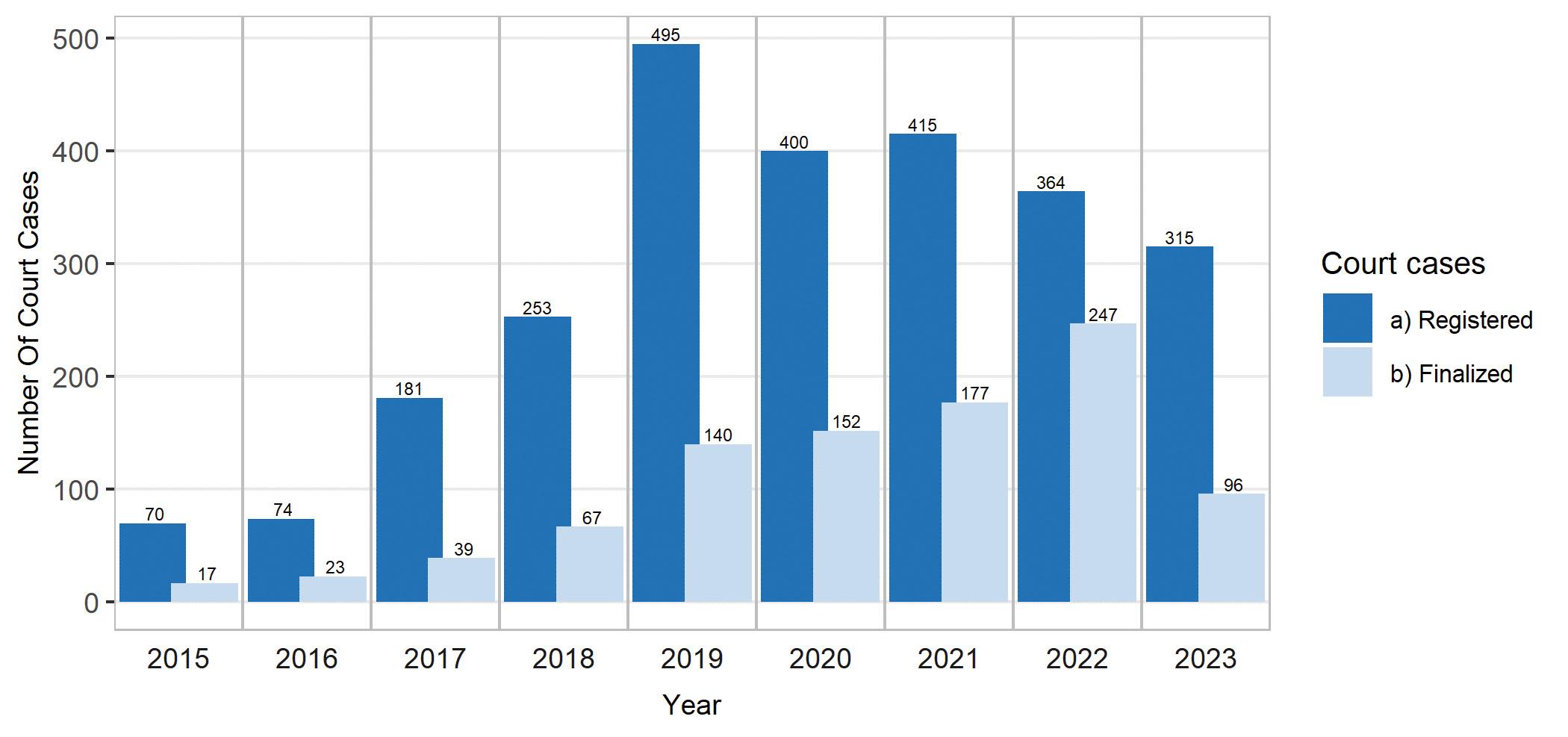

Although pangolins are considered the most-trafficked wild animals in the world, trafficking in Namibia currently does not appear to be extensively linked into global supply chains. Data related to international pangolin seizures indicates that most African pangolins being trafficked to Asia are white-bellied pangolins that originate from central and western Africa. The vast majority of pangolin poachers and traffickers arrested in Namibia are apprehended when the culprits seek to randomly sell pangolin products. No evidence of links to regional trafficking syndicates has been found, and pangolins of Namibian origin have not been confirmed as part of international customs seizures.
The motivation to pick up and try to sell pangolins appears to be opportunistic, driven by misperceptions of earning easy money. Consequently, awareness among rural communities needs to be created urgently to reduce trafficking. A significant dip in arrests involving pangolins occurred during 2022, linked to stern sentences that acted as a deterrent. Continually emphasising that potential rewards are low and risk of incarceration is high, while also building pride in pangolin protection, is likely to be an effective strategy.
Meat poaching is one of the most complex challenges in the Namibian wildlife-crime sphere, generally accounting for between a third and half of all registered cases. Yet it is important to explore and address the drivers of meat poaching. Wildlife is a traditional source of protein for most rural Namibians. During the colonial and apartheid eras non-whites were alienated from this tradition. The strict separation of freehold and communal land is another legacy of colonialism. Granting rights to wildlife after independence has done much to enhance community access to natural resources, but clear disparities persist.
Seen in this context, subsistence poaching for food requires nuanced approaches that seek to address poverty and equitable resource access, as well as enforcing laws. On the other hand, organised commercial poaching to supply meat to urban markets needs strict law enforcement, as it is driven by greed. Opportunistic transgressions, which people try to get away with ‘on the spur of the moment’, may be best countered by actively publicising that the risks are much greater than the short-lived rewards.
Some illegal meat or trophy hunts still occur on freehold farmlands despite existing regulations that allow these hunts. Most of these involve opportunistic avoidance of permit or reporting requirements, but some are more problematic. There is still an entrenched attitude among many freehold farmers and hunting operators that they are free to use their land and the wildlife that they own as they see fit. Also, there is still a global demand to obtain wildlife trophies ‘by any means’, with extreme prices paid for rare trophies. This combination has led to illegal and damaging activities which are being dealt with through active law enforcement to protect the legal wildlife sector and Namibia’s conservation integrity.
Nuanced law enforcement and empathetic sentencing
Wildlife crime has escalated to the extent that clashes between armed poachers and anti-poaching patrols are resulting in injuries,
and occasionally death. The escalating ‘arms race’ between crime and counter-crime makes such incidents inevitable, but shooting poachers for killing animals, even in clear self-defence, remains problematic. The effects of the increasing ‘militarisation of conservation’ have been the focus of much debate and research. An uncompromising approach to law enforcement can quickly create social issues, and nuanced handling of the great range of transgressions against wildlife is important.
Courts are faced with increasingly difficult decisions when seeking balanced sentences in wildlife cases. The seriousness of the crimes, the circumstances of the accused and the interests of the public often stand in an awkward relation to each other. Sentences often vary greatly, even for cases with similar circumstances, as courts struggle to find an appropriate balance. This can only be addressed through clear sentencing guidelines and ongoing awareness creation among law enforcement, prosecution and the judiciary regarding the complex dynamics and impacts of wildlife crime.
Most wildlife crime dynamics revolve around people’s attitudes to wildlife, interpretations of legality and rights and perceptions of ethics. What some use as a potent ingredient of traditional medicine, others perceive as the murder of innocent animals. What some treasure as a beautiful ornamental plant in their home, others perceive as the eradication of rare endemic flora from its natural habitat. What some condemn as despicable meat poaching, others experience as alleviation of hunger.
Namibia has proven that the sustainable use of natural resources enhances the value of those resources, and through this facilitates their conservation. The heightened value of wildlife through sustainable use has been an important enabler for rebuilding some wildlife populations (the white rhino is an excellent example). This premise begs initiatives
to legalise sectors that have high market demand, such as a legal trade in ivory (from natural mortalities) and rhino horn (from dehorning operations), or controlled supply for the ornamental plant trade (via registered nurseries). Such notions continue to be hampered by questions regarding effective control mechanisms to ensure legitimacy and sustainability, as well as uninformed international rejection – while species are being decimated at a rate that appears to make legalisation of their use inconceivable.
The notion of completely eradicating wildlife crime, often touted as a political battle cry, is utopian. When wildlife exists at the numbers and with the values it does in Namibia, some will attempt illicit profits. Wildlife crime in Namibia can be reduced to levels that do not cause significant harm to society, the economy or the resources being targeted. But that is only possible through holistic approaches that consider the needs of people alongside wildlife conservation.
Helge Denker is a Namibian conservationist, writer and artist. For the past seven years, he has been actively involved in interpreting wildlife-crime data and formulating internal and public information materials in collaboration with the Blue Rhino Task Team and the Rooikat Trust.
The graphs and photographs in this article are from the Government of the Republic of Namibia. 2024. Wildlife Protection and Law Enforcement in Namibia: National Report for the Year 2023. The full report can be downloaded by scanning the QR code or visit: conservationnamibia.com/other/

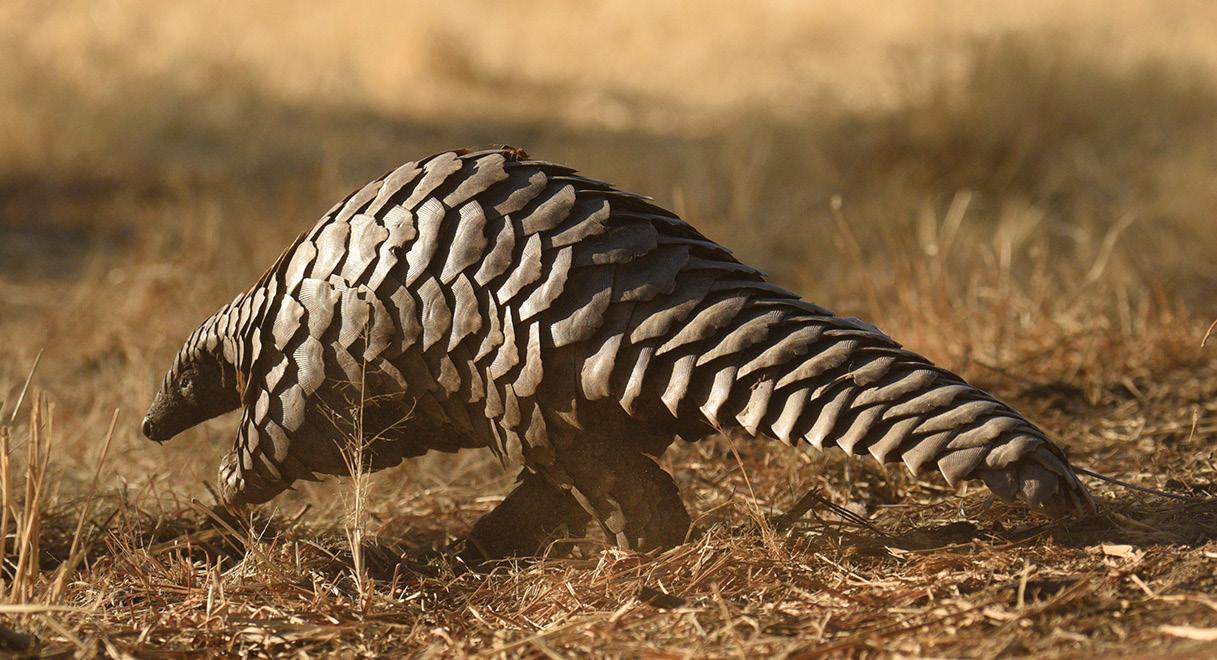

By EduVentures Trust and Namibia Institute for Democracy
Teachers across Namibia are learning to protect their environment, grow their own food and get involved in democratic processes related to sustainable development. As they pass their newfound knowledge of civic and environmental education on to their learners, teachers encourage the next generation of Namibians to make their country a better place.
EduVentures offers training courses on education for sustainable development to hundreds of teachers – and by extension thousands of schoolchildren – through its EduLink programme. In the first phase of EduLink, nine environmental education centres across Namibia were included in a network to promote education for sustainable development. Courses held at these centres reached teachers from all 14 national regions.
The EduLink curriculum included intensive tuition on biodiversity, sustainability, community-based natural resource management (CBNRM) and ocean literacy. Where possible, the courses included field trips for educators to gain firsthand information. Visiting a Namibian communal conservancy, for example, allows teachers to meet people who understand how CBNRM works in practice, thus increasing the depth and accuracy of the information they pass on to their learners.
Ultimately, these courses benefit Namibian children. Each course includes ideas for hands-on classroom or outdoor activities that teachers can use to make learning fun for school children. Topics that can seem abstract or boring can be brought to life and applied in daily life. For example, the Sustainable Development Goals game merges physical activities with informational flash cards to introduce learners to each goal in a highly memorable way.
Following the success of EduLink phase one, EduVentures launched EduLink 2.0 with renewed support from Solidaritätsdienst International (SODI) Berlin. The second phase of EduLink expanded its reach to include one more partner organisation(s) – i.e. the Namibia Institute for Democracy (NID) – an extra education centre and three new topics for the curriculum: agroecology, the One Health approach and civic education. Since its launch in late 2021, the team has reached 333 teachers from 180 schools, indirectly involving an estimated 9990 children.
Civic education explains the rights and responsibilities of citizens in a democracy, revealing how government processes work and how ordinary Namibians can engage with them. Since many policies and decisions at national and regional levels affect sustainable development, civic education galvanises environmentally-aware citizens to advocate for a sustainable future.
“Our work at the NID includes a strong focus on voter education that explains how each citizen can make a difference locally, regionally and nationally,” explains Ndemufayo Kaxuxuena of NID. “Our partnership with EduVentures created an opportunity to reach educators and teachers who will help Namibian children to understand democratic principles and their role in society. These children are our future leaders in political and civil society.”
Agroecology is a way of growing gardens and crops that works with nature and is adapted to local socio-economic and ecological conditions. This course provides teachers and unemployed young people (identified by participating schools) with the knowledge they need to make gardens and produce food for their schools and communities.
The One Health approach is endorsed by the World Health Organisation to address human, livestock and ecosystem health



as an integrated whole. In this course, teachers find out that environmental health is closely linked with the outbreak of diseases and other health problems that affect people and livestock. Maintaining a clean environment by reducing plastic pollution and open defecation, for example, can improve community health.
Maria Johannes of EduVentures hailed these new courses as a success: “We learnt a lot from our partners at NID during their civic education courses, which were well received by the teachers and educators in our network. Our agroecology and One Health subjects encouraged teachers to implement projects at their schools, such as gardens and waste management.”

EduLink goes beyond training sessions to create lasting clubs and networks that put new knowledge into practice. The ten participating environmental education centres are part of a national network supported by the EduLink team. Each of these centres received computers, WiFi routers and SMART boards for interactive lessons. This equipment enables centre staff to access a wealth of information and courses on the Internet, including the EduLink curriculum and all project educational materials. The network uses Google Classroom as a learning management system to share ideas, ask questions and provide long-term support.
“Using technology is the way of the future”, says Job Tjikongo, an environmental educator at EduVentures. “By connecting education centres and schools to the Internet, EduLink brings global knowledge and ideas into classrooms in remote parts of Namibia.” These efforts help to close the ‘digital divide’ that makes it difficult for African

teachers and learners to keep up with technologically advanced countries in other parts of the world.
At the local school level, teachers establish environmental clubs known as EduCircles that focus on practical activities outside the normal classroom setting. These include getting more involved in lobbying and advocacy on environmental and socio-economic issues in their communities, thus putting their civic education to good use.
Following the agroecological training course, eight teachers successfully applied for funding to establish greenhouse gardens at their schools. The unemployed youth who were trained at the same time can work in these gardens and sell some of the produce to generate income. One teacher built a chicken coop, while another established a waste management centre following their successful funding proposals. Each project has the potential to become financially self-sustaining while demonstrating the principles of the EduLink training courses.

Although the EduLink project will wind up in early 2025, EduVentures and their partners will continue to support the networks and clubs that were established during the programme. “The EduLink project took us on a journey of discovery and expansion”, declares Maria Johannes. “While it is coming to an end soon, we are looking eagerly to the future to find new ways of supporting the teachers and educators in our network.”
The network of environmental education centres will continue to support each other and reach out to schools within their regions and beyond. The hi-tech Ombombo mobile classroom – a truck containing equipment that is rarely seen in Namibian schools – takes the EduVentures team and their educational approach to every corner of the country. Meanwhile, the EduVentures home base at the National Museum of Namibia in Windhoek will continue to introduce children to their cultural and natural heritage through regular school visits.
Collaborating with NID opened new opportunities to link civic and environmental education, thus strengthening both endeavours. The EduCircles created in towns across the country will use their knowledge of government processes and policy to advocate for positive change in their communities. Engaged citizens – both teachers and children – will use their collective voices to drive sustainable, inclusive development.

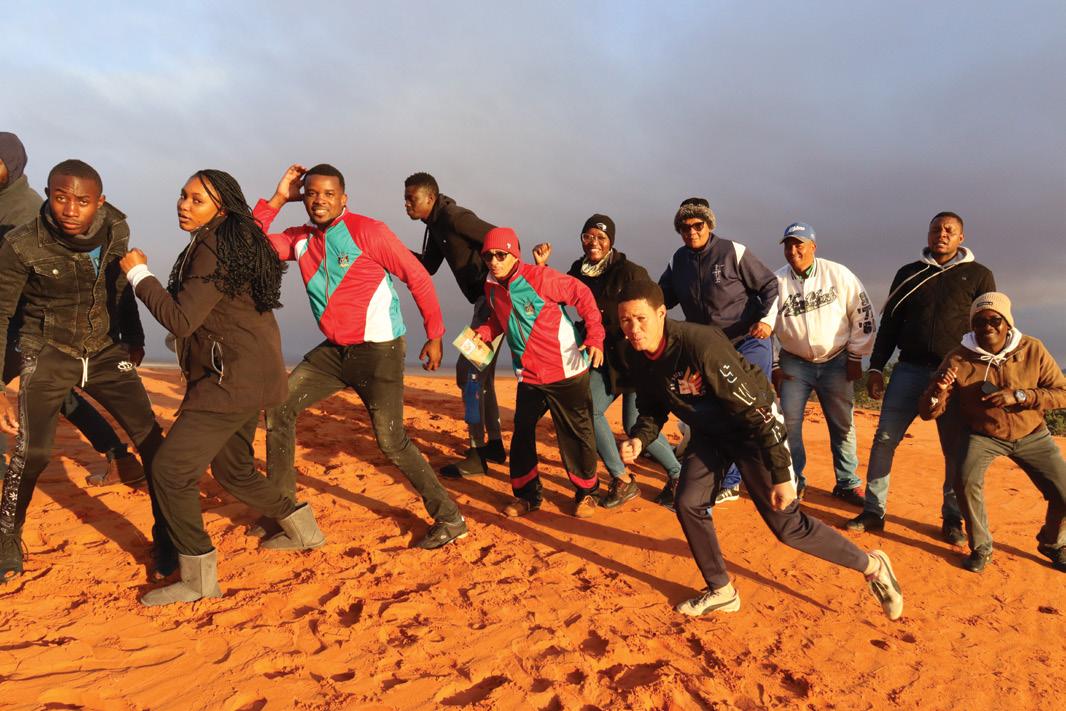



When the Sustainable Wildlife Management (SWM) programme started in 2021, Namibia was coming out of its third devastating drought in eight years. Today, we are in our fourth, highlighting the need to support food security and promote wildlife conservation simultaneously – the main objective of the SWM programme.
The SWM programme is a global initiative involving 15 African, Caribbean and Pacific countries, funded by the European Union with co-funding from the French Global Environment Facility. The Food and Agricultural Organisation (FAO) is the lead implementing agency globally, working with local partners in each target country and the relevant national government institutions.
In Namibia, this four-year initiative involves 13 community-based organisations, including 12 communal conservancies and the Kyaramaçan Association in Bwabwata National Park. It aims to strengthen community-led efforts to reconcile the conservation of wild species with food security while at the same time improving local livelihoods in the Kavango-Zambezi Transfrontier Conservation Area (KAZA). The programme is also being implemented in Botswana, Zambia, and Zimbabwe, as well as other KAZA member states (Angola will be included in the programme starting next year).
Coexisting with wildlife is a constant challenge in communal conservancies, but it becomes even more difficult during drought years. With support from the SWM programme, George Mukoya and Muduva Nyangana conservancies revised their Human Wildlife Conflict (HWC) Mitigation Plans during a workshop in February 2024, improving their capacity to manage HWC and enhancing the positive perception of wildlife.
On a village level, predator-proof livestock enclosures (kraals), which provide safe havens for cattle at night and peace of mind for villagers, were constructed in Bamunu, Wuparo, and Salambala conservancies.
Seventy-two 50-kg steel wire rolls for the assembly of elephant tin fencing were provided to nine conservancies in the Zambezi Region. The tins attached to the fences rattle when touched, helping to deter elephants from raiding crop fields.
Crocodile fences erected around certain spots in a river provide a crocodile-free area for people to access water and for children to swim safely. The SWM programme financed the construction of six crocodile fences in the Kwando Conservancy and two in Wuparo Conservancy, while materials for three more crocodile fences were provided to the Mashi Conservancy.
The SWM programme also invested in building human capacity. Quota-setting workshops were held to ensure that conservancies and their partners set sustainable quotas for the 2023-2025 period. More than 100 game guards from several conservancies, including Wuparo, Dzoti, Balyerwa, Mashi, Salambala, George Mukoya and Muduva Nyangana, were trained or retrained to report on HWC incidents using the SMART mobile app – replacing the paper system used until now.
Planting chillies around fields and burning chillies are known elephant deterrents that help to keep them out of villages and away from crops. Members of the Muduva Nyangana Conservancy were trained to make chilli bombs to help mitigate human-elephant conflict.
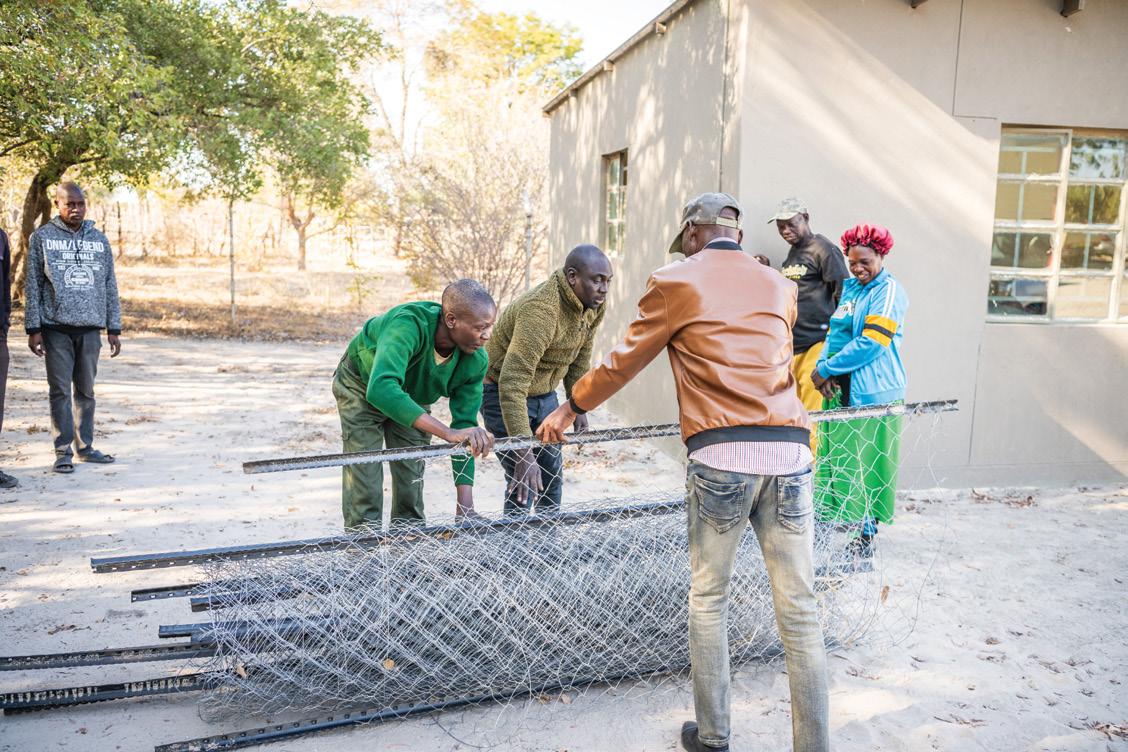







Since most conservancy members’ livelihoods are linked to subsistence agriculture and the use of natural resources, income diversification and food security are often intertwined.
In some conservancies, chilli production was applied to human wildlife conflict mitigation, while in others, it was piloted as a means of income diversification. With a willing chilli buyer identified, the programme supported the development of a value and supply chain for chilli production in Kwandu, Mashi, Balyerwa, and Wuparo (all in the Zambezi Region).
Community members from Muduva Nyangana and George Mukoya conservancies in Kavango East visited the Zambezi Region to learn more about chilli farming as an alternative income-generating activity as well as how to apply it around their crop fields to reduce elephant incursions. These two conservancies received additional training on conservation agriculture practices, including small stock management.
Game meat is recognised as an important part of the rural diet, and a resource that benefits communities when used sustainably. Conservancy members receive game meat as part of their conservancies’ agreements with professional hunters, but it is difficult to keep this meat for long periods without refrigeration. The SWM programme therefore purchased three 95-litre solar powered freezers for the Kyaramaçan Association and trained 13 community members on how to use meat processing equipment. An additional twelve 650-litre freezers were procured and distributed to nine SWMsupported conservancies in the Zambezi Region, the two Kavango East conservancies and Nyae Nyae.
Other projects aimed at improving food security and diversifying livelihoods focused on domestic animals. In Dzoti Conservancy, several years of support in rangeland management and livestock production is now being expanded with development of a small feedlot to improve animal body condition prior to being sent to the Meatco Abattoir in Katima Mulilo. Finishing at feedlots increase the price received per animal, thus increasing the profits from livestock farming. A poultry production mentorship programme was supported in Bamunu, Kwandu, Mayuni and Mashi conservancies. In the Kavango communal conservancies, 72 community members (mostly women and youth) received training on goat management.
For over 10 years, devil’s claw harvesting has been a consistent source of income for many conservancies, but the positive impact is being undermined by illegal and improper harvesting in Bwabwata National Park, where the Kyaramaçan Association is located. Incorrect harvesting practices kill the plant, whereas the correct practice does not and is therefore sustainable. SWM programme staff provided pre- and post-harvesting training to members of the Association to supervise harvesting activities and deter illegal harvesters.
Large landscape conservation
Recognising that the lives of rural communities and indigenous people are deeply connected to the health of the land, the SWM programme includes projects aimed at restoring natural ecosystems. The area covered is vast, and the pressures are varied and exacerbated by the impacts of climate change. However, the conservancy structure allowed for rapid rollout of interventions with a population of informed, involved citizens.
The SWM team in Namibia shared their knowledge from our conservancy system with colleagues across KAZA, particularly those in Botswana. Wild Entrust is implementing SWM with Habu village and other communities on the western boundary of the Okavango Delta. These communities aspire to establish community-run wildlife management areas, using lessons learned from the Namibian conservancy model.
In Namibia, the programme supported the Kwando Fish Survey, which provided evidence suggesting that the recently proclaimed fish reserve in Mayuni is an important spawning ground for fish. Salambala was supported in their efforts to gazette their first inland fisheries reserve, and two fish stock surveys for the Kwando River were conducted in 2023. These efforts help to protect and restore river ecosystem health, providing protein through sustainable fishing and income generation through sport fishing.
Several key wildlife corridors have been established in the Zambezi Region, allowing wild animals to move through the KAZA landscape more easily. The integrity of these corridors depends on local communities not settling or planting crops in these areas. To increase local understanding of the purpose and importance of these corridors, the SWM programme developed and distributed awareness materials in local languages. Furthermore, 11 conservancies were engaged in adaptive management consultations, whereby data on poaching, wildlife numbers and other metrics are used to guide management actions for the coming year.
In a similar effort to inform the wider community of wildlife management actions, a radio campaign was used to announce villagelevel consultations in Nyae Nyae Conservancy. These consultations laid out the zonation plan within the conservancy’s Game Management Utilisation Plan, which indicates separate zones for human settlement and wildlife. Signage for the Wildlife Sanctuary Zone was installed to ensure that people on the ground know where the boundaries of this zone are located.
Behind every number presented here is a face, a family, and a hope for the future. The impacts of these projects on these individuals are starting to be felt, and beginning to be trusted. Over the years, projects such as some of these have come and gone, leaving local people wondering if these efforts will last.
However, the SWM programme is not a one-off effort, as the conservancies and support organisations working in this landscape have been here for several decades. As this phase of support comes to an end, these partners will continue to work together and source new funding to sustain our positive impact for many more decades.
WWF Namibia is lead implementing partner of FAO for the Namibia component, working with three partners: Integrated Rural Development and Nature Conservation, Namibia Nature Foundation, and the NACSO Natural Resource Working Group. This programme is funded by the French Development Agency (AFD) with co-funding from the European Union through the SWM Programme. The Center for International Forestry Research and World Agroforestry, the French Agricultural Research Centre for International Development, and Wildlife Conservation Society are consortium partners.
By Helge Denker
Postage stamps have very quickly receded into redundancy in public consciousness. Digital media have so completely displaced all handwritten communication that most people simply no longer use, or even see, postage stamps. A number of acquaintances have told me that they no longer have a physical postal address (in Namibia, this would be a post box at the nearest post office), and I wonder how many children even know what a postage stamp is.
For more than a quarter century, I have designed postage stamps for NamPost. When my first series of stamps was published in 1998, it was the early days of the Internet and email. WhatsApp and similar messaging applications did not yet exist. People still wrote letters, tourists still sent stacks of postcards. There was broad public interest in postage stamps – and what they depicted and represented.
At the time, stamps were seen as miniature ambassadors. They portrayed the heritage of their country of origin. Stuck on postal items as a marker of postage paid they travelled out into the world, creating awareness and promoting their country, its attractions and pertinent issues. Namibia was deemed particularly effective at producing high-quality philatelic products (i.e. stamps, first-day covers, souvenir sheets, etc.), and was recognised internationally for the beauty of its stamps, twice winning the Most beautiful stamp in the world award at the Stamp World Cup
Initially, Namibia’s annual stamp programme always featured a mix of environmental, cultural and social themes and issues (examples include the Cuvelai Drainage System, traditional wooden vessels, health challenges such as AIDS, and pertinent issues such as endangered species). As interest in stamps began to dwindle, the focus shifted more and more to themes most popular among collectors. The majority of Namibian stamps now depict indigenous fauna and flora, with birds being one of the most popular themes. The number of stamps issued per year has dropped by more than 50 per cent, and print runs have been reduced to less than a third of past quantities.
I receive enquiries from a wide range of special interest groups, including cat enthusiasts seeking further information on stamps
featuring Namibia’s wild cats, or geographers who would like to verify the names of mountains shown as part of background landscapes (my artwork generally depicts actual Namibian scenery, and I can thus provide the names of prominent topographic features). Yet the greatest degree of interest has been shown by birders. A dedicated website, birdtheme.org, endeavours to catalogue all official stamps depicting birds. They don’t necessarily need to be the main subject of the stamp, but may appear somewhere in the background. Since birds are a feature of most environments, many of my designs depict birds, perched or soaring somewhere in the background.
Requests for information have led to interesting and at times humorous exchanges. A stamp depicting a small herd of desertadapted elephants in the Hoarusib River (part of the series Ephemeral Rivers of Namibia) evoked particular interest. An eagle is perched on an open branch in a tilted ana tree behind the group of elephants. Although distant, and on the stamp only discernible in detail through a magnifying glass, the bird clearly has a white breast, a dark head and dark wings. This basic description fits the Martial Eagle as well as the Black-chested Snake Eagle, both of which can be encountered in this part of Namibia. But the bird is just too far away to clearly distinguish it as either one or the other. It would need to take flight to show the colour of its underwings (dark for Martial, pale for Snake Eagle), or the viewer would need to get closer – which is not possible because of the elephants. I love such dynamics and left the identification open in my response to the query with this very same reasoning (which the birders did not seem to find quite as amusing as I did).
Such correspondence, and in many cases follow-up articles written about the stamps in special-interest publications, undoubtedly increase awareness of the topics. Yet, to what extent any real awareness is created among the broader public is unclear (as with so many awareness initiatives). Whether stamps have value for being used as teaching aids in schools was recently explored through research, in this case with a specific focus on insect and arachnid (spiders, scorpions etc.) stamps. The findings are less than encouraging. Thirty percent of stamps issued globally between 1891 and 2020 were considered scientifically unreliable, while the overall focus was found to be highly biased towards the orders of butterflies and moths, and dragonflies and


–



All philatelic products courtesy of
damselflies. The author called for standardisation and quality control to improve the accuracy of stamps featuring these lesser-known animals. While accuracy is important, it should be remembered that stamps are not intended as scientific representations, but rather as creative interpretations of a subject. At NamPost, the interpretation of a theme is largely left to the artist’s discretion, although it is expected that adequate research is done to ensure accuracy.
I always try to make sure my work is accurate: in the art itself, the text on the stamps and the information inserts that accompany firstday covers. The images, as well as the overall themes, are based on meticulous visual and literature research. But mistakes do creep in. In one case, a stamp I had designed was reprinted (after consultation with scientific and philatelic experts), because the pygmy sperm whale it depicted had been reclassified as belonging to a new scientific family. During my research, I had neglected to consult the most recent literature. Therefore the stamp text, based on earlier literature, was incorrect according to the scientific status of 2019. The reprint created some additional novelty value for collectors, as such issues always elevate the rarity status of the stamps in question.
Irrespective of public awareness, postage stamps do serve as a historical record, and also create a stimulating juncture between science and art. For many, the two may appear at opposite ends of the human spectrum of exploration and endeavour, even more so since social media has spread mistrust of science among a broad sector of society. Art seems to be driven by feeling and intuition, by a yearning for personal expression. Science is supposed to be impartial and devoid of emotional interpretation.
Yet others see a clear interface between science and art. For a long time, art, in the form of highly detailed illustrations, was an important aspect of portraying scientific findings. While photography and digital graphics have displaced hand-drawn illustrations for most applications, some sectors continue to utilise art. Cornell Lab of Ornithology Director, John Fitzpatrick, makes a strong case for art in relation to science: “One of the really important things to acknowledge about science and art is that they actually are coming from a very similar, if
not the identical spot inside us; which is this fundamental curiosity about nature, expressed simultaneously both in science and art; and ornithology is one of the best places where that comes through.” Field guides with hand-drawn species illustrations certainly continue to be a prominent feature of ornithology.
There is undoubtedly a broad interface between art and science, with both requiring much thought and creativity. But stamps no longer play a notable role here, not as mini-ambassadors, not as symbols of postage paid – and not even as valuable collector’s items. People trying to sell their grandmother’s comprehensive stamp collection quickly find out that there are few takers, and that the value of most stamps is much lower than expected. The concept of crypto stamps (non-fungible tokens based on postage stamps, sold as digital collectables) is now being explored, but appears to be little more than a gimmick attempting to prolong the tradition of stamp collecting. The dominance of the Internet and its social media platforms continues to expand. In this context, the selfie has sadly become the most widespread token of exchange.
Where the digitisation of everything leaves original art, created with paint, pencil or such, on paper or canvas, is unclear. Similarly, where will computer-generated interpretation leave science? E.O. Wilson already commented 26 years ago: ‘We are drowning in information, while starving for wisdom.’ Unless there is a shift away from digital media for at least some of our communications, back to sending letters or postcards through the mail, a renaissance of the postage stamp is highly unlikely. This likelihood is further reduced by the increasing inefficiency of physical mail, not just in Namibia, but worldwide. Original art has captured its own little social media niche, but only in that very superficial thumb-flick-scroll kind of way. In public awareness, science finds itself in a similarly superficial position.
Helge Denker is a Namibian conservationist, writer and artist. He has designed well over 400 postage stamps as part of more than 100 issues for Namibia.
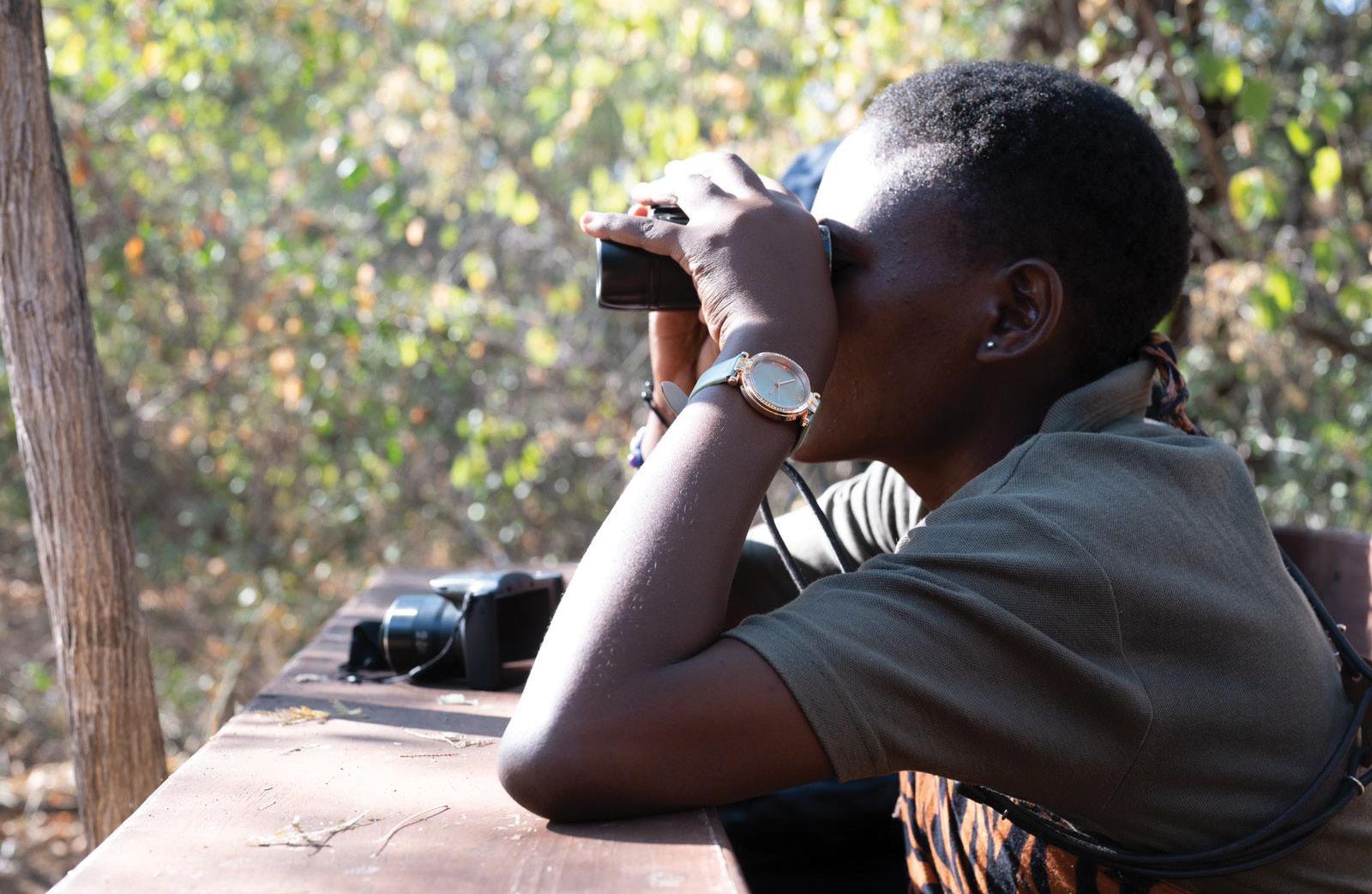

By Trendy Masule and Gail Thomson
The Namibian Youth Chamber of Environment (NYCE) was established on 14 June 2024 as the youth branch of the Namibian Chamber of Environment (NCE). NYCE is an active, youth-driven network of dedicated and passionate individuals focused on promoting conservation initiatives in Namibia. We aim to use this platform to transfer the knowledge and skills from the current generation of conservation experts to young people, inspiring a new generation of conservationists and environmentally aware Namibians.
NYCE is on a mission to create a leading and impactful youth-driven organisation in the conservation space that will actively advocate for environmental conservation and sustainable development across all sectors of Namibian society. We envision NYCE as an inspired group of young Namibians with the confidence and skills to chart a sustainable future for their country.
OBJECTIVES AND ACTIVITIES
NYCE provides training and mentorship to Namibian youth by running webinars and other in-person events during which invited experts discuss their respective fields of expertise with members. Thus far, we have hosted three webinars: Hygiene and Sanitation with Development Workshop Namibia; Advocacy for Sustainable Development with Namibia Institute of Democracy; and a panel discussion on Tourism and Conservation vs. Green Hydrogen and Oil.
Like its parent body, NYCE facilitates access to environmental information through education, collaboration and communication. The NYCE Instagram account shares short videos, photos, and other
graphics on environmental issues to engage with young people across Namibia and encourage them to get involved.
In the near future, NYCE will develop and implement feasible and impactful outreach programmes, involving our members in practical ways. These include clean-up campaigns, tree-planting days, awareness campaigns and other activities held across the country. Our leadership group will raise funds to finance more excursions and activities to bring members from different parts of the country together to encourage collaboration and camaraderie.
The new NYCE website – launched in September – will focus on drawing broader attention to national threats to ecosystems and species using the creativity of young people. With funding from NCE, we hold regular competitions with prizes for essays, photo-essays, artworks, videos, music, and more on specific environmental themes. The first of these competitions was for the best-designed logo for NYCE, won by Nicole Benade, who produced a stunning logo that was voted the best entry by NYCE members via WhatsApp. The second competition challenged young people to develop creative ways of recycling and reusing everyday waste, won by Klaudia Nghitevelekwa, who turned waste into art.
In only four months, the NYCE has grown to a membership of 112 individuals and two youth organisations, with approximately 160 individuals joining our broader WhatsApp group. Our registry reveals that 64% of the NYCE members are female and 45% are students. Most of the NYCE members are based in the Khomas and Zambezi

Regions where NYCE members are based. Note that many of them work or study in these regions, but come from elsewhere in the country.
Regions, while Otjozondjupa, Erongo and Omusati are also wellrepresented; only Kavango West and //Kharas are missing. Ultimately, NYCE aims to attract members from all 14 regions of Namibia.
NCE and Felines Communication and Conservation jointly support a permanent Youth Coordinator, Trendy Masule, to provide secretarial services for the NYCE. Leadership and direction are provided by a voluntary team of 17 elected representatives, which currently include the president (Punaete Kandjii), vice-president (Tristan Kolling), secretary general (Ottilie Fillipus), eight regional coordinators and four secretaries. The regional leadership team is set to grow as NYCE’s membership expands in each region.
This team provides direction for the youth chamber by generating new ideas for webinars and competitions, recruiting new members, partnering with other organisations and institutions, marketing and networking, among other duties. The current structure and function of NYCE will be formalised through a constitution, which will be presented at the first Annual General Meeting, to be held in 2025.
Membership is open to any Namibian between the ages of 18-35 who is passionate about conservation and committed to implementing NYCE’s activities. Membership levels (Bronze – African penguin; Silver – Welwitschia; Gold – Heaviside’s dolphin; Platinum – cheetah) indicate the commitment displayed by each member. The levels are unlocked by members organising or participating in activities, such as giving school or community environmental talks, contributing their photographs, videos and essays for the NYCE website, hosting or attending webinars and collecting atlas data on biodiversity. Each year, members will be issued certificates reflecting their membership level.
Being a NYCE member comes with several benefits, especially relating to job seeking and career advancement. Active members who produce content for the website can showcase their talents to a wide audience. These outputs can be included on their CVs, reference letters, and become examples of their work for future employers. Members who participate in webinars and talks will further distinguish themselves as potential employees who think about environmental issues and can articulate their ideas. The WhatsApp group regularly posts job opportunities, bursaries, scholarships and other competitions, creating a networking environment for young professionals and students.

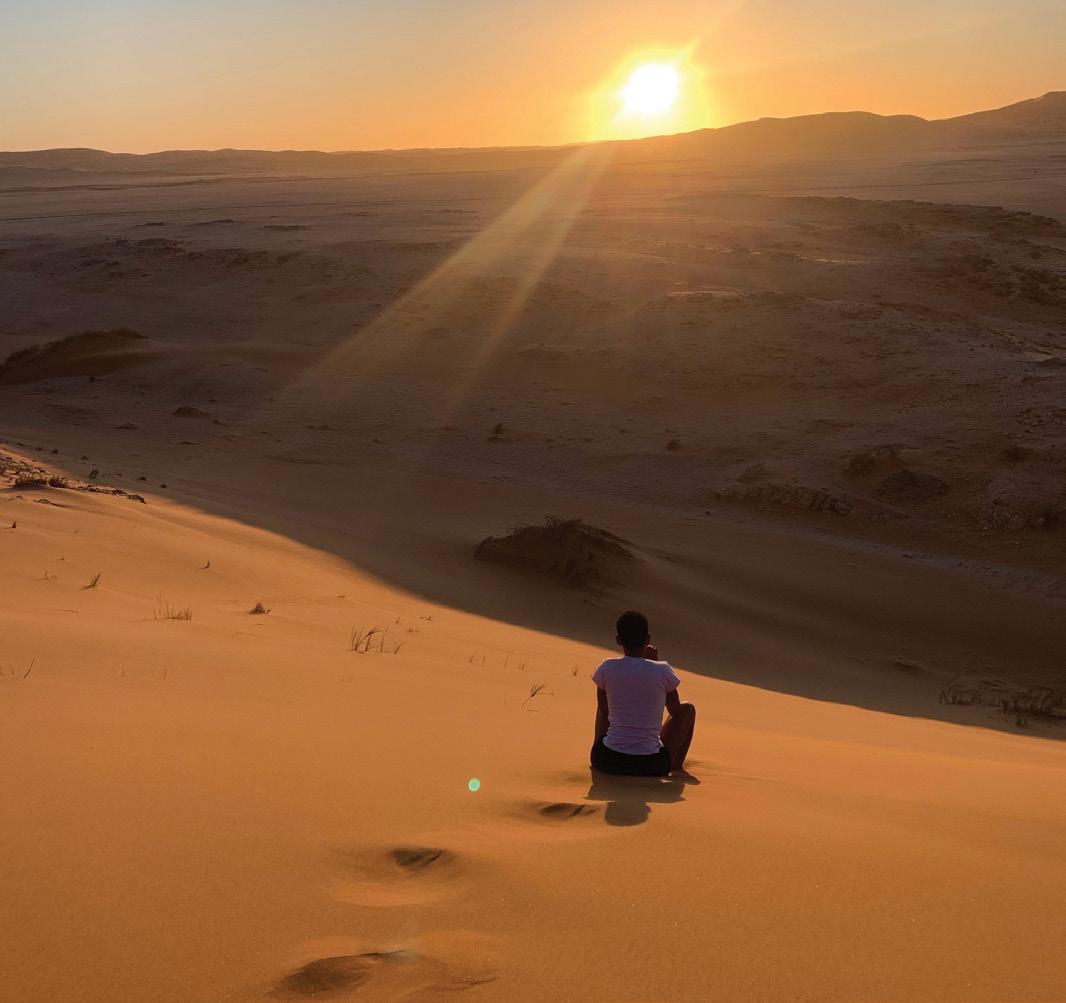
At least once a year – more often if funds are available – NYCE members will have the opportunity to join field excursions to NCE member organisations to learn about their work. These excursions will introduce members to different aspects of environmental conservation and give them a good idea of what to expect if they choose this career path. They can also use their knowledge to educate and inspire people in their own communities to conserve biodiversity and reduce their environmental impact.
As NYCE grows and creates its own institutional identity, it will bring NCE and its members closer to the Namibian youth who want to be involved in the environment. This initiative will ensure the long-term viability of conservation in Namibia, as informed, passionate young people start working towards a sustainable future for their nation.
Visit the NYCE website to find out more: https://youth.conservationnamibia.com/ or scan the QR code.



A membership-based organisation established as a voluntary association to support and promote the interests of environmental NGOs and their work to protect Namibia’s environment, biodiversity and landscapes. The NCE currently has 78 members and associate members, comprising environmental NGOs and individuals running nationally significant environmental projects and programmes.















